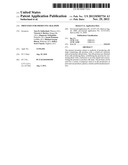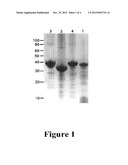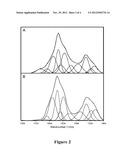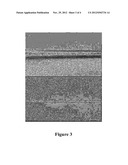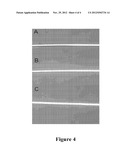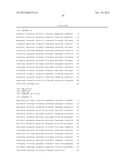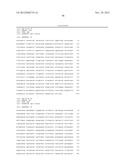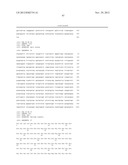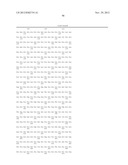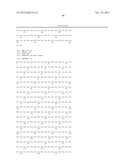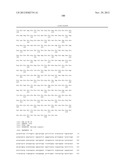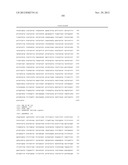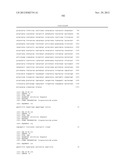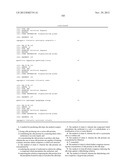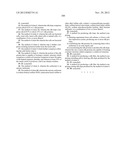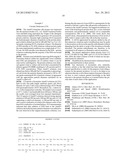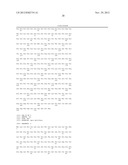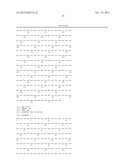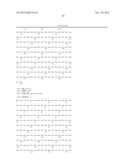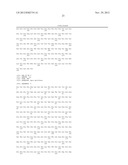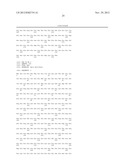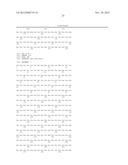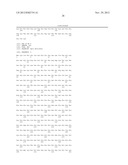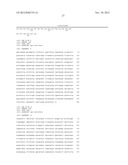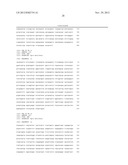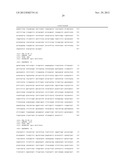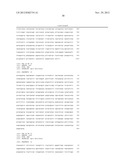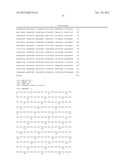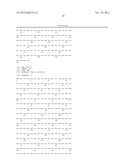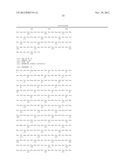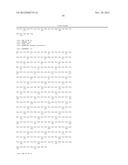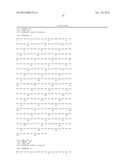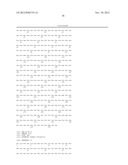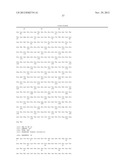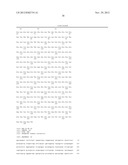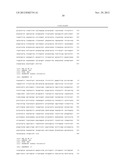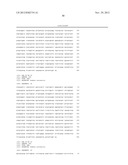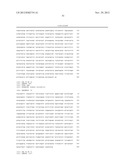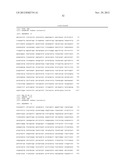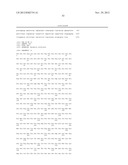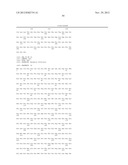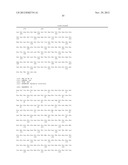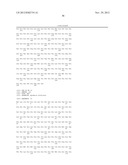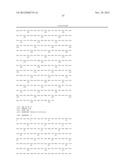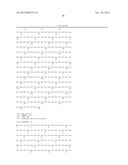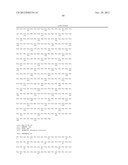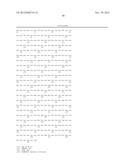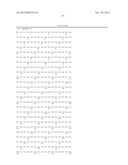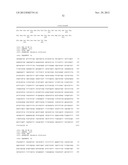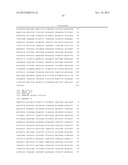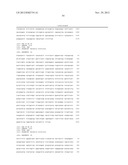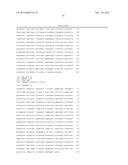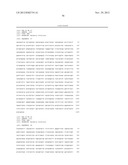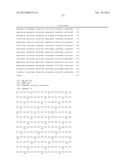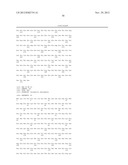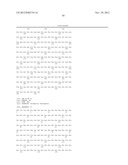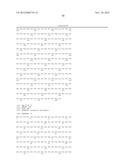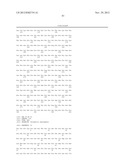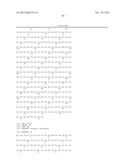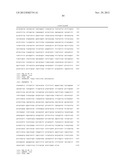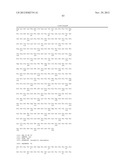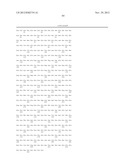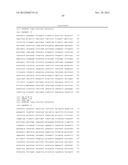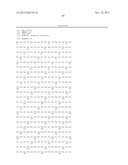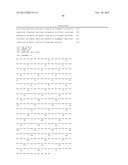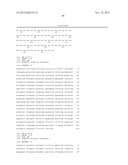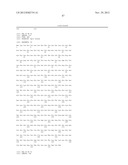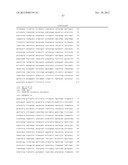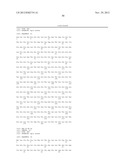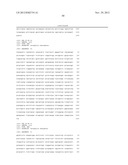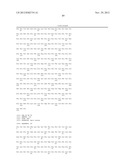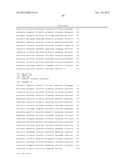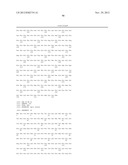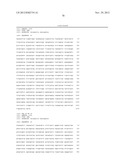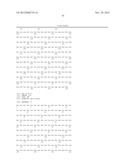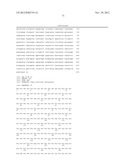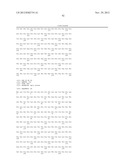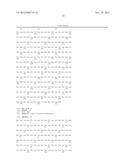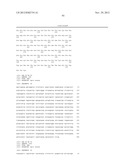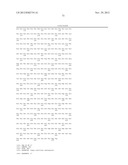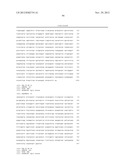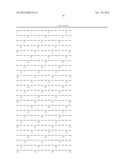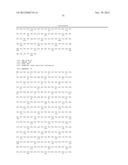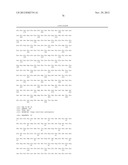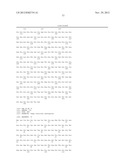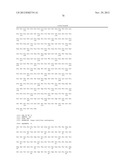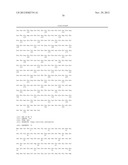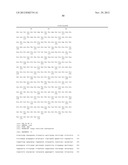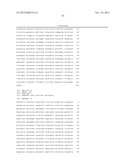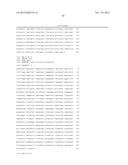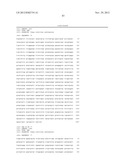Patent application title: Processes for Producing Silk Dope
Inventors:
Tara D. Sutherland (Watson, AU)
Victoria S. Haritos (Kingsville, AU)
Alagacone Sriskantha (Nicholls, AU)
Sarah Weisman (Griffith, AU)
Michael George Huson (Belmont, AU)
Jeffrey Scott Church (Highton, AU)
IPC8 Class: AC07K114FI
USPC Class:
530353
Class name: Chemistry: natural resins or derivatives; peptides or proteins; lignins or reaction products thereof proteins, i.e., more than 100 amino acid residues scleroproteins, e.g., fibroin, elastin, silk, etc.
Publication date: 2012-11-29
Patent application number: 20120302734
Abstract:
The present invention relates to methods of producing silk dope
comprising silk proteins with a coiled-coil structure such as honeybee
silk proteins. The silk proteins are obtained from cells producing them,
solubilising the proteins by contacting them with a surfactant or an
ionic liquid and concentrating the proteins to produce silk dope. The
proteins can be used for a variety of purposes such as in the production
of personal care products, plastics, textiles and biomedical products.Claims:
1. A method for producing silk dope, the method comprising i) lysing
cells producing one or more silk proteins, ii) solubilising the silk
proteins by contacting them with a surfactant or an ionic liquid, and
iii) concentrating the silk proteins to produce silk dope, wherein the
one or more silk proteins are capable of forming a tertiary structure
which comprises a coiled-coil structure.
2. The method of claim 1, wherein the silk proteins are concentrated by a) reducing the amount of surfactant in solution by adding a compound which precipitates the surfactant, and b) separating the solution comprising the silk proteins from the precipitate formed in step a) to produce the silk dope.
3. The method of claim 1, wherein the compound which precipitates the surfactant is a salt or a carbohydrate; or a combination of two or more thereof.
4. The method of claim 3, wherein the salt is a potassium salt or a sodium salt.
5. The method of claim 1, wherein the silk proteins are concentrated by filtration.
6.-7. (canceled)
8. The method of claim 1 which further comprises increasing the concentration of silk proteins in the silk dope.
9. The method of claim 8 which comprises dialysing the silk dope against a dehydrating solution.
10. The method of claim 9, wherein the dehydrating solution comprises a hygroscopic polymer.
11. (canceled)
12. The method of claim 1, wherein the silk dope comprises at least about 0.5% w/v silk proteins.
13. The method of claim 12, wherein the silk dope comprises about 0.5% to about 15% w/v silk proteins.
14. The method of claim 1, wherein the cells are bacterial cells, yeast cells, insect cells, plant cells or animal cells, or a combination of two or more thereof.
15. The method of claim 14, wherein the cells are bacterial cells.
16. The method of claim 1, wherein step i) further comprises isolating inclusion bodies from the lysed cells.
17. The method of claim 1 which further comprises culturing the cells before step i).
18. The method of claim 1, wherein the portion of the silk protein that is capable of forming a tertiary structure which comprises a coiled-coil structure comprises at least 10 copies of the heptad sequence abcdefg, and wherein at least 25% of the amino acids at positions a and d are alanine residues.
19.-23. (canceled)
24. The method of claim 1, wherein the surfactant is an anionic surfactant.
25. The method of claim 24, wherein the anionic surfactant is sodium dodecyl sulfate (SDS), ammonium lauryl sulfate or other alkyl sulfate salts, sodium 1-octanesulfonate monohydrate, sodium lauroyl sarcosinate, sodium lauryl ether sulfate (SLES), sodium taurodeoxycholate hydrate, alkyl benzene sulfonate; or a combination of two or more thereof.
26. (canceled)
27. A method for producing silk dope, the method comprising i) obtaining supernatant from cell cultures, or from a cell-free expression system, producing one or more silk proteins, ii) solubilising the silk proteins by contacting them with a surfactant or an ionic liquid, and iii) concentrating the silk proteins to produce the silk dope, wherein the one or more silk proteins are capable of forming a tertiary structure which comprises a coiled-coil structure.
28.-29. (canceled)
30. A method for producing a silk fibre, the method comprising extruding and/or drawing silk dope produced by the method of claim 1.
31.-33. (canceled)
34. A method for producing a silk film, the method comprising casting silk dope produced by the method of claim 1.
35.-38. (canceled)
Description:
FIELD OF THE INVENTION
[0001] The present invention relates to methods of producing silk dope comprising silk proteins with a coiled-coil structure such as honeybee silk proteins. The silk dope can be used for a variety of purposes such as in the production of personal care products, plastics, textiles, and biomedical products.
BACKGROUND OF THE INVENTION
[0002] Silks are protein fibres produced by a wide range of insect and spider species. The silk of the domesticated silkworm, Bombyx mori, has been used as a suture biomaterial for centuries. Numerous efforts to clone and express silkworm or spider silks in transgenic systems have found it a Herculean task. The large sizes and highly repetitive sequences of these silk genes make them recalcitrant to expression outside specialized silk glands, and lead to low protein yields.
[0003] Although silkworm cocoons and spider webs are the best known silks, other species may produce silks better suited to transgenic production. Honeybee larvae (Apis mellifera) spin silk cocoons in which they pupate. Honeybee silk is encoded by four small (˜30 kDa each) and non-repetitive fibre genes (Sutherland et al., 2006). Homologous sets of four genes have also been found in bumblebees, bulldog ants, weaver ants, hornets and Asiatic honeybees (Sutherland et al., 2007; Sezutsu et al., 2007; Shi et al., 2008; WO 2007/038837).
[0004] Vintage x-ray fibre diffraction work demonstrated that honeybee silk contains α-helical proteins assembled into a coiled-coil conformation, most likely a tetrameric coiled-coil structure (Atkins, 1967), with the four strands likely corresponding to the four different silk proteins. Bioinformatics techniques predict that each of the honeybee silk protein sequences contains 60-68% coiled-coil (Sutherland et al., 2006).
[0005] Silk threads can be hand-drawn from the silk glands of honeybee larvae. These threads are less strong but more extensible and tougher than silkworm silk fibres (Hepburn et al., 1979).
[0006] Shi et al. (2008) recently reported recombinant production of Asiatic honeybee silk (Apis cerana). The four A. cerana silk proteins were expressed in a soluble form in Escherichia coli with yields of 10-60 mg per litre of ferment. A variety of experimental techniques were used to characterize the structure and interactions of the proteins at low concentration (0.03 to 0.2 wt %). These conclusively demonstrated that neither the individual proteins nor a mix of four proteins had tight tertiary packing in solution. The proteins existed as monomers or loosely associated dimers and had predominantly random-coil conformation with little α-helical structure.
[0007] There is a need for further methods to produce silk dope from recombinantly expressed coiled-coil silk proteins which can be used to manufacture a wide variety of products.
SUMMARY OF THE INVENTION
[0008] The present inventors have surprisingly found that surfactants and ionic liquids can be used in a process to produce silk dope comprising coiled-coil silk proteins.
[0009] In a first aspect, the present invention provides a method for producing silk dope, the method comprising
[0010] i) lysing cells producing one or more silk proteins,
[0011] ii) solubilising the silk proteins by contacting them with a surfactant or an ionic liquid, and
[0012] iii) concentrating the silk proteins to produce silk dope,
wherein the one or more silk proteins are capable of forming a tertiary structure which comprises a coiled-coil structure.
[0013] In one embodiment, the silk proteins are concentrated by
[0014] a) reducing the amount of surfactant in solution by adding a compound which precipitates the surfactant, and
[0015] b) separating the solution comprising the silk proteins from the precipitate formed in step a) to produce the silk dope.
[0016] Compounds which can be used to precipitate surfactants are known in the art and include a salt or a carbohydrate; or a combination of two or more thereof. Preferably, the salt is a potassium salt or a sodium salt. In an embodiment, the carbohydrate is α-cyclodextrin.
[0017] In another embodiment, the silk proteins are concentrated by filtration, more preferably membrane filtration, and even more preferably tangential flow filtration.
[0018] In an embodiment, the method further comprises increasing the concentration of silk proteins in the silk dope. This can be achieved by any method known in the art. For example, the silk dope is dialysed against a dehydrating solution such as solution comprising a hygroscopic polymer. Examples of hygroscopic polymers include, but are not limited to, polyethylene glycol, amylase and sericin, as well as a combination of two or more thereof.
[0019] In a preferred embodiment, the silk dope comprises at least about 0.5% w/v silk proteins. In a further embodiment, the silk dope comprises about 0.5% to about 15% silk proteins.
[0020] The cell can be any cell type, typically a recombinant cell comprising an exogenous polynucleotide(s) encoding, and capable of producing, the silk protein(s). Examples include, but are not limited, to bacterial cells, yeast cells, insect cells, plant cells or animal cells, or a combination of two or more thereof. In a preferred embodiment, the cell is a bacterial cell. In a particularly preferred embodiment, the bacterial cell is Escherichia coli.
[0021] In a preferred embodiment, step i) further comprises isolating inclusion bodies from the lysed cells.
[0022] The method may also comprise culturing the cells before step i).
[0023] In a preferred embodiment, the portion of the silk protein that is capable of forming a tertiary structure which comprises a coiled-coil structure comprises at least 10 copies of the heptad sequence abcdefg, and wherein at least 25% of the amino acids at positions a and d are alanine residues. More preferably, at least 25% of the amino acids at positions a, d and e are alanine residues.
[0024] In a further preferred embodiment, the silk protein comprises, more preferably consists essentially of, even more preferably consists of, a sequence selected from:
[0025] a) an amino acid sequence as provided in any one of SEQ ID NOs 1 to 8, 17 to 24, 33 to 40, 49 to 56, 65 to 72, 81 to 88, 97 or 98,
[0026] b) an amino acid sequence which is at least 30% identical to any one or more of SEQ ID NOs 1 to 8, 17 to 24, 33 to 40, 49 to 56, 65 to 72, 81 to 88, 97 or 98, and
[0027] c) a biologically active fragment of a) or b).
[0028] In the above aspect it is preferred that as little as possible of the silk proteins are secreted from the cell. Accordingly, it is preferred that the silk proteins do not comprise an N-terminal signal sequence. Examples of silk proteins particularly useful for the above aspect include, but are not limited to, silk proteins comprising, more preferably consisting essentially of, and even more preferably consisting of, a sequence selected from:
[0029] a) an amino acid sequence as provided in any one of SEQ ID NOs 1, 3, 5, 7, 17, 19, 21, 23, 33, 35, 37, 39, 49, 51, 53, 55, 65, 67, 69, 71, 81, 83, 85, 87 or 97,
[0030] b) an amino acid sequence which is at least 30% identical to any one or more of SEQ ID NOs 1, 3, 5, 7, 17, 19, 21, 23, 33, 35, 37, 39, 49, 51, 53, 55, 65, 67, 69, 71, 81, 83, 85, 87 or 97, and
[0031] c) a biologically active fragment of a) or b).
[0032] In an embodiment, the silk proteins can be a plurality of the same silk protein or a combination of two or more different silk proteins. In a preferred embodiment, if different silk proteins are used there are four different silk proteins.
[0033] In a further embodiment, the silk proteins comprise a first silk protein which comprises, more preferably consists essentially of, even more preferably consists of,
[0034] a) an amino acid sequence as provided in any one of SEQ ID NOs 1, 2, 17, 18, 33, 34, 49, 50, 65, 66, 81 or 82;
[0035] b) an amino acid sequence which is at least 30% identical to any one or more of SEQ ID NOs 1, 2, 17, 18, 33, 34, 49, 50, 65, 66, 81 or 82; and
[0036] c) a biologically active fragment of a) or b),
a second silk protein which comprises, more preferably consists essentially of, even more preferably consists of,
[0037] d) an amino acid sequence as provided in any one of SEQ ID NOs 3, 4, 19, 20, 35, 36, 51, 52, 67, 68, 83 or 84;
[0038] e) an amino acid sequence which is at least 30% identical to any one or more of SEQ ID NOs 3, 4, 19, 20, 35, 36, 51, 52, 67, 68, 83 or 84; and
[0039] f) a biologically active fragment of c) or d),
a third silk protein which comprises, more preferably consists essentially of, even more preferably consists of,
[0040] g) an amino acid sequence as provided in any one of SEQ ID NOs 5, 6, 21, 22, 37, 38, 53, 54, 69, 70, 85 or 86;
[0041] h) an amino acid sequence which is at least 30% identical to any one or more of SEQ ID NOs 5, 6, 21, 22, 37, 38, 53, 54, 69, 70, 85 or 86; and
[0042] i) a biologically active fragment of g) or h), and/or
a fourth silk protein which comprises, more preferably consists essentially of, even more preferably consists of,
[0043] j) an amino acid sequence as provided in any one of SEQ ID NOs 7, 8, 23, 24, 39, 40, 55, 56, 71, 72, 87 or 88;
[0044] k) an amino acid sequence which is at least 30% identical to any one or more of SEQ ID NOs 7, 8, 23, 24, 39, 40, 55, 56, 71, 72, 87 or 88; and
[0045] l) a biologically active fragment of j) or k). More preferably, in relation to above aspect the silk proteins comprise, or consist essentially of, a first silk protein which comprises, more preferably consists essentially of, even more preferably consists of,
[0046] a) an amino acid sequence as provided in any one of SEQ ID NOs 1, 17, 33, 49, 65 or 81;
[0047] b) an amino acid sequence which is at least 30% identical to any one or more of SEQ ID NOs 1, 17, 33, 49, 65 or 81; and
[0048] c) a biologically active fragment of a) or b),
a second silk protein which comprises, more preferably consists essentially of, even more preferably consists of,
[0049] d) an amino acid sequence as provided in any one of SEQ ID NOs 3, 19, 35, 51, 67 or 83;
[0050] e) an amino acid sequence which is at least 30% identical to any one or more of SEQ ID NOs 3, 19, 35, 51, 67 or 83; and
[0051] f) a biologically active fragment of d) or e),
a third silk protein which comprises, more preferably consists essentially of, even more preferably consists of,
[0052] g) an amino acid sequence as provided in any one of SEQ ID NOs 5, 21, 37, 53, 69 or 85;
[0053] h) an amino acid sequence which is at least 30% identical to any one or more of SEQ ID NOs 5, 21, 37, 53, 69 or 85; and
[0054] i) a biologically active fragment of g) or h), and/or
a fourth silk protein which comprises, more preferably consists essentially of, even more preferably consists of,
[0055] j) an amino acid sequence as provided in any one of SEQ ID NOs 7, 23, 39, 55, 71 or 87;
[0056] k) an amino acid sequence which is at least 30% identical to any one or more of SEQ ID NOs 7, 23, 39, 55, 71 or 87; and
[0057] l) a biologically active fragment of j) or k).
[0058] In an embodiment, the first silk protein, second silk protein, third silk protein and/or fourth silk protein are produced by the same cells.
[0059] In an alternate embodiment, the first silk protein, second silk protein, third silk protein and/or fourth silk protein are produced by different cells. In this embodiment, it is preferred that step ii) comprises approximate equimolar amounts of the first silk protein, the second silk protein, the third silk protein and the fourth silk protein.
[0060] At any point up until and excluding step iii) the silk proteins processed according to the invention may be prepared independently and combined. The separately prepared silk proteins can be the same or different. For example, a first silk protein as defined herein is expressed in a first cell and processed as defined in steps i) and ii), a second silk protein as defined herein is expressed in a second cell and processed as defined in steps i) and ii), and then the two solutions combined before step iii) is performed.
[0061] The surfactant and ionic liquid solubilise precipitated protein and enables the silk protein to stay in solution whilst allowing the formation of a coiled-coil structure during later steps.
[0062] In a preferred embodiment, the surfactant is an anionic surfactant. Examples of anionic surfactants useful for the invention include, but are not limited to, sodium dodecyl sulfate (SDS), ammonium lauryl sulfate and other alkyl sulfate salts, sodium 1-octanesulfonate monohydrate, sodium lauroyl sarcosinate, sodium lauryl ether sulfate (SLES), sodium taurodeoxycholate hydrate, and alkyl benzene sulfonate; as well as a combination of two or more thereof. In a preferred embodiment, the anionic surfactant is SDS.
[0063] In an embodiment, the ionic liquid comprises
[0064] i) an anion selected from chloride, bromide, iodide, thiocyanate, acetate, C1-C4-alkylsulfates, methanesulfonates, tosylate, C1-C4-dialkylphosphates, hydrogensulfate and tetrachloroaluminate, and
[0065] ii) a cation selected from 1,3-C1-C4-dialkylimidazolium, 3-chloropyridinium, 4-dimethylaminopyridinium, 2-ethyl-4-aminopyridinium, 2-methylpyridinium, 2-ethylpyridinium, 2-ethyl-6-methylpyridinium, quinolinium, isoquinolinium, pyridinium, 1-C1-C4-alkylimidazolium, 1-methylimidazolium, 1,2-dimethylimidazolium, 1-n-butyl-imidazolium, 1,4,5-trimethylimidazolium, 1,4-dimethylimidazolium, imidazolium, 2-methylimidazolium, 1-butyl-2-methylimidazolium, 4 methylimidazolium, 1-(2'-aminoethyl)imidazolium, 1-vinylimidazolium, 2-ethylimidazolium and benzotriazolium.
[0066] In a further preferred embodiment, the method yields at least about 0.1 g, more preferably at least about 1 g, more preferably at least about 1.5 g, more preferably at least about 2 g, even more preferably at least about 2.5 g. of silk protein(s) per litre of cultured cells.
[0067] In another aspect, the present invention provides a method for producing silk dope, the method comprising
[0068] i) obtaining supernatant from cell cultures, or from a cell-free expression system, producing one or more silk proteins,
[0069] ii) solubilising the silk proteins by contacting them with a surfactant or an ionic liquid, and
[0070] iii) concentrating the silk proteins to produce the silk dope,
wherein the one or more silk proteins are capable of forming a tertiary structure which comprises a coiled-coil structure.
[0071] In this aspect, instead of the silk proteins in the cell being used to produce the silk dope, silk proteins which are secreted from the cells are used. As the skilled addressee will appreciate, step i) of the first aspect and step i) of the above aspect may be performed simultaneously or sequentially. Furthermore, at any corresponding step silk proteins derived from the cell and the supernatant could be combined and from thereon processed together. For example, step ii) of the first aspect and step ii) of the above aspect can be performed separately and the silk proteins combined for further processing including steps iii) and iv).
[0072] In a particularly preferred embodiment of the above aspect, step i) further comprises increasing the concentration of silk proteins from the supernatant. This can be achieved by any method known in the art, for example by contacting the supernatant with an agent which precipitates the silk proteins such as, but not limited to, ammonium sulfate, trichloroacetic acid, perchloric acid and acetone.
[0073] In relation to the above aspect it is preferred that as much as possible of the silk proteins are secreted from the cell. Accordingly, it is preferred that the silk proteins comprise an N-terminal signal sequence. Examples of silk proteins particularly useful for the above aspect include, but are not limited to, silk proteins comprising, more preferably consisting essentially of, and even more preferably consisting of, a sequence selected from:
[0074] a) an amino acid sequence as provided in any one of SEQ ID NOs 2, 4, 6, 8, 18, 20, 22, 24, 34, 36, 38, 40, 50, 52, 54, 56, 66, 68, 70, 72, 82, 84, 86, 88 or 98,
[0075] b) an amino acid sequence which is at least 30% identical to any one or more of SEQ ID NOs 2, 4, 6, 8, 18, 20, 22, 24, 34, 36, 38, 40, 50, 52, 54, 56, 66, 68, 70, 72, 82, 84, 86, 88 or 98, and
[0076] c) a biologically active fragment of a) or b).
[0077] In a further embodiment, the silk proteins comprise a first silk protein which comprises, more preferably consists essentially of, even more preferably consists of,
[0078] a) an amino acid sequence as provided in any one of SEQ ID NOs 2, 18, 34, 50, 66 or 82;
[0079] b) an amino acid sequence which is at least 30% identical to any one or more of SEQ ID NOs 2, 18, 34, 50, 66 or 82; and
[0080] c) a biologically active fragment of a) or b),
a second silk protein which comprises, more preferably consists essentially of, even more preferably consists of,
[0081] d) an amino acid sequence as provided in any one of SEQ ID NOs 4, 20, 36, 52, 68 or 84;
[0082] e) an amino acid sequence which is at least 30% identical to any one or more of SEQ ID NOs 4, 20, 36, 52, 68 or 84; and
[0083] f) a biologically active fragment of c) or d),
a third silk protein which comprises, more preferably consists essentially of, even more preferably consists of,
[0084] g) an amino acid sequence as provided in any one of SEQ ID NOs 6, 22, 38, 54, 70 or 86;
[0085] h) an amino acid sequence which is at least 30% identical to any one or more of SEQ ID NOs 6, 22, 38, 54, 70 or 86; and
[0086] i) a biologically active fragment of g) or h), and/or
a fourth silk protein which comprises, more preferably consists essentially of, even more preferably consists of,
[0087] j) an amino acid sequence as provided in any one of SEQ ID NOs 8, 24, 40, 56, 72 or 88;
[0088] k) an amino acid sequence which is at least 30% identical to any one or more of SEQ ID NOs 8, 24, 40, 56, 72 or 88; and
[0089] l) a biologically active fragment of j) or k).
[0090] In a further aspect, the present invention provides a method for producing a silk fibre, the method comprising extruding and/or drawing silk dope produced by a method of the invention.
[0091] In an embodiment, the extruding comprises passing the silk dope through an about 5 μm to about 500 μm capillary tube.
[0092] In a particularly preferred embodiment, the method comprises
[0093] i) lysing cells producing one or more silk proteins and isolating inclusion bodies from the cells,
[0094] ii) solubilising the silk proteins in the inclusion bodies by contacting them with a surfactant or an ionic liquid,
[0095] iii) concentrating the silk proteins to produce silk dope,
[0096] iv) increasing the concentration of silk proteins in the silk dope to about 2% to about 10% wt(%) silk proteins, more preferably about 3% to about 6% wt(%) silk proteins, and
[0097] vi) extruding the silk dope in a dehydrating solution.
[0098] In relation to the above embodiment, the dehydrating solution preferably comprises an alcohol such as methanol or ethanol, or a high concentration of salt such as MgCl2 or NaCl. Extruding silk fibres under these conditions is generally known in the art as wet spinning.
[0099] Preferably, the alcohol is methanol and the concentration of the methanol in the solution is about 40% to about 80% v/v, more preferably about 50% to about 70% v/v. In this embodiment, the silk dope may comprise a single type of silk polypeptide as defined herein, or two, or more different types such as four different types.
[0100] In another aspect, the present invention provides a method for producing a silk film, wherein the method comprising casting silk dope produced by a method of the invention.
[0101] In another aspect, the present invention provides silk dope produced by a method of the invention.
[0102] In a further aspect, the present invention provides a silk fibre produced by a method of the invention.
[0103] Also provided is a silk film produced by a method of the invention.
[0104] In yet another aspect, the present invention provides a product comprising a silk fibre and/or silk film of the invention.
[0105] As will be apparent, preferred features and characteristics of one aspect of the invention are applicable to many other aspects of the invention.
[0106] Throughout this specification the word "comprise", or variations such as "comprises" or "comprising", will be understood to imply the inclusion of a stated element, integer or step, or group of elements, integers or steps, but not the exclusion of any other element, integer or step, or group of elements, integers or steps.
[0107] The invention is hereinafter described by way of the following non-limiting Examples and with reference to the accompanying figures.
BRIEF DESCRIPTION OF THE ACCOMPANYING DRAWINGS
[0108] FIG. 1. SDS-PAGE of purified inclusion bodies solubilised in SDS. Lanes correspond to recombinant proteins AmelF1-4; scale is protein weight in kDa.
[0109] FIG. 2. Fourier self deconvolution of the amide I and II regions of the infrared spectra of native honeybee silk (A) and recombinant honeybee silk (B). Assignments of bands to structures are found in Table 2.
[0110] FIG. 3. Cross-polarized microscopy of recombinant honeybee silk fibres (A) drawn in air, and (B) drawn in air then drawn a second time in methanol.
[0111] FIG. 4. Cross-polarized microscopy of recombinant honeybee silk fibres (A) extruded into methanol bath, and (B) air dried then drawn a second time in a methanol bath to x2 length or (C) air dried then drawn a second time in a methanol bath to x4 length.
KEY TO THE SEQUENCE LISTING
[0112] SEQ ID NO:1--Honeybee silk protein termed herein Xenospira1 (also termed herein AmelF1) (minus signal peptide). [0113] SEQ ID NO:2--Honeybee silk protein termed herein Xenospira1. [0114] SEQ ID NO:3--Honeybee silk protein termed herein Xenospira2 (also termed herein AmelF2) (minus signal peptide). [0115] SEQ ID NO:4--Honeybee silk protein termed herein Xenospira2. [0116] SEQ ID NO:5--Honeybee silk protein termed herein Xenospira3 (also termed herein AmelF3) (minus signal peptide). [0117] SEQ ID NO:6--Honeybee silk protein termed herein Xenospira3. [0118] SEQ ID NO:7--Honeybee silk protein termed herein Xenospira4 (also termed herein AmelF4) (minus signal peptide). [0119] SEQ ID NO:8--Honeybee silk protein termed herein Xenospira4. [0120] SEQ ID NO:9--Nucleotide sequence encoding honeybee silk protein Xenospira1 (minus region encoding signal peptide). [0121] SEQ ID NO:10--Nucleotide sequence encoding honeybee silk protein Xenospira1. [0122] SEQ ID NO:11--Nucleotide sequence encoding honeybee silk protein Xenospira2 (minus region encoding signal peptide). [0123] SEQ ID NO:12--Nucleotide sequence encoding honeybee silk protein Xenospira2. [0124] SEQ ID NO:13--Nucleotide sequence encoding honeybee silk protein Xenospira3 (minus region encoding signal peptide). [0125] SEQ ID NO:14--Nucleotide sequence encoding honeybee silk protein Xenospira3. [0126] SEQ ID NO:15--Nucleotide sequence encoding honeybee silk protein Xenospira4 (minus region encoding signal peptide). [0127] SEQ ID NO:16--Nucleotide sequence encoding honeybee silk protein Xenospira4. [0128] SEQ ID NO:17--Bumblebee silk protein termed herein BBF1 (minus signal peptide). [0129] SEQ ID NO:18--Bumblebee silk protein termed herein BBF1. [0130] SEQ ID NO:19--Bumblebee silk protein termed herein BBF2 (minus signal peptide). [0131] SEQ ID NO:20--Bumblebee silk protein termed herein BBF2. [0132] SEQ ID NO:21--Bumblebee silk protein termed herein BBF3 (minus signal peptide). [0133] SEQ ID NO:22--Bumblebee silk protein termed herein BBF3. SEQ ID NO:23--Bumblebee silk protein termed herein BBF4 (minus signal peptide). [0134] SEQ ID NO:24--Bumblebee silk protein termed herein BBF4. [0135] SEQ ID NO:25--Nucleotide sequence encoding bumblebee silk protein BBF1 (minus region encoding signal peptide). [0136] SEQ ID NO:26--Nucleotide sequence encoding bumblebee silk protein BBF1. [0137] SEQ ID NO:27--Nucleotide sequence encoding bumblebee silk protein BBF2 (minus region encoding signal peptide). [0138] SEQ ID NO:28--Nucleotide sequence encoding bumblebee silk protein BBF2. [0139] SEQ ID NO:29--Nucleotide sequence encoding bumblebee silk protein BBF3 (minus region encoding signal peptide). [0140] SEQ ID NO:30--Nucleotide sequence encoding bumblebee silk protein BBF3. [0141] SEQ ID NO:31--Nucleotide sequence encoding bumblebee silk protein BBF4 (minus region encoding signal peptide). [0142] SEQ ID NO:32--Nucleotide sequence encoding bumblebee silk protein BBF4. [0143] SEQ ID NO:33--Bulldog ant silk protein termed herein BAF1 (minus signal peptide). [0144] SEQ ID NO:34--Bulldog ant silk protein termed herein BAF1. [0145] SEQ ID NO:35--Bulldog ant silk protein termed herein BAF2 (minus signal peptide). [0146] SEQ ID NO:36--Bulldog ant silk protein termed herein BAF2. [0147] SEQ ID NO:37--Bulldog ant silk protein termed herein BAF3 (minus signal peptide). [0148] SEQ ID NO:38--Bulldog ant silk protein termed herein BAF3. [0149] SEQ ID NO:39--Bulldog ant silk protein termed herein BAF4 (minus signal peptide). [0150] SEQ ID NO:40--Bulldog ant silk protein termed herein BAF4. [0151] SEQ ID NO:41--Nucleotide sequence encoding bulldog ant silk protein BAF1 (minus region encoding signal peptide). [0152] SEQ ID NO:42--Nucleotide sequence encoding bulldog ant silk protein BAF1. [0153] SEQ ID NO:43--Nucleotide sequence encoding bulldog ant silk protein BAF2 (minus region encoding signal peptide). [0154] SEQ ID NO:44--Nucleotide sequence encoding bulldog ant silk protein BAF2. [0155] SEQ ID NO:45--Nucleotide sequence encoding bulldog ant silk protein BAF3 (minus region encoding signal peptide). [0156] SEQ ID NO:46--Nucleotide sequence encoding bulldog ant silk protein BAF3. [0157] SEQ ID NO:47--Nucleotide sequence encoding bulldog ant silk protein BAF4 (minus region encoding signal peptide). [0158] SEQ ID NO:48--Nucleotide sequence encoding bulldog ant silk protein BAF4. [0159] SEQ ID NO:49--Weaver ant silk protein termed herein GAF1 (minus signal peptide). [0160] SEQ ID NO:50--Weaver ant silk protein termed herein GAF1. [0161] SEQ ID NO:51--Weaver ant silk protein termed herein GAF2 (minus signal peptide). [0162] SEQ ID NO:52--Weaver ant silk protein termed herein GAF2. [0163] SEQ ID NO:53--Weaver ant silk protein termed herein GAF3 (minus signal peptide). [0164] SEQ ID NO:54--Weaver ant silk protein termed herein GAF3. [0165] SEQ ID NO:55--Weaver ant silk protein termed herein GAF4 (minus signal peptide). [0166] SEQ ID NO:56--Weaver ant silk protein termed herein GAF4. [0167] SEQ ID NO:57--Nucleotide sequence encoding weaver ant silk protein GAF1 (minus region encoding signal peptide). [0168] SEQ ID NO:58--Nucleotide sequence encoding weaver ant silk protein GAF1. [0169] SEQ ID NO:59--Nucleotide sequence encoding weaver ant silk protein GAF2 (minus region encoding signal peptide). [0170] SEQ ID NO:60--Nucleotide sequence encoding weaver ant silk protein GAF2. [0171] SEQ ID NO:61--Nucleotide sequence encoding weaver ant silk protein GAF3 (minus region encoding signal peptide). [0172] SEQ ID NO:62--Nucleotide sequence encoding weaver ant silk protein GAF3. [0173] SEQ ID NO:63--Nucleotide sequence encoding weaver ant silk protein GAF4 (minus region encoding signal peptide). [0174] SEQ ID NO:64--Nucleotide sequence encoding weaver ant silk protein GAF4. [0175] SEQ ID NO:65--Hornet silk protein termed herein Vssilk3 (minus signal peptide). [0176] SEQ ID NO:66--Hornet silk protein termed herein Vssilk3. [0177] SEQ ID NO:67--Hornet silk protein termed herein Vssilk4 (minus signal peptide). [0178] SEQ ID NO:68--Hornet silk protein termed herein Vssilk4. [0179] SEQ ID NO:69--Hornet silk protein termed herein Vssilk2 (minus signal peptide). [0180] SEQ ID NO:70--Hornet silk protein termed herein Vssilk2. [0181] SEQ ID NO:71--Hornet silk protein termed herein Vssilk1 (minus signal peptide). [0182] SEQ ID NO:72--Hornet silk protein termed herein Vssilk1. [0183] SEQ ID NO:73--Nucleotide sequence encoding hornet silk protein Vssilk3 (minus region encoding signal peptide). [0184] SEQ ID NO:74--Nucleotide sequence encoding hornet silk protein Vssilk3. [0185] SEQ ID NO:75--Nucleotide sequence encoding hornet silk protein Vssilk4 (minus region encoding signal peptide). [0186] SEQ ID NO:76--Nucleotide sequence encoding hornet silk protein Vssilk4. [0187] SEQ ID NO:77--Nucleotide sequence encoding hornet silk protein Vssilk2 (minus region encoding signal peptide). [0188] SEQ ID NO:78--Nucleotide sequence encoding hornet silk protein Vssilk2. [0189] SEQ ID NO:79--Nucleotide sequence encoding hornet silk protein Vssilk1 (minus region encoding signal peptide). [0190] SEQ ID NO:80--Nucleotide sequence encoding hornet silk protein Vssilk1. [0191] SEQ ID NO:81--Asiatic honeybee silk protein termed silk protein 1 (also termed ABS1) (minus signal peptide). [0192] SEQ ID NO:82--Asiatic honeybee silk protein termed silk protein 1 (also termed ABS1). [0193] SEQ ID NO:83--Asiatic honeybee silk protein termed silk protein 2 (also termed ABS2) (minus signal peptide). [0194] SEQ ID NO:84--Asiatic honeybee silk protein termed silk protein 2 (also termed ABS2). [0195] SEQ ID NO:85--Asiatic honeybee silk protein termed silk protein 3 (also termed ABS3) (minus signal peptide). [0196] SEQ ID NO:86--Asiatic honeybee silk protein termed silk protein 3 (also termed ABS3). [0197] SEQ ID NO:87--Asiatic honeybee silk protein termed silk protein 4 (also termed ABS4) (minus signal peptide). [0198] SEQ ID NO:88--Asiatic honeybee silk protein termed silk protein 4 (also termed ABS4). [0199] SEQ ID NO:89--Nucleotide sequence encoding asiatic honeybee silk protein ABS1 (minus region encoding signal peptide). [0200] SEQ ID NO:90--Nucleotide sequence encoding asiatic honeybee silk protein ABS1. [0201] SEQ ID NO:91--Nucleotide sequence encoding asiatic honeybee silk protein ABS2 (minus region encoding signal peptide). [0202] SEQ ID NO:92--Nucleotide sequence encoding asiatic honeybee silk protein ABS2. [0203] SEQ ID NO:93--Nucleotide sequence encoding asiatic honeybee silk protein ABS3 (minus region encoding signal peptide). [0204] SEQ ID NO:94--Nucleotide sequence encoding asiatic honeybee silk protein ABS3. [0205] SEQ ID NO:95--Nucleotide sequence encoding asiatic honeybee silk protein ABS4 (minus region encoding signal peptide). [0206] SEQ ID NO:96--Nucleotide sequence encoding asiatic honeybee silk protein ABS4. [0207] SEQ ID NO:97--Lacewing silk protein termed herein MalF1 (minus signal peptide). [0208] SEQ ID NO:98--Lacewing silk protein termed herein MalF1. [0209] SEQ ID NO:99--Nucleotide sequence encoding lacewing silk protein MalF1 (minus region encoding signal peptide). [0210] SEQ ID NO:100--Nucleotide sequence encoding lacewing silk protein MalF1. [0211] SEQ ID NOs 101 to 108--Oligonucleotide primers.
DETAILED DESCRIPTION OF THE INVENTION
General Techniques and Definitions
[0212] Unless specifically defined otherwise, all technical and scientific terms used herein shall be taken to have the same meaning as commonly understood by one of ordinary skill in the art (e.g., in cell culture, molecular genetics, silk processing, immunology, immunohistochemistry, protein chemistry, and biochemistry).
[0213] Unless otherwise indicated, the recombinant protein, cell culture, and immunological techniques utilized in the present invention are standard procedures, well known to those skilled in the art. Such techniques are described and explained throughout the literature in sources such as, J. Perbal, A Practical Guide to Molecular Cloning, John Wiley and Sons (1984), J. Sambrook et al., Molecular Cloning: A Laboratory Manual, Cold Spring Harbour Laboratory Press (1989), T. A. Brown (editor), Essential Molecular Biology: A Practical Approach, Volumes 1 and 2, IRL Press (1991), D. M. Glover and B. D. Hames (editors), DNA Cloning: A Practical Approach, Volumes 1-4, IRL Press (1995 and 1996), and F. M. Ausubel et al. (editors), Current Protocols in Molecular Biology, Greene Pub. Associates and Wiley-Interscience (1988, including all updates until present), Ed Harlow and David Lane (editors) Antibodies: A Laboratory Manual, Cold Spring Harbour Laboratory, (1988), and J. E. Coligan et al. (editors) Current Protocols in Immunology, John Wiley & Sons (including all updates until present).
[0214] The term "and/or", e.g., "X and/or Y" shall be understood to mean either "X and Y" or "X or Y" and shall be taken to provide explicit support for both meanings or for either meaning.
[0215] As used herein, the terms "silk protein" and "silk polypeptide" refer to a fibrous protein/polypeptide that can be used to produce a silk fibre, and/or a fibrous protein complex.
[0216] As used herein, the term "one or more silk proteins" refers to the process possibly using two or more different types of silk proteins such as a first silk protein, second silk protein, etc, as defined herein. Thus, in this context one silk protein means a population of identical silk protein molecules sufficient to produce silk dope.
[0217] As used herein, the term "capable of forming a tertiary structure which comprises a coiled-coil structure" refers to the ability of the proteins to form said structures under suitable conditions. For example, when processed to produce silk fibres the proteins form said structures. Furthermore, this term does not mean that the entire protein is capable of forming a coiled-coil structure, just a portion thereof. In an embodiment, about 45% to about 90%, more preferably about 55% to about 70%, and even more preferably about 60% to about 66%, of the silk protein is capable of forming a tertiary structure which comprises a coiled-coil structure.
[0218] As used herein, the term "silk dope" refers to an aqueous solution comprising silk proteins. Preferably, the silk dope comprises at least 0.05% w/v, more preferably at least 0.1% w/v, and even more preferably at least 0.5% w/v, of a silk protein as defined herein. In an embodiment, silk dope produced by a method of the invention comprises about 0.5% to about 15% (wt %) silk protein. However, if the further step of increasing the concentration of silk proteins in the silk dope is not performed the more typical yield is about 0.5% to about 4% (wt %) silk protein. Silk dope produced using a method of the invention is amenable to extrusion for the formation of a fibre and/or film casting.
[0219] As used herein, a "silk fibre" refers to filaments comprising silk proteins which can be woven into various items such as textiles.
[0220] As used herein, the term "reducing the amount of surfactant solution", or variations thereof including reducing the amount of ionic liquid, means that the total amount of surfactant or ionic liquid is decreased. In an embodiment, the concentration of surfactant or ionic liquid following the reduction is less than about 10 mM, more preferably less than 5 mM and even more preferably less than 1 mM, prior to any step involving further concentration of the solution.
[0221] As used herein, a "dehydrating solution" is any solution, preferably an aqueous solution, that has a lower water concentration in solution than the silk dope that is to be concentrated.
[0222] As used herein, the term "solubilising" when referring to the silk proteins being contacted with a surfactant or ionic liquid means that the surfactant or ionic liquid associates with the silk proteins and maintains them in solution by preventing their aggregation. This is contrast to silk proteins seen in the cells, especially in the inclusion bodies.
[0223] The term "signal peptide", "N-terminal signal sequence" and variations thereof refers to an amino terminal protein/peptide preceding a secreted mature protein. The signal peptide is cleaved from and is therefore not present in the mature protein. Signal peptides have the function of directing and trans-locating secreted proteins across cell membranes. The signal peptide is also referred to as signal sequence, and are well known in the art
Coiled-Coil Silk Proteins
[0224] The terms "polypeptide" and "protein" are generally used interchangeably and refer to a single polypeptide chain which may or may not be modified by addition of non-amino acid groups. The terms "proteins" and "polypeptides" as used herein also include variants, mutants, modifications, analogous and/or derivatives of the silk proteins described herein. In a preferred embodiment, a silk protein used in the invention is only comprised of naturally occurring amino acids.
[0225] The % identity of a protein is determined by GAP (Needleman and Wunsch, 1970) analysis (GCG program) with a gap creation penalty=5, and a gap extension penalty=0.3. The query sequence is at least 15 amino acids in length, and the GAP analysis aligns the two sequences over a region of at least 15 amino acids. More preferably, the query sequence is at least 50 amino acids in length, and the GAP analysis aligns the two sequences over a region of at least 50 amino acids. More preferably, the query sequence is at least 100 amino acids in length and the GAP analysis aligns the two sequences over a region of at least 100 amino acids. Even more preferably, the query sequence is at least 250 amino acids in length and the GAP analysis aligns the two sequences over a region of at least 250 amino acids. Even more preferably, the GAP analysis aligns the two sequences over their entire length.
[0226] As used herein a "biologically active" fragment is a portion of a protein of the invention which maintains a defined activity of the full-length protein, namely the ability to be used to produce silk. Biologically active fragments can be any size as long as they maintain the defined activity.
[0227] The term "consisting essentially of", or variations thereof, means that the defined amino acid sequence may have a few, such as one, two, three or four, additional amino acids compared to that defined. For example, when absent from the defined sequence an N-terminal methionine may be added. The term "consists of", or variations thereof, means that the defined sequence does not have additional or less amino acids when compared to the defined sequence, particularly at the N- and C-termini.
[0228] With regard to a defined protein, it will be appreciated that % identity figures higher than those provided above will encompass preferred embodiments. Thus, where applicable, in light of the minimum % identity figures, it is preferred that the protein comprises an amino acid sequence which is at least 40%, more preferably at least 45%, more preferably at least 50%, more preferably at least 55%, more preferably at least 60%, more preferably at least 65%, more preferably at least 70%, more preferably at least 75%, more preferably at least 80%, more preferably at least 85%, more preferably at least 90%, more preferably at least 91%, more preferably at least 92%, more preferably at least 93%, more preferably at least 94%, more preferably at least 95%, more preferably at least 96%, more preferably at least 97%, more preferably at least 98%, more preferably at least 99%, more preferably at least 99.1%, more preferably at least 99.2%, more preferably at least 99.3%, more preferably at least 99.4%, more preferably at least 99.5%, more preferably at least 99.6%, more preferably at least 99.7%, more preferably at least 99.8%, and even more preferably at least 99.9% identical to the relevant nominated SEQ ID NO.
[0229] Amino acid sequence mutants of the naturally occurring silk proteins described herein can be prepared by introducing appropriate nucleotide changes into a nucleic acid encoding the silk protein, or by in vitro synthesis of the desired protein. Such mutants include, for example, deletions, insertions or substitutions of residues within the amino acid sequence. A combination of deletion, insertion and substitution can be made to arrive at the final construct, provided that the final protein product possesses the desired characteristics.
[0230] Mutant (altered) proteins can be prepared using any technique known in the art. For example, a polynucleotide of the invention can be subjected to in vitro mutagenesis. Such in vitro mutagenesis techniques include sub-cloning the polynucleotide into a suitable vector, transforming the vector into a "mutator" strain such as the E. coli XL-1 red (Stratagene) and propagating the transformed bacteria for a suitable number of generations. In another example, the polynucleotides of the invention are subjected to DNA shuffling techniques as broadly described by Harayama (1998). These DNA shuffling techniques may include genes of the invention possibly in addition to genes related to those of the present invention, such as silk genes from Hymenopteran or Neuroptean species other than the specific species characterized herein. Products derived from mutated/altered DNA can readily be screened using techniques described herein to determine if they can be used as silk proteins.
[0231] In designing amino acid sequence mutants, the location of the mutation site and the nature of the mutation will depend on characteristic(s) to be modified. The sites for mutation can be modified individually or in series, e.g., by (1) substituting first with conservative amino acid choices and then with more radical selections depending upon the results achieved, (2) deleting the target residue, or (3) inserting other residues adjacent to the located site.
[0232] Amino acid sequence deletions or insertions generally range from about 1 to 15 residues, more preferably about 1 to 10 residues and typically about 1 to 5 contiguous residues.
[0233] Substitution mutants have at least one amino acid residue in the protein molecule removed and a different residue inserted in its place. The sites of greatest interest for substitutional mutagenesis include sites identified as important for function. Other sites of interest are those in which particular residues obtained from various strains or species are identical. These positions may be important for biological activity. These sites, especially those falling within a sequence of at least three other identically conserved sites, are preferably substituted in a relatively conservative manner. Such conservative substitutions are shown in Table 1 under the heading of "exemplary substitutions".
TABLE-US-00001 TABLE 1 Exemplary substitutions Original Exemplary Residue Substitutions Ala (A) val; leu; ile; gly; cys; ser; thr Arg (R) lys Asn (N) gln; his Asp (D) glu Cys (C) ser; thr; ala; gly; val Gln (Q) asn; his Glu (E) asp Gly (G) pro; ala; ser; val; thr; cyc His (H) asn; gln Ile (I) leu; val; ala; met Leu (L) ile; val; met; ala; phe Lys (K) arg Met (M) leu; phe Phe (F) leu; val; ala Pro (P) gly Ser (S) thr; ala; gly; val; gln; cys Thr (T) ser; gln; ala; cys Trp (W) tyr Tyr (Y) trp; phe Val (V) ile; leu; met; phe; ala; ser; thr
[0234] Coiled-coil structures of silk proteins are characterized by heptad repeats represented by the consensus sequence (abcdefg)n. In a preferred embodiment, the portion of the protein that has a coiled-coil structure comprises at least 10 copies of the heptad sequence abcdefg, and at least 25% of the amino acids at positions a and d are alanine residues.
[0235] In a preferred embodiment, the protein that has a coiled-coil structure comprises at least 12 consecutive copies, more preferably at least 15 consecutive copies, and even more preferably at least 18 consecutive copies of the heptad. In further embodiments, the protein that has a coiled-coil structure can have up to at least 28 copies of the heptad. Typically, the copies of the heptad will be tandemly repeated. However, they do not necessarily have to be perfect tandem repeats, for example, as shown in FIGS. 5 and 6 of WO 2007/038837 a few amino acids may be found between two heptads, or a few truncated heptads may be found (see, for example, Xenospira1 in FIG. 5 of WO 2007/038837).
[0236] Guidance regarding amino acid substitutions which can be made to the silk proteins which have a coiled-coil structure is provided in FIGS. 5 and 6, as well as Tables 6 to 10, of WO 2007/038837. Where a predicted useful amino acid substitution based on the experimental data provided herein is in anyway in conflict with the exemplary substitutions provided in Table 1 of WO 2007/038837 it is preferred that a substitution based on the experimental data is used.
[0237] Coiled-coil structures of the silk proteins have a high content of alanine residues, particularly at amino acid positions a, d and e of the heptad. However, positions b, c, f and g also have a high frequency of alanine residues. In a preferred embodiment, at least 15% of the amino acids at positions a, d and/or e of the heptads are alanine residues, more preferably at least 25%, more preferably at least 30%, more preferably at least 40%, and even more preferably at least 50%. In a further preferred embodiment, at least 25% of the amino acids at both positions a and d of the heptads are alanine residues, more preferably at least 30%, more preferably at least 40%, and even more preferably at least 50%. Furthermore, it is preferred that at least 15% of the amino acids at positions b, c, f and g of the heptads are alanine residues, more preferably at least 20%, and even more preferably at least 25%.
[0238] Typically, the heptads will not comprise any proline or histidine residues. Furthermore, the heptads will comprise few (1 or 2), if any, phenylalanine, methionine, tyrosine, cysteine, glycine or tryptophan residues. Apart from alanine, common (for example greater than 5%, more preferably greater than 10%) amino acids in the heptads include leucine (particularly at positions b and d), serine (particularly at positions b, e and f), glutamic acid (particularly at positions c, e and f), lysine (particularly at positions b, c, d, f and g) as well as arginine at position g.
[0239] In a preferred embodiment, the heptads are determined by using the pattern recognition program MARCOIL (Delorenzi and Speed, 2002).
[0240] Proteins (and polynucleotides) useful for the methods of the invention can be purified (isolated) from a wide variety of Hymenopteran and Neuropteran species. Examples of Hymenopterans include, but are not limited to, any species of the Suborder Apocrita (bees, ants and wasps), which include the following Families of insects; Chrysididae (cuckoo wasps), Formicidae (ants), Mutillidae (velvet ants), Pompilidae (spider wasps), Scoliidae, Vespidae (paper wasps, potter wasps, hornets), Agaonidae (fig wasps), Chalcididae (chalcidids), Eucharitidae (eucharitids), Eupelmidae (eupelmids), Pteromalidae (pteromalids), Evamidae (ensign wasps), Braconidae, Ichneumonidae (ichneumons), Megachilidae, Apidae, Colletidae, Halictidae, and Melittidae (oil collecting bees). Examples of Neuropterans include species from the following insect Families: Mantispidae, Chrysopidae (lacewings), Myrmeleontidae (antlions), and Ascalaphidae (owlflies). Such further proteins (and polynucleotides) can be characterized using the same procedures described herein for silks from Bombus terrestris, Myrmecia forficata, Oecophylla smaragdina and Mallada signata.
[0241] Also included within the scope of the invention are proteins which are differentially modified during or after synthesis, e.g., by biotinylation, benzylation, glycosylation, acetylation, phosphorylation, amidation, derivatization by known protecting/blocking groups, proteolytic cleavage, linkage to an antibody molecule or other cellular ligand, etc. These modifications may serve to increase the stability and/or bioactivity of the protein.
Polynucleotides
[0242] The term "polynucleotide" is used interchangeably herein with the term "nucleic acid".
[0243] The term "exogenous" in the context of a polynucleotide refers to the polynucleotide when present in a cell, or in a cell-free expression system, in an altered amount compared to its native state. In one embodiment, the cell is a cell that does not naturally comprise the polynucleotide. However, the cell may be a cell which comprises a non-endogenous polynucleotide resulting in an altered, preferably increased, amount of production of the encoded protein. An exogenous polynucleotide of the invention includes polynucleotides which have not been separated from other components of the transgenic (recombinant) cell, or cell-free expression system, in which it is present, and polynucleotides produced in such cells or cell-free systems which are subsequently purified away from at least some other components.
[0244] The % identity of a polynucleotide is determined by GAP (Needleman and Wunsch, 1970) analysis (GCG program) with a gap creation penalty=5, and a gap extension penalty=0.3. Unless stated otherwise, the query sequence is at least 45 nucleotides in length, and the GAP analysis aligns the two sequences over a region of at least 45 nucleotides. Preferably, the query sequence is at least 150 nucleotides in length, and the GAP analysis aligns the two sequences over a region of at least 150 nucleotides. More preferably, the query sequence is at least 300 nucleotides in length and the GAP analysis aligns the two sequences over a region of at least 300 nucleotides. Even more preferably, the GAP analysis aligns the two sequences over their entire length.
[0245] With regard to the defined polynucleotides, it will be appreciated that % identity figures higher than those provided above will encompass preferred embodiments. Thus, where applicable, in light of the minimum % identity figures, it is preferred that a polynucleotide of the invention comprises a sequence which is at least 40%, more preferably at least 45%, more preferably at least 50%, more preferably at least 55%, more preferably at least 60%, more preferably at least 65%, more preferably at least 70%, more preferably at least 75%, more preferably at least 80%, more preferably at least 85%, more preferably at least 90%, more preferably at least 91%, more preferably at least 92%, more preferably at least 93%, more preferably at least 94%, more preferably at least 95%, more preferably at least 96%, more preferably at least 97%, more preferably at least 98%, more preferably at least 99%, more preferably at least 99.1%, more preferably at least 99.2%, more preferably at least 99.3%, more preferably at least 99.4%, more preferably at least 99.5%, more preferably at least 99.6%, more preferably at least 99.7%, more preferably at least 99.8%, and even more preferably at least 99.9% identical to the relevant nominated SEQ ID NO.
[0246] In an embodiment, a polynucleotide which encodes a silk protein useful for the invention comprises, more preferably consists essentially of, even more preferably consists of, a sequence selected from:
[0247] a) a nucleotide sequence as provided in any one of SEQ ID NOs 9 to 16, 25 to 32, 41 to 48, 57 to 64, 73 to 80, 89 to 96, 99 or 100,
[0248] b) a nucleotide sequence which is at least 30% identical to any one or more of SEQ ID NOs 9 to 16, 25 to 32, 41 to 48, 57 to 64, 73 to 80, 89 to 96, 99 or 100, and
[0249] c) a biologically active fragment encoding portion of a) or b).
[0250] When it is preferred that as little as possible of the silk proteins is secreted from the cell, the encoded silk proteins do not comprise an N-terminal signal sequence. Examples of polynucleotides encoding such silk proteins include those comprising, more preferably consisting essentially of, even more preferably consisting of, a sequence selected from:
[0251] a) a nucleotide sequence as provided in any one of SEQ ID NOs 9, 11, 13, 15, 25, 27, 29, 31, 41, 43, 45, 47, 57, 59, 61, 63, 73, 75, 77, 79, 89, 91, 93, 95 or 97,
[0252] b) a nucleotide sequence which is at least 30% identical to any one or more of SEQ ID NOs 9, 11, 13, 15, 25, 27, 29, 31, 41, 43, 45, 47, 57, 59, 61, 63, 73, 75, 77, 79, 89, 91, 93, 95 or 97, and
[0253] c) a biologically active fragment of a) or b).
[0254] Other embodiments of the invention rely on the expression of silk proteins with an N-terminal signal sequence, and/or the co-production (in the same or different cells) of a first silk protein, second silk protein, third silk protein and/or fourth silk protein as defined herein. Based on the sequence information provided in the Sequence Listing, the skilled person could readily identifying representative polynucleotides for expression for each embodiment of the invention.
[0255] Polynucleotides for use in the methods of the present invention may possess, when compared to naturally occurring molecules, one or more mutations which are deletions, insertions, or substitutions of nucleotide residues. Mutants can be either naturally occurring (that is to say, isolated from a natural source) or synthetic (for example, by performing site-directed mutagenesis on the nucleic acid).
[0256] Polynucleotides for use in the invention can also hybridize to a silk protein encoding nucleotide sequence as provided herein, such as one or more of SEQ ID NOs 9 to 16, 25 to 32, 41 to 48, 57 to 64, 73 to 80, 89 to 96, 99 and 100, under stringent conditions. The term "stringent hybridization conditions" and the like as used herein refers to parameters with which the art is familiar, including the variation of the hybridization temperature with length of an oligonucleotide. Nucleic acid hybridization parameters may be found in references which compile such methods, Sambrook, et al. (supra), and Ausubel, et al. (supra). For example, stringent hybridization conditions, as used herein, can refer to hybridization at 65° C. in hybridization buffer (3.5×SSC, 0.02% Ficoll, 0.02% polyvinyl pyrrolidone, 0.02% Bovine Serum Albumin (BSA), 2.5 mM NaH2PO4 (pH7), 0.5% SDS, 2 mM EDTA), followed by one or more washes in 0.2.×SSC, 0.01% BSA at 50° C.
Nucleic Acid Constructs
[0257] Cells for use in the methods of the invention will typically comprise a nucleic acid construct(s) encoding the silk protein(s). The construct may be integrated into the genome of the cell, or be extrachromosal such as be a recombinant vector. Such a vector contains heterologous polynucleotide sequences, that is polynucleotide sequences that are not naturally found adjacent to the polynucleotide molecule encoding the silk protein, and that preferably are derived from a species other than the species from which the polynucleotide molecule(s) are derived. The vector can be either RNA or DNA, either prokaryotic or eukaryotic, and typically is a transposon (such as described in U.S. Pat. No. 5,792,294), a virus or a plasmid.
[0258] One type of recombinant vector comprises a polynucleotide molecule encoding the silk protein operatively linked to an expression vector. The phrase operatively linked refers to insertion of a polynucleotide molecule into an expression vector in a manner such that the molecule is able to be expressed when transformed into a host cell. As used herein, an expression vector is a DNA or RNA vector that is capable of transforming a host cell and of effecting expression of a specified polynucleotide molecule. Preferably, the expression vector is also capable of replicating within the host cell. Expression vectors can be either prokaryotic or eukaryotic, and are typically viruses or plasmids. Expression vectors of the present invention include any vectors that function (i.e., direct gene expression) in recombinant cells of the present invention, including in bacterial, fungal, endoparasite, arthropod, insect, animal, and plant cells. Particularly preferred expression vectors of the present invention can direct gene expression in plants cells. Vectors of the invention can also be used to produce the protein in a cell-free expression system, such systems are well known in the art.
[0259] In particular, the nucleic acid construct contains regulatory sequences such as transcription control sequences, translation control sequences, origins of replication, and other regulatory sequences that are compatible with the recombinant cell and that control the expression of the polynucleotide molecules. Transcription control sequences are sequences which control the initiation, elongation, and termination of transcription. Particularly important transcription control sequences are those which control transcription initiation, such as promoter, enhancer, operator and repressor sequences. Suitable transcription control sequences include any transcription control sequence that can function in at least one of the recombinant cells of the present invention. A variety of such transcription control sequences are known to those skilled in the art. Preferred transcription control sequences include those which function in bacterial, yeast, arthropod, plant or mammalian cells, such as, but not limited to, tac, lac, trp, trc, oxy-pro, omp/lpp, rrnB, bacteriophage lambda, bacteriophage T7, T7lac, bacteriophage T3, bacteriophage SP6, bacteriophage SP01, metallothionein, alpha-mating factor, Pichia alcohol oxidase, alphavirus subgenomic promoters (such as Sindbis virus subgenomic promoters), antibiotic resistance gene, baculovirus, Heliothis zea insect virus, vaccinia virus, herpesvirus, raccoon poxvirus, other poxvirus, adenovirus, cytomegalovirus (such as intermediate early promoters), simian virus 40, retrovirus, actin, retroviral long terminal repeat, Rous sarcoma virus, heat shock, phosphate and nitrate transcription control sequences as well as other sequences capable of controlling gene expression in prokaryotic or eukaryotic cells.
[0260] As outlined above, an aspect of the invention relies on the silk protein being secreted from the cell, typically due to the presence of an N-termnal signal sequence. Examples of suitable signal segments include, but are not limited to, tissue plasminogen activator (t-PA), interferon, interleukin, growth hormone, viral envelope glycoprotein signal segments, Nicotiana nectarin signal peptide (U.S. Pat. No. 5,939,288), tobacco extensin signal, the soy oleosin oil body binding protein signal, Arabidopsis thaliana vacuolar basic chitinase signal peptide, as well as native signal sequences of the silk polypeptides defined herein.
Cells
[0261] Most of the methods of the invention rely on the use of cells producing the one or more silk proteins as defined herein. Transformation of a polynucleotide molecule into a cell can be accomplished by any method by which a polynucleotide molecule can be inserted into the cell. Transformation techniques include, but are not limited to, transfection, electroporation, microinjection, lipofection, adsorption, and protoplast fusion. A recombinant cell may remain unicellular or may grow into a tissue, organ or a multicellular organism. Transformed polynucleotide molecules can remain extrachromosomal or can integrate into one or more sites within a chromosome of the transformed (i.e., recombinant) cell in such a manner that their ability to be expressed is retained.
[0262] Suitable host cells to transform include any cell that can be transformed with a polynucleotide encoding a silk polypeptide as defined herein. Host cells either can be endogenously (i.e., naturally) capable of producing the silk polypeptides or can be capable of producing such polypeptides after being transformed with at least one polynucleotide molecule as defined herein. Host cells can be any cell capable of producing at least one silk protein as defined herein, and include bacterial, fungal (including yeast), parasite, arthropod, animal and plant cells. Examples of host cells include Salmonella, Escherichia, Bacillus, Listeria, Saccharomyces, Spodoptera, Mycobacteria, Trichoplusia, BHK (baby hamster kidney) cells, MDCK cells, CRFK cells, CV-1 cells, COS (e.g., COS-7) cells, and Vero cells. Further examples of host cells are E. coli, including E. coli K-12 derivatives; Salmonella typhi; Salmonella typhimurium, including attenuated strains; Spodoptera frugiperda; Trichoplusia ni; and non-tumorigenic mouse myoblast G8 cells (e.g., ATCC CRL 1246). Additional appropriate mammalian cell hosts include other kidney cell lines, other fibroblast cell lines (e.g., human, murine or chicken embryo fibroblast cell lines), myeloma cell lines, Chinese hamster ovary cells, mouse NIH/3T3 cells, LMTK cells and/or HeLa cells. Particularly preferred host cells are bacterial cells.
[0263] The skilled person can readily determine suitable culture conditions such as media, temperature and time for a particular cell type. For example, in an embodiment the cells are Escherichia coli cultered at about 30° C. to about 37° C. for a period of about 24 h to about 48 h.
[0264] Recombinant DNA technologies can be used to improve expression of a transformed polynucleotide molecule by manipulating, for example, the number of copies of the polynucleotide molecule within a host cell, the efficiency with which those polynucleotide molecules are transcribed, the efficiency with which the resultant transcripts are translated, and the efficiency of post-translational modifications. Recombinant techniques useful for increasing the expression of polynucleotide molecules include, but are not limited to, operatively linking polynucleotide molecules to high-copy number plasmids, integration of the polynucleotide molecule into one or more host cell chromosomes, addition of vector stability sequences to plasmids, substitutions or modifications of transcription control signals (e.g., promoters, operators, enhancers), substitutions or modifications of translational control signals (e.g., ribosome binding sites, Shine-Dalgarno sequences), modification of polynucleotide molecules to correspond to the codon usage of the host cell, and the deletion of sequences that destabilize transcripts.
Production of Silk Dope
[0265] The present invention relates to methods of producing silk dope which can then be used for a wide variety of applications.
[0266] One step of an aspect of the invention relates to lysing cells to liberate silk proteins produced and contained within the cells. This step can be performed by any means known in the art. For example, the cell suspension is typically centrifuged to pellet the cells and the cells resuspended into a more concentrated solution ready for lysis. Cells can be lysed, for example, by passages through a French Press, homogenized using a Polytron (Brinkman Instruments) or sonicated on ice. Alternate methods of lysing cells, such as bacterial cells, are well known to those of skill in the art (see, e.g., Sambrook et al., supra). Various kits are available for cell lysis and are well known in the art, for example the Bugbuster kit (Novagen) and the ProteaPrep kit (Protea Biosciences, Inc.).
[0267] The present inventors have identified that silk proteins as defined herein expressed in bacteria form insoluble aggregates ("inclusion bodies"). In a preferred embodiment, the method includes the isolation of these inclusion bodies. Several protocols are suitable for purification of protein inclusion bodies. For example, purification of inclusion bodies typically involves the extraction, separation and/or purification of inclusion bodies by disruption of bacterial cells by the methods discussed above. In an embodiment, the cells are lysed, the cell membranes solubilised, and the insoluble fraction comprising the inclusion bodies is isolated for further processing.
[0268] An aspect of the invention relies on increasing the concentration of silk proteins from the supernatant. Again, this can be achieved by any method known in the art. In one embodiment, this is achieved by contacting the supernatant with an agent which precipitates the silk proteins such as, but not limited to, ammonium sulfate, trichloroacetic acid, perchloric acid and acetone, or commercial precipitant cocktails such as PlusOne (Amersham Biosciences), or Perfect-Focus (Geno Technology Inc.).
[0269] An optional step of the invention for producing silk dope, but nonetheless preferred in cases where the yield of silk protein is not sufficiently high, comprises increasing the concentration of silk proteins in the silk dope. Again, the can be achieved by any method known in the art for increasing the concentration of a protein an aqueous solution. In a particularly useful embodiment, the silk dope is concentrated by dialysing against a dehydrating solution such as a solution comprising a hygroscopic polymer. Examples suitable hygroscopic polymers include, but are not limited to, polyethylene glycol (PEG), amylase, and sericin, or a combination of two or more thereof. PEG molecules are available in a range of molecular sizes and the selection of the PEG will be determined by the membrane chosen for dialysis and the rate of concentration required. Preferably, the PEG is of a molecular weight of about 8,000 to about 10,000 g/mol and has a concentration of about 25% to about 50%.
Surfactants
[0270] In one embodiment, a step of producing silk dope as defined herein involves the use of a surfactant. The present inventors were surprised to find that surfactants, such as SDS, enables the silk proteins as defined herein to stay in solution whilst allowing the formation of a coiled-coil structure when the concentration of the surfactant is lowered.
[0271] In an embodiment, the surfactant is an anionic surfactant. Examples of anionic surfactants useful for the invention include, but are not limited to, sodium dodecyl sulfate (SDS), ammonium lauryl sulfate and other alkyl sulfate salts, sodium 1-octanesulfonate monohydrate, sodium lauroyl sarcosinate, sodium lauryl ether sulfate (SLES), sodium taurodeoxycholate hydrate, and alkyl benzene sulfonate; or a combination of two or more thereof. In a preferred embodiment, the anionic surfactant is SDS.
[0272] Any concentration of the surfactant can be used which increases the solubility of the silk proteins can be used. For example, at least about 0.1% v/v of the surfactant is used. In an embodiment, about 0.1% to about 10% v/v, more preferably, about 0.5% to about 2% v/v or about 0.5% to about 5% v/v, of the surfactant is used.
[0273] A further step of the methods of the invention for producing silk dope comprises reducing the amount of surfactant in solution by adding a compound which precipitates the surfactant to assist in the correct folding of the silk proteins. Any compound may be used which associates which, and reduces the solubility of, the surfactant. Examples include, but are not limited to, a salt or a carbohydrate such as α-cyclodextrin; or a combination of two or more thereof. Preferably, the salt is a potassium salt or a sodium salt. Preferably, the potassium salt is potassium chloride and the sodium salt is sodium acetate. Any concentration of the compound can be used which results in a reduction in the amount of surfactant in solution. For example, the compound is added to a final concentration of about 1 mM to about 1 M, more preferably about 40 mM to about 100 mM, or about 40 mM to 400 mM.
[0274] A further step of the methods of the invention for producing silk dope comprises separating the solution from the precipitate formed following the addition of the compound. This can be achieved by any method known in the art such as using centrifugation, for example at 16000 g for 5 minutes, and removing the supernatant (solution) comprising (which is) the silk dope. Preferably, after this step the silk proteins constitute at least 75%, more preferably at least 80%, more preferably at least 85%, more preferably at least 90%, more preferably at least 95%, more preferably at least 97%, more preferably at least 99%, and even more preferably 100% of the protein in solution.
Ionic Liquids
[0275] Generally, ionic liquids can be defined as compounds that are comprised entirely of ions and are liquids at temperatures of less than about 100° C., preferably less than about 85° C. As used in the present invention, ionic liquids generally comprise one or more anions and one or more cations. In preferred embodiments, the ionic liquids comprise organic cations created by derivatizing one or more compounds to include substituents, such as alkyl, alkenyl, alkynyl, alkoxy, alkenoxy, alkynoxy, a variety of aromatics, such as (substituted or unsubstituted) phenyl, (substituted or unsubstituted) benzyl, (substituted or unsubstituted) phenoxy, and (substituted or unsubstituted) benzoxy, and a variety of heterocyclic aromatics having one, two, or three heteroatoms in the ring portion thereof, said heterocyclics being substituted or unsubstituted. The derivatized compounds include, but are not limited to, imidazoles, pyrazoles, thiazoles, isothiazoles, azathiozoles, oxothiazoles, oxazines, oxazolines, oxazaboroles, dithiozoles, triazoles, delenozoles, oxaphospholes, pyrroles, boroles, furans, thiophenes, phospholes, pentazoles, indoles, indolines, oxazoles, isoxazoles, isotetrazoles, tetrazoles, benzofurans, dibenzofurans, benzothiophenes, dibenzothiophenes, thiadiazoles, pyridines, pyrimidines, pyrazines, pyridazines, piperazines, piperidines, morpholones, pyrans, annolines, phthalazines, quinazolines, guanidiniums, quinxalines, choline-based analogues, and combinations thereof. The basic cation structure can be singly or multiply substituted or unsubstituted.
[0276] The anionic portion of the ionic liquid can comprise an inorganic moiety, an organic moiety, or combinations thereof. In preferred embodiments, the anionic portion comprises one or more moieties selected from halogens, phosphates, alkylphosphates, alkenylphosphates, bis(trifluoromethylsulfonyl)imide (NTf2), BF4.sup.-, PF6.sup.-, AsF6.sup.-, NO3.sup.-, N(CN)2.sup.-, N(SO3CF3)2.sup.-, amino acids, substituted or unsubstituted carboranes, perchlorates, pseudohalogens such as thiocyanate and cyanate, metal chloride-based Lewis acids (e.g., zinc chlorides and aluminum chlorides), or C1-6 carboxylates. Pseudohalides are monovalent and have properties similar to those of halides. Examples of pseudohalides useful according to the invention include cyanides, thiocyanates, cyanates, fulminates, and azides. Exemplary carboxylates that contain 1-6 carbon atoms are formate, acetate, propionate, butyrate, hexanoate, maleate, fumarate, oxalate, lactate, pyruvate and the like.
[0277] A variety of ionic liquids can be prepared and used according to the present invention. In particular, any combination of the cations and anions noted above could be used. It is only necessary to combine one or more cations (such as those described above) with one or more anions (such as those described above) to form a material that is liquid under the conditions described herein. For example, a cation imidazolium moiety could be combined with an anionic halogen moiety to form a material that is liquid under the requisite conditions (e.g., 1-butyl-3-methyl-imidazolium chloride) and that is formed substantially completely of ionic moieties. Thus, it is clear that the present invention encompasses the use of a great diversity of ionic liquids. Specific, non-limiting examples of ionic liquids for use according to the invention include 1-butyl-3-methyl-imidazolium chloride ("BmimCl"); 1-allyl-3-methyl-imidazolium chloride ("AmimCl"); 1-ethyl-3-methyl-imidazolium chloride; 1-hydrogen-3-methyl-imidazolium chloride; 1-benzyl-3-methyl-imidazolium chloride ("BenzylmimCl"); 1-isopropyl-3-methyl-imidazolium chloride; 1-m-methoxybenzyl-3-methyl-imidazolium chloride ("MethoxylBenzylmimCl"); 1-m-methylbenzyl-3-methyl-imidazolium chloride ("MethylBenzylmimCl"); 1-benzyl-3-methyl-imidazolium chloride, and 1-methyl-3-benzyl-imidazolium dicyanamide ("BenzylmimDca").
[0278] The invention also encompasses the use of various mixtures of ionic liquids. In fact, ionic liquid mixtures can be useful for providing ionic liquids having customized properties, such as viscosity. For example, BenzylmimCl is a relatively viscous ionic liquid; however, it viscosity can be significantly reduced by mixing with AmimCl. The viscosity of the ionic liquid mixture can thus be adjusted by varying the ratio between the more viscous component and the less viscous component.
[0279] Ionic liquids for use according to the invention can be synthesized according to the literature. Preferably, the ionic liquids are dried (e.g., at 100° C.) in a vacuum oven over a period of time, such as about 48 hours, prior to use. In one embodiment, the ionic liquid is formed of a material that is solid (e.g., crystalline) at ambient conditions but is liquid at increased temperature (such as greater than about 30° C., greater than about 50° C., greater than about 75° C., or greater than about 100° C.). Generally, the crystalline material can be placed in an appropriate container and heated to dissolution (see, for example, Ionic Liquids in Synthesis, Wasserscheid, P. and Weldon, T. (Eds.), Wiley Pub.). Of course, the ionic liquid can also comprise a material that is liquid at ambient conditions (e.g., at a temperature around 20-25° C.).
Filtration and/or Chromatography
[0280] The solubilised silk proteins may be concentrated and separated from impurities, such as the surfactant, ionic liquid and other cellular components based on charge, hydrophilicity, affinity, solubility or stability, or size. Non-limiting examples of separation techniques include ammonium sulfate precipitation, chromatography, and membrane-filtration (including tangential flow membrane filtration). In embodiments utilizing chromatography for separation, exemplary methods include ion-exchange (cationic or anionic), affinity chromatography, hydrophilic-interaction, hydrophobic-interaction, size-exclusion and gel-permeation (see U.S. Pat. No. 6,248,570).
[0281] In some embodiments, the separation can be conducted by membrane-filtration, which includes, but is not limited to, methods such as single pass, dead-end, direct flow filtration (DFF), and crossflow or tangential flow filtration (TFF). According to the invention, filtration is based on the principle of separating molecules according to size using a semi-permeable membrane of a defined range of pore sizes. It is known to those skilled in the art that combinations of filtration methods and membrane types may be used in separation.
[0282] According to the invention, membrane-filtration is the separation of cellular components effected by polymeric or inorganic membranes. Within the art, there are four commonly accepted categories of membranes defined by the size of the material they remove from the carrier liquid. Methods of sequentially filtering through membranes from the smallest to largest pore size are Reverse Osmosis (RO), Nanofiltration (NF), Ultrafiltration (UF), and Microfiltration (MF).
[0283] Filtration with the above-mentioned membranes separates molecules according to their molecular weight by using membranes with specific pore sizes. For example, separation with RO membranes that have pore sizes less than 0.001 micrometers is intended to separate molecules that have a molecular weight less than 200 Daltons. Filtration with NF membranes that have pore sizes from 0.001-0.008 micrometers, inclusive, is intended to separate molecules that have a molecular weight from 200 Daltons to 15 kilodaltons (kDa) inclusive. Filtration with UF membranes that have pore sizes from 0.005-0.1 micrometers, inclusive, is intended to separate molecules that have a molecular weight from 5 kDa-300 kDa, inclusive. Filtration with microfiltration membranes that have pore sizes from 0.05-3.0 micrometers, inclusive, is intended to separate molecules that have a molecular weight from 100 kDa-3000 kDa and larger.
[0284] According to this invention, membrane-filtration can separate the solubilised silk proteins from other components based on size exclusion by utilizing membranes that have a particular Molecular Weight Cut-Off (MQWCO) that is determined by the pore size of the membrane. The MWCO, also called Nominal Molecular Weight Limit (NMWL) or Nominal Molecular Weight Cut-Off (NMWCO), is the kilodalton size designation for the filtration by membranes. The MWCO is defined as the molecular weight of the molecule that is 90% retained by the membrane. Because, for example, molecules of the same molecular weight can have significantly different shapes, the MWCO is not an exact metric, but is nevertheless a useful metric and is commonly employed by filter manufacturers. Both hydrophobic as well as hydrophilic membranes may be used in the present invention. Such membranes may be used as flat sheets or in a spirally wound configuration. Hollow fibers may also be used. In relation to compositions of UF membranes, any number of potential membrane materials may be used including, but not limited to, regenerated cellulose, polyether sulfone (which may or may not be modified to alter its inherent hydrophobicity), polyvinylidene fluoride, and ceramic and metal oxide aggregates. Many polyether sulfone UF membranes can withstand a pH range of 0.5-13, and temperatures ranging up to 85° C. Materials for MF membranes include everything used for UF membranes, as well as polycarbonate, polypropylene, polyethylene and PTFE (TEFLON®).
[0285] In some embodiments, the solubilised silk proteins can be filtered for the separation of large cellular debris from smaller cellular components to prevent the cellular debris from interfering with the proceeding separation and purification steps that involve the use of membranes or chromatography. In these embodiments, the permeate comprises the silk proteins and is recovered.
[0286] In some embodiments, a membrane can be used in a separation step having a suitable MWCO. For example, typical silks proteins used in the methods of the invention have a MW of about 30 kDa. In these embodiments, the retentate comprises the silk protein and can be recovered.
[0287] In a preferred embodiment, tangential flow filtration acts to both diafilter and concentrate the silk proteins. In TFF, typically, the solution flows parallel to the filter membrane. A pressure differential across the membrane causes fluid and filterable solutes (whose molecular weight is smaller than that of the membranes or behaves like so, such as globular proteins) to flow through the filter. In HPTFF (high performance tangential flow filtration) the membrane is charged, therefore using both size and charge of molecules to separate contaminants (see US 20030229212). According to the invention, diafiltration can be either discontinuous or continuous diafiltration. In discontinuous diafiltration, the solution is concentrated, and the lost volume is replaced by a new buffer. In continuous diafiltration, the solution volume is maintained by the inflow of new buffer solution while the old buffer solution is removed. In some embodiments, the separation and purification of the silk proteins can be performed by tangential flow filtration methods using ultrafiltration membranes.
Uses
[0288] The silk dope produced using the methods of the invention can be used for a broad and diverse array of medical, military, industrial and commercial applications. For example, the silk dope is used to produce silk fibres which in turn can be used in the manufacture of medical devices such as sutures, skin grafts, cellular growth matrices, replacement ligaments, and surgical mesh, and in a wide range of industrial and commercial products, such as, for example, cable, rope, netting, fishing line, clothing fabric, bullet-proof vest lining, container fabric, backpacks, knapsacks, bag or purse straps, adhesive binding material, non-adhesive binding material, strapping material, tent fabric, tarpaulins, pool covers, vehicle covers, fencing material, sealant, construction material, weatherproofing material, flexible partition material, sports equipment; and, in fact, in nearly any use of fibre or fabric for which high tensile strength and elasticity are desired characteristics. The silk dope also have applications for use in the production of compositions for personal care products such as cosmetics, skin care, hair care and hair colouring; and in coating of particles, such as pigments.
[0289] The silks may be used in their native form or they may be modified to form derivatives, which provide a more beneficial effect. For example, the silks may be modified by conjugation to a polymer to reduce allergenicity as described in U.S. Pat. No. 5,981,718 and U.S. Pat. No. 5,856,451. Suitable modifying polymers include, but are not limited to, polyalkylene oxides, polyvinyl alcohol, poly-carboxylates, poly(vinylpyrolidone), and dextrans. In another example, the silks may be modified by selective digestion and splicing of other protein modifiers. For example, the silk proteins may be cleaved into smaller peptide units by treatment with acid at an elevated temperature of about 60° C. The useful acids include, but are not limited to, dilute hydrochloric, sulfuric or phosphoric acids. Alternatively, digestion of the silk proteins may be done by treatment with a base, such as sodium hydroxide, or enzymatic digestion using a suitable protease may be used.
[0290] The proteins may be further modified to provide performance characteristics that are beneficial in specific applications for personal care products. The modification of proteins for use in personal care products is well known in the art. For example, commonly used methods are described in U.S. Pat. No. 6,303,752, U.S. Pat. No. 6,284,246, and U.S. Pat. No. 6,358,501. Examples of modifications include, but are not limited to, ethoxylation to promote water-oil emulsion enhancement, siloxylation to provide lipophilic compatibility, and esterification to aid in compatibility with soap and detergent compositions. Additionally, the silk proteins may be derivatized with functional groups including, but not limited to, amines, oxiranes, cyanates, carboxylic acid esters, silicone copolyols, siloxane esters, quaternized amine aliphatics, urethanes, polyacrylamides, dicarboxylic acid esters, and halogenated esters. The silk proteins may also be derivatized by reaction with diimines and by the formation of metal salts.
[0291] Consistent with the above definitions of "polypeptide" (and "protein"), such derivatized and/or modified molecules are also referred to herein broadly as "polypeptides" and "proteins".
[0292] The silk dope can be spun together and/or bundled or braided with other fibre types. Examples include, but are not limited to, polymeric fibres (e.g., polypropylene, nylon, polyester), fibres and silks of other plant and animal sources (e.g., cotton, wool, Bombyx mori or spider silk), and glass fibres. A preferred embodiment is silk fibre braided with 10% polypropylene fibre. The present invention contemplates that the production of such combinations of fibres can be readily practiced to enhance any desired characteristics, e.g., appearance, softness, weight, durability, water-repellant properties, improved cost-of-manufacture, that may be generally sought in the manufacture and production of fibres for medical, industrial, or commercial applications.
Personal Care Products
[0293] Cosmetic and skin care compositions may be anhydrous compositions comprising an effective amount of silk in a cosmetically acceptable medium. The uses of these compositions include, but are not limited to, skin care, skin cleansing, make-up, and anti-wrinkle products. An effective amount of a silk for cosmetic and skin care compositions is herein defined as a proportion of from about 10-4 to about 30% by weight, but preferably from about 10-3 to 15% by weight, relative to the total weight of the composition. This proportion may vary as a function of the type of cosmetic or skin care composition. Suitable compositions for a cosmetically acceptable medium are described in U.S. Pat. No. 6,280,747. For example, the cosmetically acceptable medium may contain a fatty substance in a proportion generally of from about 10 to about 90% by weight relative to the total weight of the composition, where the fatty phase containing at least one liquid, solid or semi-solid fatty substance. The fatty substance includes, but is not limited to, oils, waxes, gums, and so-called pasty fatty substances. Alternatively, the compositions may be in the form of a stable dispersion such as a water-in-oil or oil-in-water emulsion. Additionally, the compositions may contain one or more conventional cosmetic or dermatological additives or adjuvants, including but not limited to, antioxidants, preserving agents, fillers, surfactants, UVA and/or UVB sunscreens, fragrances, thickeners, wetting agents and anionic, nonionic or amphoteric polymers, and dyes or pigments.
[0294] Emulsified cosmetics and quasi drugs which are producible with the use of emulsified materials comprising silk produced by a method of the invention, for example, cleansing cosmetics (beauty soap, facial wash, shampoo, rinse, and the like), hair care products (hair dye, hair cosmetics, and the like), basic cosmetics (general cream, emulsion, shaving cream, conditioner, cologne, shaving lotion, cosmetic oil, facial mask, and the like), make-up cosmetics (foundation, eyebrow pencil, eye cream, eye shadow, mascara, and the like), aromatic cosmetics (perfume and the like), tanning and sunscreen cosmetics (tanning and sunscreen cream, tanning and sunscreen lotion, tanning and sunscreen oil, and the like), nail cosmetics (nail cream and the like), eyeliner cosmetics (eyeliner and the like), lip cosmetics (lipstick, lip cream, and the like), oral care products (tooth paste and the like) bath cosmetics (bath products and the like), and the like.
[0295] The cosmetic composition may also be in the form of products for nail care, such as a nail varnish. Nail varnishes are herein defined as compositions for the treatment and colouring of nails, comprising an effective amount of silk in a cosmetically acceptable medium. An effective amount of a silk for use in a nail varnish composition is herein defined as a proportion of from about 10-4 to about 30% by weight relative to the total weight of the varnish. Components of a cosmetically acceptable medium for nail varnishes are described in U.S. Pat. No. 6,280,747. The nail varnish typically contains a solvent and a film forming substance, such as cellulose derivatives, polyvinyl derivatives, acrylic polymers or copolymers, vinyl copolymers and polyester polymers. The composition may also contain an organic or inorganic pigment.
[0296] Hair care compositions are herein defined as compositions for the treatment of hair, including but not limited to shampoos, conditioners, lotions, aerosols, gels, and mousses, comprising an effective amount of silk in a cosmetically acceptable medium. An effective amount of a silk for use in a hair care composition is herein defined as a proportion of from about 10-2 to about 90% by weight relative to the total weight of the composition. Components of a cosmetically acceptable medium for hair care compositions are described in US 2004/0170590, U.S. Pat. No. 6,280,747, U.S. Pat. No. 6,139,851, and U.S. Pat. No. 6,013,250. For example, these hair care compositions can be aqueous, alcoholic or aqueous-alcoholic solutions, the alcohol preferably being ethanol or isopropanol, in a proportion of from about 1 to about 75% by weight relative to the total weight, for the aqueous-alcoholic solutions. Additionally, the hair care compositions may contain one or more conventional cosmetic or dermatological additives or adjuvants, as given above.
[0297] Hair colouring compositions are herein defined as compositions for the colouring, dyeing, or bleaching of hair, comprising an effective amount of silk in a cosmetically acceptable medium. An effective amount of a silk for use in a hair colouring composition is herein defined as a proportion of from about 10-4 to about 60% by weight relative to the total weight of the composition. Components of a cosmetically acceptable medium for hair colouring compositions are described in US 2004/0170590, U.S. Pat. No. 6,398,821 and U.S. Pat. No. 6,129,770. For example, hair colouring compositions generally contain a mixture of inorganic peroxygen-based dye oxidizing agent and an oxidizable coloring agent. The peroxygen-based dye oxidizing agent is most commonly hydrogen peroxide. The oxidative hair coloring agents are formed by oxidative coupling of primary intermediates (for example p-phenylenediamines, p-aminophenols, p-diaminopyridines, hydroxyindoles, aminoindoles, aminothymidines, or cyanophenols) with secondary intermediates (for example phenols, resorcinols, m-aminophenols, m-phenylenediamines, naphthols, pyrazolones, hydroxyindoles, catechols or pyrazoles). Additionally, hair colouring compositions may contain oxidizing acids, sequestrants, stabilizers, thickeners, buffers carriers, surfactants, solvents, antioxidants, polymers, non-oxidative dyes and conditioners.
[0298] The silks can also be used to coat pigments and cosmetic particles in order to improve dispersibility of the particles for use in cosmetics and coating compositions. Cosmetic particles are herein defined as particulate materials such as pigments or inert particles that are used in cosmetic compositions. Suitable pigments and cosmetic particles, include, but are not limited to, inorganic color pigments, organic pigments, and inert particles. The inorganic color pigments include, but are not limited to, titanium dioxide, zinc oxide, and oxides of iron, magnesium, cobalt, and aluminium. Organic pigments include, but are not limited to, D&C Red No. 36, D&C Orange No. 17, the calcium lakes of D&C Red Nos. 7, 11, 31 and 34, the barium lake of D&C Red No. 12, the strontium lake D&C Red No. 13, the aluminium lake of FD&C Yellow No. 5 and carbon black particles. Inert particles include, but are not limited to, calcium carbonate, aluminium silicate, calcium silicate, magnesium silicate, mica, talc, barium sulfate, calcium sulfate, powdered Nylon®, perfluorinated alkanes, and other inert plastics.
[0299] The silks may also be used in dental floss (see, for example, US 2005/0161058). The floss may be monofilament yarn or multifilament yarn, and the fibres may or may not be twisted. The dental floss may be packaged as individual pieces or in a roll with a cutter for cutting pieces to any desired length. The dental floss may be provided in a variety of shapes other than filaments, such as but not limited to, strips and sheets and the like. The floss may be coated with different materials, such as but not limited to, wax, polytetrafluoroethylene monofilament yarn for floss.
[0300] The silks may also be used in soap (see, for example, US 2005/0130857).
Pigment and Cosmetic Particle Coating
[0301] The effective amount of a silk for use in pigment and cosmetic particle coating is herein defined as a proportion of from about 10-4 to about 50%, but preferably from about 0.25 to about 15% by weight relative to the dry weight of particle. The optimum amount of the silk to be used depends on the type of pigment or cosmetic particle being coated. For example, the amount of silk used with inorganic color pigments is preferably between about 0.01% and 20% by weight. In the case of organic pigments, the preferred amount of silk is between about 1% to about 15% by weight, while for inert particles, the preferred amount is between about 0.25% to about 3% by weight. Methods for the preparation of coated pigments and particles are described in U.S. Pat. No. 5,643,672. These methods include: adding an aqueous solution of the silk to the particles while tumbling or mixing, forming a slurry of the silk and the particles and drying, spray drying a solution of the silk onto the particles or lyophilizing a slurry of the silk and the particles. These coated pigments and cosmetic particles may be used in cosmetic formulations, paints, inks and the like.
Biomedical
[0302] The silks may be used as a coating on a bandage to promote wound healing. For this application, the bandage material is coated with an effective amount of the silk. For the purpose of a wound-healing bandage, an effective amount of silk is herein defined as a proportion of from about 10-4 to about 30% by weight relative to the weight of the bandage material. The material to be coated may be any soft, biologically inert, porous cloth or fibre. Examples include, but are not limited to, cotton, silk, rayon, acetate, acrylic, polyethylene, polyester, and combinations thereof. The coating of the cloth or fibre may be accomplished by a number of methods known in the art. For example, the material to be coated may be dipped into an aqueous solution containing the silk. Alternatively, the solution containing the silk may be sprayed onto the surface of the material to be coated using a spray gun. Additionally, the solution containing the silk may be coated onto the surface using a roller coat printing process. The wound bandage may include other additives including, but not limited to, disinfectants such as iodine, potassium iodide, povidon iodine, acrinol, hydrogen peroxide, benzalkonium chloride, and chlorohexidine; cure accelerating agents such as allantoin, dibucaine hydrochloride, and chlorophenylamine malate; vasoconstrictor agents such as naphazoline hydrochloride; astringent agents such as zinc oxide; and crust generating agents such as boric acid.
[0303] The silk dope may also be used in the form of a film as a wound dressing material. The use of silk, in the form of an amorphous film, as a wound dressing material is described in U.S. Pat. No. 6,175,053. The amorphous film comprises a dense and nonporous film of a crystallinity below 10% which contains an effective amount of silk. For a film for wound care, an effective amount of silk is herein defined as between about 1 to 99% by weight. The film may also contain other components including but not limited to other proteins such as sericin, and disinfectants, cure accelerating agents, vasoconstrictor agents, astringent agents, and crust generating agents, as described above. Other proteins such as sericin may comprise 1 to 99% by weight of the composition. The amount of the other ingredients listed is preferably below a total of about 30% by weight, more preferably between about 0.5 to 20% by weight of the composition. The wound dressing film may be prepared by dissolving the above mentioned materials in an aqueous solution, removing insolubles by filtration or centrifugation, and casting the solution on a smooth solid surface such as an acrylic plate, followed by drying.
[0304] The silk dope may also be used to produce sutures (see, for example, US 2005/0055051). Such sutures can feature a braided jacket made of ultrahigh molecular weight fibres and silk fibres. The polyethylene provides strength. Polyester fibres may be woven with the high molecular weight polyethylene to provide improved tie down properties. The silk may be provided in a contrasting color to provide a trace for improved suture recognition and identification. Silk also is more tissue compliant than other fibres, allowing the ends to be cut close to the knot without concern for deleterious interaction between the ends of the suture and surrounding tissue. Handling properties of the high strength suture also can be enhanced using various materials to coat the suture. The suture advantageously has the strength of Ethibond No. 5 suture, yet has the diameter, feel and tie-ability of No. 2 suture. As a result, the suture is ideal for most orthopedic procedures such as rotator cuff repair, Achilles tendon repair, patellar tendon repair, ACL/PCL reconstruction, hip and shoulder reconstruction procedures, and replacement for suture used in or with suture anchors. The suture can be uncoated, or coated with wax (beeswax, petroleum wax, polyethylene wax, or others), silicone (Dow Corning silicone fluid 202 A or others), silicone rubbers, PBA (polybutylate acid), ethyl cellulose (Filodel) or other coatings, to improve lubricity of the braid, knot security, or abrasion resistance, for example.
[0305] The silk dope may also be used to produce stents (see, for example, US 2004/0199241). For example, a stent graft is provided that includes an endoluminal stent and a graft, wherein the stent graft includes silk. The silk induces a response in a host who receives the stent graft, where the response can lead to enhanced adhesion between the silk stent graft and the host's tissue that is adjacent to the silk of the silk stent graft. The silk may be attached to the graft by any of various means, e.g., by interweaving the silk into the graft or by adhering the silk to the graft (e.g., by means of an adhesive or by means of suture). The silk may be in the form of a thread, a braid, a sheet, powder, etc. As for the location of the silk on the stent graft; the silk may be attached only the exterior of the stent, and/or the silk may be attached to distal regions of the stent graft, in order to assist in securing those distal regions to neighbouring tissue in the host. A wide variety of stent grafts may be utilized within the context of the present invention, depending on the site and nature of treatment desired. Stent grafts may be, for example, bifurcated or tube grafts, cylindrical or tapered, self-expandable or balloon-expandable, unibody or, modular, etc.
[0306] In addition to silk, the stent graft may contain a coating on some or all of the silk, where the coating degrades upon insertion of the stent graft into a host, the coating thereby delaying contact between the silk and the host. Suitable coatings include, without limitation, gelatin, degradable polyesters (e.g., PLGA, PLA, MePEG-PLGA, PLGA-PEG-PLGA, and copolymers and blends thereof), cellulose and cellulose derivatives (e.g., hydroxypropyl cellulose), polysaccharides (e.g., hyaluronic acid, dextran, dextran sulfate, chitosan), lipids, fatty acids, sugar esters, nucleic acid esters, polyanhydrides, polyorthoesters and polyvinylalcohol (PVA). The silk-containing stent grafts may contain a biologically active agent (drug), where the agent is released from the stent graft and then induces an enhanced cellular response (e.g., cellular or extracellular matrix deposition) and/or fibrotic response in a host into which the stent graft has been inserted.
[0307] The silk dope may also be used to produce a matrix for producing ligaments and tendons ex vivo (see, for example, US 2005/0089552). A silk-fibre-based matrix can be seeded with pluripotent cells, such as bone marrow stromal cells (BMSCs). The bioengineered ligament or tendon is advantageously characterized by a cellular orientation and/or matrix crimp pattern in the direction of applied mechanical forces, and also by the production of ligament and tendon specific markers including collagen type I, collagen type III, and fibronectin proteins along the axis of mechanical load produced by the mechanical forces or stimulation, if such forces are applied. In a preferred embodiment, the ligament or tendon is characterized by the presence of fibre bundles which are arranged into a helical organization. Some examples of ligaments or tendons that can be produced include anterior cruciate ligament, posterior cruciate ligament, rotator cuff tendons, medial collateral ligament of the elbow and knee, flexor tendons of the hand, lateral ligaments of the ankle and tendons and ligaments of the jaw or temporomandibular joint. Other tissues that may be produced by methods of the present invention include cartilage (both articular and meniscal), bone, muscle, skin and blood vessels.
[0308] The silk dope may also be used to produce hydrogels (see, for example, US 2005/0266992). Silk fibroin hydrogels can be characterized by an open pore structure which allows their use as tissue engineering scaffolds, substrate for cell culture, wound and burn dressing, soft tissue substitutes, bone filler, and as well as support for pharmaceutical or biologically active compounds.
[0309] The silk dope may also be used to produce dermatological compositions (see, for example, US 2005/0019297). Furthermore, the dope may also be used to produce sustained release compositions (see, for example, US 2004/0005363).
Textiles
[0310] The silk dope may also be used to produce a coating for the surface of fibres for subsequent use in textiles. This provides a monolayer of the protein film on the fibre, resulting in a smooth finish. U.S. Pat. No. 6,416,558 and U.S. Pat. No. 5,232,611 describe the addition of a finishing coat to fibres. The methods described in these disclosures provide examples of the versatility of finishing the fibre to provide a good feel and a smooth surface. For this application, the fibre is coated with an effective amount of the silk. For the purpose of fibre coating for use in textiles, an effective amount of silk is herein defined as a proportion of from about 1 to about 99% by weight relative to the weight of the fibre material. The fibre materials include, but are not limited to textile fibres of cotton, polyesters such as rayon and Lycra®, nylon, wool, and other natural fibres including native silk. Compositions suitable for applying the silk onto the fibre may include co-solvents such as ethanol, isopropanol, hexafluoranols, isothiocyanouranates, and other polar solvents that can be mixed with water to form solutions or microemulsions. The silk containing solution may be sprayed onto the fibre or the fibre may be dipped into the solution. While not necessary, flash drying of the coated material is preferred. An alternative protocol is to apply the silk composition onto woven fibres. An ideal embodiment of this application is the use of silks to coat stretchable weaves such as used for stockings.
Composite Materials
[0311] Silk fibres can be added to polyurethane, other resins or thermoplastic fillers to prepare panel boards and other construction material or as moulded furniture and benchtops that replace wood and particle board. The composites can be also be used in building and automotive construction especially rooftops and door panels. The silk fibres re-enforce the resin making the material much stronger and allowing lighterweight construction which is of equal or superior strength to other particle boards and composite materials. Silk fibres may be isolated and added to a synthetic composite-forming resin or be used in combination with plant-derived proteins, starch and oils to produce a biologically-based composite materials. Processes for the production of such materials are described in JP 2004284246, US 2005175825, U.S. Pat. No. 4,515,737, JP 47020312 and WO 2005/017004.
Paper Additives
[0312] The fibre properties of the silk can add strength and quality texture to paper making. Silk papers are made by mottling silk threads in cotton pulp to prepare extra smooth handmade papers is used for gift wrapping, notebook covers, carry bags. Processes for production of paper products from silk dope are generally described in JP 2000139755.
Advanced Materials
[0313] Silks produced from silk dope of the invention have considerable toughness and stands out among other silks in maintaining these properties when wet (Hepburn et al., 1979).
[0314] Areas of substantial growth in the clothing textile industry are the technical and intelligent textiles. There is a rising demand for healthy, high value functional, environmentally friendly and personalized textile products. Fibres, such as those of the invention, that do not change properties when wet and in particular maintain their strength and extensibility are useful for functional clothing for sports and leisure wear as well as work wear and protective clothing.
[0315] Developments in the weapons and surveillance technologies are prompting innovations in individual protection equipments and battle-field related systems and structures. Besides conventional requirements such as material durability to prolonged exposure, heavy wear and protection from external environment, silk textiles produced from silk dope of the invention can be processed to resist ballistic projectiles, fire and chemicals. Processes for the production of such materials are described in WO 2005/045122 and US 2005268443.
EXAMPLES
Example 1
Recombinant Production and Purification of Honeybee Silk Proteins
[0316] To create recombinant expression constructs, the four honeybee silk gene sequences (Genbank Accession Nos: FJ235088; FJ235089, FJ235090, FJ235091) without signal peptides were amplified by PCR from the cDNA clones described in Sutherland et al. (2006) using the following oligonucleotide primer sets:
TABLE-US-00002 AmelF1: (SEQ ID NO: 101) GGAATT CTC ATG AGT TTG GAG GGG CCG GGC AAC TCG and (SEQ ID NO: 102) CGGC GGATCC TTA TTA AAA TAC GTT GCT CTT CAA GT; AmelF2: (SEQ ID NO: 103) GGAATT CTC ATG AGC CGC GTG ATT AAT CAC GAG TCC CTG and (SEQ ID NO: 104) CGGC GGATCC TTA TTA TTC CAA CTT TGC TAC ATG TAT TTT C; AmelF3: (SEQ ID NO: 105) GGAATT CCC AT GC GTC GAG GAA TTC AAG TCC TCG and (SEQ ID NO: 106) CGGC AGATCT TTA TTA AAA TTT TIT ATC CTC AAT A; AmelF4: (SEQ ID NO: 107) GGAATT CCC AT CA AGG GAA GAG GTG GAG ACA CGG and (SEQ ID NO: 108) CGGC GGATCC TTA TTA CTT CAC CTC CCA TTC TTC ATT C (cloning restriction enzyme sites are underlined and in bold and sequences that match the cDNA sequence are shown in italics).
[0317] The PCR amplicons were cloned into restriction enzyme sites (AmelF1 and AmelF2: BspH1 and Bam HI; AmelF3: Ncol and Bgl II; AmelF4: Ncol and Bam HI) of the pET14b expression vector (Novagen) and the sequences verified by DNA sequencing before expression.
[0318] The constructs were transformed into Rosetta 2 (DE3) competent cells (Novagen) and the silk proteins were initially expressed in 50 mL overnight express instant TB medium (Novagen) in shake flasks. The four honeybee silk proteins, AmelF1-4, were synthesized in E. coli cells in the soluble form at 20° C. and insoluble form at 30° C. and 37° C. The highest yields of protein, as judged by comparative protein band intensity after SDS-PAGE (FIG. 1), were obtained when expression was conducted for extended periods (24-36 h) at temperatures ≧30° C. with the proteins recovered from the inclusion bodies. Quantitative gel band intensity analysis, with protein identities confirmed by mass spectroscopy, indicated that protein recovered from the inclusion bodies was essentially pure (>95%) silk protein. Subsequent analysis found that proteins solubilised from inclusion bodies self assembled into native-like structure. Thus, all subsequent expression was conducted under conditions such that recombinant proteins were recovered from the inclusion bodies.
[0319] In order to increase protein yield a large-scale batch fed fermentation process was developed and optimised for AmelF3. Fermentations were carried out in 2-litre Biostat B culture vessels (Sartorius Stedim, Melsungen, Germany) using minimal medium (starting volume 1.6 litres). Glucose was used as initial carbon source, switching to a glycerol feed following induction of silk protein expression with IPTG. The initial medium contained (per litre): KH2PO4, 13.3 g; (NH4)2HPO4, 4 g and citric acid 1.7 g. The pH of the medium was adjusted to a final value of 7.0 using 2 M NaOH. The following components were sterilized separately, then added (per litre of final medium): 40 ml of 50% (w/v) glucose; 5 ml of 1M MgSO4; 130 μl of 0.1M thiamine hydrochloride; 1 ml of 100 mg/ml ampicillin and 5 ml of a vitamin/trace metal solution containing (per litre of solution): biotin, 0.2 g; CuSO4.5H2O, 2.0 g; NaI, 0.08 g; MnSO4.H2O, 3.0 g; Na2MoO4.2H2O, 0.2 g; boric acid 0.02 g; CoCl2.6H2O, 0.5 g; ZnCl2, 7.0 g; FeSO4.7H2O, 22.0 g; CaSO4.2H2O, 0.5 g and H2SO4, 1 ml.
[0320] The fermentation inocula for the four strains were cultured for 20 h at 37° C. in the same medium as used in the fermenter. Once the inocula were transferred to the fermentation vessels, the pH of the medium was adjusted and controlled at 7.0 through the addition of 10% (w/v) NH4OH or 10% (w/v) H3PO4. The temperature was controlled at 37° C., and dissolved oxygen (DO) concentration was maintained above 40% air saturation by manipulating the agitation speed up to 1100 rpm and enriching the air supply with pure oxygen when required.
[0321] When the cultures had grown to an optical density at 600 nm (OD600nm) value of approximately 20 (˜10 h after inoculation), IPTG was added to a final concentration of 1 mM. The fermenters were operated in batch mode until all of the glucose was consumed, as indicated by a sharp rise in DO (˜12 h after inoculation). In the glycerol fed-batch phase, 400 ml of 62% (v/v) glycerol solution was fed into the fermenter at a rate of 50 ml/h. Cultures were grown for 24 h, after which the cells were harvested by centrifugation and stored at -80° C. Under these conditions the OD600nm value of the ferment was 34 and the yield of purified recombinant AmelF3 after solubilisation was approximately 2.5 grams per litre of ferment. The same fermentation conditions were used to express the other honeybee silk proteins. The strains expressing silk proteins AmelF1, 2 and 4 grew to OD600nm values of 30, 67, and 57 respectively. The yields of purified recombinant proteins AmelF1, 2 and 4 after solubilisation were approximately 0.2, 1.5 and 1.9 grams per litre of ferment respectively.
[0322] The yield of 2.5 g/L purified protein from the optimised batch fed fermentation system is by far the highest reported expression levels for any recombinant silk protein. Factors contributing to this high yield include the size and nature of the honeybee fibroin genes and the structural properties of the silk proteins. In contrast to the large size (>10 kbp) and highly repetitive nature of the genes encoding the well-studied dragline silk of spiders and cocoon silk of silkworms, the honeybee silk genes are small (approximately 1 kbp) with far less repetition in their DNA sequences (Sutherland et al., 2006). The smaller size and reduced level of repetition means that the honeybee genes are not prone to the genetic instabilities including premature translation termination and truncation that result from transgenic expression of highly repetitive nucleotide sequences.
[0323] The silk proteins in inclusion bodies were purified from the E. coli cells after repeatedly treating with BugBuster Master Mix (Novagen), according to manufacturer's protocol for soluble or inclusion body preparation. Protein solutions were analyzed by SDS polyacrylamide gel electrophoresis (SDS-PAGE) with 4-12% gradient (Invitrogen). Recombinant silk protein identification was verified by tandem mass spectrometry as previously described (Sutherland et al., 2006).
[0324] Silk proteins in inclusion bodies were solubilised in 3% sodium dodecyl sulfate (SDS) with 2 h incubation at 60° C. Protein concentration in solution was measured using a QuantiPro BCA assay kit (Sigma). Where required, solutions of the each of the four recombinant honeybee silk proteins were mixed at equimolar ratios. Excess SDS was removed from protein solutions by dialysis against 5 g/L KCl solution causing KDS precipitation. The precipitate was removed by centrifugation at 16000 g for 5 min.
Example 2
Fourier Transform Infrared Spectroscopy (FTIR)
[0325] Fourier transform infrared spectroscopy was used to compare the protein structure of native and recombinant honeybee silks. Native honeybee silk sheets were obtained from a commercial hive, washed extensively in chloroform to remove wax and washed extensively in warm water to remove water-soluble contaminants. Solutions of each of the four recombinant honeybee silk proteins were mixed at equimolar ratios, cast and dried into a film. Infrared spectra from these samples were obtained in transmission mode using a Perkin-Elmer System 2000 Fourier transform spectrometer fitted with an i-series imaging infrared microscope accessory. Spectra were collected using Spectrum software (version 5.3.1) and represent the average of 256 scans collected at a resolution of 4 cm-1. Post-collection data manipulation and analysis was carried out using Grams/AI software v5.05. The deconvolution of the amide I region for each silk spectrum is shown in FIG. 2. A summary of the results and the component secondary structure assignments is presented in Table 2.
TABLE-US-00003 TABLE 2 FTIR curve fitting summary. Native honeybee silk Recombinant silk Frequency Amide I area Frequency Amide I area (cm-1) (%) (cm-1) (%) Assignment 1717 1710 COOH 1693 1693 side chains 1670 25 1673 30 β-sheet and side chains 1651 23 1655 26 coiled-coil 1642 13 1643 7 coiled-coil 1628 29 1632 26 coiled-coil 1604 10 1610 11 β-sheet
[0326] The FTIR results suggest that the native honeybee silk contains approximately 65% coiled-coil structure, which is consistent with previous sequence-based predictions (Sutherland et al., 2006). The recombinant silk spectrum is very similar to the native silk spectrum, and the recombinant silk is estimated to contain 59% coiled-coil structure.
Example 3
Dry Spinning
[0327] The inclusion bodies were solubilised in 3% SDS to give soluble honeybee fibroin solutions of generally between 0.5-2 wt % protein and up to 3 wt % protein. The excess SDS was removed from silk protein solutions by KCl precipitation. The potassium precipitation removed up to 95%, such as 70-80%, of SDS (by weighing the precipitate) but <10% of protein (by measuring protein concentrations in solution). The silk solutions were concentrated by extended dialysis against 20 wt % polyethylene glycol (PEG, MW 8000, Sigma) or Slide-A-Lyzer concentrating solution (Pierce), until a honey-like viscosity was obtained (around 10-15 wt % protein). A droplet of concentrated silk dope was suspended between the prongs of a pair of tweezers in air and the tweezers were opened to form a fine thread (FIG. 3A). These single-drawn threads were stable in air but dissolved in water. Fibres were then submerged in a 90% methanol 10% water bath, drawn a second time to approximately 2× length, and air-dried FIG. 3B). The double-drawn threads were not soluble in water. Single-drawn and double-drawn fibres were examined by a light microscope with polarizing lenses, and by a Zeiss EVO LS15 environmental scanning electron microscope.
[0328] Recombinant silk threads imaged by ESEM (not shown) were circular in cross-section and fairly uniform in diameter along their length. Single-drawn fibres had small bodies adhering to their surface that could be salt crystals, however double-drawn fibres had smooth surfaces. Polarized light microscopy showed that single-drawn fibres are not birefringent, but that double-drawn fibres are strongly birefringent (FIG. 3).
[0329] Single-drawn and double-drawn fibres and recombinant silk films were analysed by wide-angle x-ray scattering at the SAXS/WAXS beamline of the Australian Synchrotron. A wavelength of 0.886 Å and camera length of 0.558 m provided a q-range of approximately 0.07 to 1.4 Å-1, which was calibrated using a silver behenate standard. The WAXS patterns for the film and for single-drawn fibres were dominated by a strong signal from SDS crystals, but this was not detectable in the double-drawn fibres. The present inventors therefore calculate that double-drawn threads contain <0.1% of the SDS crystals per unit length found in the single-drawn threads. The protein scattering patterns from recombinant silk could not be analysed due to either the strong SDS diffraction limiting the sensitivity of the technique, or to low signal-to-noise ratio in the case of the very fine double-drawn fibres.
[0330] The strength and extensibility of recombinant honeybee silk threads were measured on an Instron Tensile Tester model 4501 at a rate of 2.5 mm/min. Tests were conducted in air at 21° C. and 65% relative humidity. Prior to testing each fibre was placed across a 3 mm slot in a plastic frame and fixed with epoxy glue. The gauge length (L0) and diameter of each fibre were measured on an optical microscope. Table 3 compares the mechanical properties of recombinant silk fibres to the properties of native fibres drawn from the honeybee silk gland.
TABLE-US-00004 TABLE 3 Tensile properties of recombinant honeybee silk fibres compared to native fibres. Breaking Breaking Diameter stress strain True breaking (μm) (MPa) (%) stress (MPa) Single-drawn fibres 30 ± 5 15 ± 3 225 ± 10 50 ± 12 Double-drawn fibres 13 ± 7 150 ± 39 47 ± 26 213 ± 63 Native fibres 9 132 204 400 (Hepburn, 1979)
Example 4
Wet Spinning
[0331] Silk proteins were generally prepared as described in Example 1. Generally protein concentration after SDS solubilisation was around 3% silk protein. If protein solutions had lower concentration they were concentrated by extended dialysis against 20 wt % polyethylene glycol (PEG, MW 8000, Sigma) or Slide-A-Lyzer concentrating solution (Pierce), until solutions were 3-6% silk protein.
[0332] The concentrated protein solutions of either equimolar mixtures of AmelF1-4 or AmelF3 alone were extruded through 10 cm 100 μm capillary tubing at a rate of 10 m/min into methanol solution (50-90% methanol) which caused a fine and continuous thread to form. The threads were dried in the air and examined by a light microscope with polarizing lenses. The threads showed significant birefringence indicating that the proteins within the threads were directionally aligned (FIG. 4A). Air dried fibres were submerged in a 90% methanol 10% water bath and drawn a second time to approximately 2× length (FIG. 4B) or 4× length (FIG. 4C), and air-dried. The strength and extensibility of recombinant honeybee silk threads were measured on an Instron Tensile Tester model 4501 at a rate of 2.5 mm/min. Tests were conducted in air at 21° C. and 65% relative humidity. Prior to testing each fibre was placed across a 3 mm slot in a plastic frame and fixed with epoxy glue. The gauge length (L0) and diameter of each fibre were measured on an optical microscope.
[0333] Tables 4 and 5 describes the mechanical properties of undrawn recombinant silk fibres. Drawing resulted in threads that were stronger and insoluble in water, and highly birefringent.
TABLE-US-00005 TABLE 4 Tensile properties of recombinant honeybee silk fibres after extrusion of concentrated silk protein dope into methanol with and without drawing. Breaking Breaking Diameter stress strain (μm) (MPa) (%) Undrawn fibres (equimolar mixture 22-39 70-78 200-250 of 4 proteins) Fibres drawn X2 length (equimolar 17-22 50-92 80-160 mixture of 4 proteins) Fibres drawn x4 length (equimolar 19-21 150-161 38-91 mixture of 4 proteins) Undrawn fibres (AmelF3) 39-41 39-53 256-275 Fibres drawn X2 length (AmelF3) 32-42 68-80 88-211 Fibres drawn X4 length (AmelF3) 28-30 99-117 131-154
TABLE-US-00006 TABLE 5 Mechanical properties of honeybee silk fibers. Breaking Method of Constituent Diameter stress Breaking Toughness fabrication proteins (μm) (MPa) strain (%) (MPa) Extruded AmelF1-4 31 ± 2 70 ± 4 190 ± 11 91 ± 7 into 70% AmelF3 45 ± 2 50 ± 3 243 ± 10 105 ± 6 MeOH Extruded AmelF1-4 21 ± 1 133 ± 11 94 ± 11 85 ± 9 into 70% AmelF3 34 ± 2 97 ± 7 129 ± 15 97 ± 10 MeOH then drawn ≈100% in 90% MeOH Extruded AmelF1-4 17 ± 1 203 ± 10 51 ± 5 70 ± 8 into 70% AmelF3 23 ± 1 178 ± 20 68 ± 9 85 ± 18 MeOH then drawn ≈300% in 90% MeOH Natural3 Native 9 132 204 NG 1Calculated as (d0/d1)2 where d0 and d1 are the diameters of the initial and drawn fibres
Example 5
Circular Dichroism (CD)
[0334] The AmelF3 honeybee silk protein was expressed into the inclusion bodies of E. coli. AmelF3 inclusion bodies were unfolded using equivalent dry weight of the detergent sodium dodecyl sulphate (SDS) to generate 2-4% monomeric protein solutions. Dynamic light scattering (DLS) measured the hydrodynamic diameter of particles in the protein-detergent solution diluted ten-fold in 100 mM NaCl as 9.2+/-0.1 nm (peak containing 98.2% of particle volume). The diameter of SDS micelles in 3% SDS solutions without protein under the same experimental conditions was a single peak at 5.5+/-0.2 nm. No SDS micelles were detected in the SDS--protein solutions confirming that the majority of the SDS was bound to the protein.
[0335] Proteins were refolded by removing SDS using KCl. Potassium dodecyl sulfate has significantly lower solubility than SDS and precipitates out of solution where it can be removed by centrifugation. The protein solutions were dialysed against water to reduce salt levels then concentrated by dialysis against PEG8000, resulting in 3-4% protein and 0.2-0.4% SDS concentration. When AmelF3 solutions were diluted ten-fold in 100 mM NaCl (comparable to physiological salt levels) the particle diameter increased to 20.3+/-0.7 nm (peak containing 86.8% of particle volume), in agreement with the approximate particle diameter calculated for an AmelF3 coiled coil.
[0336] CD spectra of honeybee AmelF3 solutions (0.12%) held in 0.01 mm path length sandwich quartz cell (Nova Biotech, El Cajon, Calif.) were collected using a AVIV Model 410 spectrophotometer (AVIV Biomedical, Inc., Lakewood, N.J.) with a temperature controller. All samples were scanned at 25° C.) with a 1 nm bandwidth from 260 nm to 180 nm, and the results were averaged from four repeated experiments. The CD spectra of AmelF3 solutions showed strong spectral minima at 220 and 209 nm and a 220 nm/209 nm ratio of 1.02 supporting a coiled coil structure. A 220 nm/209 nm ratio of one or more is indicative of coiled coils whereas a ratio of less than 0.86 is indicative of isolated helices. DLS measurements indicated that after addition of SDS back to the AmelF3 solutions the hydrodynamic particle diameter was reduced to the size observed in the original monomeric solutions, confirming that the removal of most SDS is a prerequisite for the protein to fold into a native-like silk protein conformation. In contrast to the AmelF3 protein, His-tagged recombinant versions of the homologous protein from Apis cerana remained monomeric and predominantly random coil at comparable concentrations (Shi et al., 2008). This result shows that AmelF3 alone, when prepared in the presence of low levels of SDS, folds to adopt a native like silk molecular structure.
[0337] It will be appreciated by persons skilled in the art that numerous variations and/or modifications may be made to the invention as shown in the specific embodiments without departing from the spirit or scope of the invention as broadly described. The present embodiments are, therefore, to be considered in all respects as illustrative and not restrictive.
[0338] The present application claims priority from U.S. 61/237,156 filed 26 Aug. 2009, and U.S. 61/315,812 filed 19 Mar. 2010, the entire contents of both of which are incorporated herein by reference.
[0339] All publications discussed and/or referenced herein are incorporated herein in their entirety.
[0340] Any discussion of documents, acts, materials, devices, articles or the like which has been included in the present specification is solely for the purpose of providing a context for the present invention. It is not to be taken as an admission that any or all of these matters form part of the prior art base or were common general knowledge in the field relevant to the present invention as it existed before the priority date of each claim of this application.
REFERENCES
[0341] Atkins (1967) J. Mol. Biol. 24: 139-41. [0342] Delorenzi and Speed (2002) Bioinformatics 18:617-625. [0343] Harayama (1998) Trends Biotech. 16: 76-82. [0344] Hepburn et al. (1979) Insect Biochem. 9: 69-77. [0345] Needleman and Wunsch (1970) J. Mol. Biol. 48: 443-453. [0346] Sezutzu et al. (2007) Biosci. Biotechnol. Biochem. 71: 2725-34. [0347] Shi et al. (2008) Biomaterials 29: 2820-8. [0348] Sutherland et al. (2006) Genome Res 16: 1414-21. [0349] Sutherland et al. (2007) Mol Biol Evol 24: 2424-32.
Sequence CWU
1
1081314PRTApis mellifera 1Gly Leu Glu Gly Pro Gly Asn Ser Leu Pro Glu Leu
Val Lys Gly Ser1 5 10
15Ala Ser Ala Thr Ala Ser Thr Ala Val Thr Ala Arg Ser Gly Leu Arg
20 25 30Ala Gly Gln Val Ala Leu Ala
Ser Gln Lys Asp Ala Val Leu Gln Ala 35 40
45Gln Ala Ala Ala Ser Ala Ala Ser Glu Ala Arg Ala Ala Ala Asp
Leu 50 55 60Thr Ala Lys Leu Ser Gln
Glu Ser Ala Ser Val Gln Ser Gln Ala Ala65 70
75 80Ala Lys Gly Lys Glu Thr Glu Glu Ala Ala Val
Gly Gln Ala Arg Ala 85 90
95Gly Leu Glu Ser Val Ser Met Ala Ala Ser Ala Thr Ser Ala Ala Lys
100 105 110Glu Ala Ser Thr Ala Ala
Lys Ala Ala Ala Ser Ala Leu Ser Thr Ala 115 120
125Val Val Gln Ala Lys Ile Ala Glu Arg Ala Ala Lys Ala Glu
Ala Val 130 135 140Ala Ser Asp Glu Ala
Lys Ala Lys Ala Ile Ala Ala Ala Asn Leu Ala145 150
155 160Ala Glu Ala Ser Val Ala Ala Glu Ala Ala
Leu Lys Ala Glu Lys Val 165 170
175Ala Glu Glu Ala Ile Ala Arg Ala Ala Ser Ala Lys Ala Ala Ala Arg
180 185 190Ala Ala Ala Ala Ala
Leu Ala Ser Ser Lys Glu Ala Ala Thr Ala Ser 195
200 205Ala Arg Asn Ala Ala Glu Ser Glu Ala Arg Asn Glu
Val Ala Val Leu 210 215 220Ile Ala Glu
Ile Asp Lys Lys Ser Arg Glu Ile Asp Ala Ala Ser Ser225
230 235 240Leu Asn Ala Arg Ala Ala Ala
Lys Ala Ser Ser Arg Asn Val Glu Thr 245
250 255Ala Thr Ile Gly Ala Asn Ile Asn Ser Ser Lys Gln
Val Val Ser Ile 260 265 270Pro
Val Glu Ile Lys Lys Phe Ser Glu Pro Glu Val Ser Thr Ser Trp 275
280 285Arg Glu Asp Glu Glu Val Thr Lys Glu
Lys Lys Glu His Ile Asn Leu 290 295
300Asn Asp Phe Asp Leu Lys Ser Asn Val Phe305
3102333PRTApis mellifera 2Met Lys Ile Pro Val Leu Leu Ala Thr Cys Leu Tyr
Leu Cys Gly Phe1 5 10
15Ala Ser Ala Gly Leu Glu Gly Pro Gly Asn Ser Leu Pro Glu Leu Val
20 25 30Lys Gly Ser Ala Ser Ala Thr
Ala Ser Thr Ala Val Thr Ala Arg Ser 35 40
45Gly Leu Arg Ala Gly Gln Val Ala Leu Ala Ser Gln Lys Asp Ala
Val 50 55 60Leu Gln Ala Gln Ala Ala
Ala Ser Ala Ala Ser Glu Ala Arg Ala Ala65 70
75 80Ala Asp Leu Thr Ala Lys Leu Ser Gln Glu Ser
Ala Ser Val Gln Ser 85 90
95Gln Ala Ala Ala Lys Gly Lys Glu Thr Glu Glu Ala Ala Val Gly Gln
100 105 110Ala Arg Ala Gly Leu Glu
Ser Val Ser Met Ala Ala Ser Ala Thr Ser 115 120
125Ala Ala Lys Glu Ala Ser Thr Ala Ala Lys Ala Ala Ala Ser
Ala Leu 130 135 140Ser Thr Ala Val Val
Gln Ala Lys Ile Ala Glu Arg Ala Ala Lys Ala145 150
155 160Glu Ala Val Ala Ser Asp Glu Ala Lys Ala
Lys Ala Ile Ala Ala Ala 165 170
175Asn Leu Ala Ala Glu Ala Ser Val Ala Ala Glu Ala Ala Leu Lys Ala
180 185 190Glu Lys Val Ala Glu
Glu Ala Ile Ala Arg Ala Ala Ser Ala Lys Ala 195
200 205Ala Ala Arg Ala Ala Ala Ala Ala Leu Ala Ser Ser
Lys Glu Ala Ala 210 215 220Thr Ala Ser
Ala Arg Asn Ala Ala Glu Ser Glu Ala Arg Asn Glu Val225
230 235 240Ala Val Leu Ile Ala Glu Ile
Asp Lys Lys Ser Arg Glu Ile Asp Ala 245
250 255Ala Ser Ser Leu Asn Ala Arg Ala Ala Ala Lys Ala
Ser Ser Arg Asn 260 265 270Val
Glu Thr Ala Thr Ile Gly Ala Asn Ile Asn Ser Ser Lys Gln Val 275
280 285Val Ser Ile Pro Val Glu Ile Lys Lys
Phe Ser Glu Pro Glu Val Ser 290 295
300Thr Ser Trp Arg Glu Asp Glu Glu Val Thr Lys Glu Lys Lys Glu His305
310 315 320Ile Asn Leu Asn
Asp Phe Asp Leu Lys Ser Asn Val Phe 325
3303290PRTApis mellifera 3Arg Val Ile Asn His Glu Ser Leu Lys Thr Ser Glu
Asp Ile Gln Gly1 5 10
15Gly Tyr Ser Ala Gly Ile Val Gly Asp Gly Ser Asp Ala Leu Gly Ser
20 25 30Ser Ile Glu Asn Ala Gln Lys
Val Ala Arg Ala Ala Glu Asn Val Gly 35 40
45Leu Asn Leu Glu Leu Gly Ala Gly Ala Arg Ala Ala Ser Val Ala
Ala 50 55 60Ala Ala Gln Ala Lys Asn
Thr Glu Ala Ala Glu Ala Gly Ala Asn Ala65 70
75 80Ala Leu Ala Ala Ala Ile Ala Lys Arg Glu Glu
Ala Ile Lys Ala Ser 85 90
95Glu Ile Ala Asn Gln Leu Leu Thr Asn Ala Ala Lys Ala Ala Glu Ala
100 105 110Thr Val Ser Ala Thr Lys
Arg Ala Ala Gln Leu Thr Ala Ala Ala Lys 115 120
125Glu Ala Thr Arg Ala Ser Ala Ala Ala Ala Glu Ala Ala Thr
Glu Ala 130 135 140Gln Val Lys Ala Asn
Ala Asp Ser Ile Ile Thr Lys Arg Ala Ala Ile145 150
155 160Ala Glu Ala Gln Ala Ala Ala Glu Ala Gln
Val Lys Ala Ala Ile Ala 165 170
175Arg Lys Ser Ala Ala Asn Phe Leu Ala Lys Ala Gln Ile Ala Ala Ala
180 185 190Ala Glu Ser Glu Ala
Thr Lys Leu Ala Ala Glu Ala Val Val Ala Leu 195
200 205Thr Asn Ala Glu Val Ala Val Asn Gln Ala Arg Asn
Ala Gln Ala Asn 210 215 220Ala Ser Thr
Gln Ala Ser Met Ala Val Arg Val Asp Ser Gln Ala Ala225
230 235 240Asn Ala Glu Ala Ala Ala Val
Ala Gln Ala Glu Thr Leu Leu Val Thr 245
250 255Ala Glu Ala Val Ala Ala Ala Glu Ala Glu Val Ala
Asn Lys Ala Ala 260 265 270Thr
Phe Ala Lys Gln Ile Val Asn Glu Lys Lys Ile His Val Ala Lys 275
280 285Leu Glu 2904309PRTApis mellifera
4Met Lys Ile Pro Ala Ile Phe Val Thr Ser Leu Leu Val Trp Gly Leu1
5 10 15Ala Glu Gly Arg Val Ile
Asn His Glu Ser Leu Lys Thr Ser Glu Asp 20 25
30Ile Gln Gly Gly Tyr Ser Ala Gly Ile Val Gly Asp Gly
Ser Asp Ala 35 40 45Leu Gly Ser
Ser Ile Glu Asn Ala Gln Lys Val Ala Arg Ala Ala Glu 50
55 60Asn Val Gly Leu Asn Leu Glu Leu Gly Ala Gly Ala
Arg Ala Ala Ser65 70 75
80Val Ala Ala Ala Ala Gln Ala Lys Asn Thr Glu Ala Ala Glu Ala Gly
85 90 95Ala Asn Ala Ala Leu Ala
Ala Ala Ile Ala Lys Arg Glu Glu Ala Ile 100
105 110Lys Ala Ser Glu Ile Ala Asn Gln Leu Leu Thr Asn
Ala Ala Lys Ala 115 120 125Ala Glu
Ala Thr Val Ser Ala Thr Lys Arg Ala Ala Gln Leu Thr Ala 130
135 140Ala Ala Lys Glu Ala Thr Arg Ala Ser Ala Ala
Ala Ala Glu Ala Ala145 150 155
160Thr Glu Ala Gln Val Lys Ala Asn Ala Asp Ser Ile Ile Thr Lys Arg
165 170 175Ala Ala Ile Ala
Glu Ala Gln Ala Ala Ala Glu Ala Gln Val Lys Ala 180
185 190Ala Ile Ala Arg Lys Ser Ala Ala Asn Phe Leu
Ala Lys Ala Gln Ile 195 200 205Ala
Ala Ala Ala Glu Ser Glu Ala Thr Lys Leu Ala Ala Glu Ala Val 210
215 220Val Ala Leu Thr Asn Ala Glu Val Ala Val
Asn Gln Ala Arg Asn Ala225 230 235
240Gln Ala Asn Ala Ser Thr Gln Ala Ser Met Ala Val Arg Val Asp
Ser 245 250 255Gln Ala Ala
Asn Ala Glu Ala Ala Ala Val Ala Gln Ala Glu Thr Leu 260
265 270Leu Val Thr Ala Glu Ala Val Ala Ala Ala
Glu Ala Glu Val Ala Asn 275 280
285Lys Ala Ala Thr Phe Ala Lys Gln Ile Val Asn Glu Lys Lys Ile His 290
295 300Val Ala Lys Leu Glu3055316PRTApis
mellifera 5Gly Val Glu Glu Phe Lys Ser Ser Ala Thr Glu Glu Val Ile Ser
Lys1 5 10 15Asn Leu Glu
Val Asp Leu Leu Lys Asn Val Asp Thr Ser Ala Lys Arg 20
25 30Arg Glu Asn Gly Ala Pro Val Leu Gly Lys
Asn Thr Leu Gln Ser Leu 35 40
45Glu Lys Ile Lys Thr Ser Ala Ser Val Asn Ala Lys Ala Ala Ala Val 50
55 60Val Lys Ala Ser Ala Leu Ala Leu Ala
Glu Ala Tyr Leu Arg Ala Ser65 70 75
80Ala Leu Ser Ala Ala Ala Ser Ala Lys Ala Ala Ala Ala Leu
Lys Asn 85 90 95Ala Gln
Gln Ala Gln Leu Asn Ala Gln Glu Lys Ser Leu Ala Ala Leu 100
105 110Lys Ala Gln Ser Glu Glu Glu Ala Ala
Ser Ala Arg Ala Asn Ala Ala 115 120
125Thr Ala Ala Thr Gln Ser Ala Leu Glu Arg Ala Gln Ala Ser Ser Arg
130 135 140Leu Ala Thr Val Ala Gln Asn
Val Ala Ser Asp Leu Gln Lys Arg Thr145 150
155 160Ser Thr Lys Ala Ala Ala Glu Ala Ala Ala Thr Leu
Arg Gln Leu Gln 165 170
175Asp Ala Glu Arg Thr Lys Trp Ser Ala Asn Ala Ala Leu Glu Val Ser
180 185 190Ala Ala Ala Ala Ala Ala
Glu Thr Lys Thr Thr Ala Ser Ser Glu Ala 195 200
205Ala Asn Ala Ala Ala Lys Lys Ala Ala Ala Ile Ala Ser Asp
Ala Asp 210 215 220Gly Ala Glu Arg Ser
Ala Ser Thr Glu Ala Gln Ser Ala Ala Lys Ile225 230
235 240Glu Ser Val Ala Ala Ala Glu Gly Ser Ala
Asn Ser Ala Ser Glu Asp 245 250
255Ser Arg Ala Ala Gln Leu Glu Ala Ser Thr Ala Ala Arg Ala Asn Val
260 265 270Ala Ala Ala Val Gly
Asp Gly Ala Ile Ile Gly Leu Gly Glu Glu Ala 275
280 285Gly Ala Ala Ala Gln Leu Leu Ala Gln Ala Lys Ala
Leu Ala Glu Val 290 295 300Ser Ser Lys
Ser Glu Asn Ile Glu Asp Lys Lys Phe305 310
3156335PRTApis mellifera 6Met Gln Ile Pro Thr Phe Val Ala Ile Cys Leu
Leu Thr Ser Gly Leu1 5 10
15Val His Ala Gly Val Glu Glu Phe Lys Ser Ser Ala Thr Glu Glu Val
20 25 30Ile Ser Lys Asn Leu Glu Val
Asp Leu Leu Lys Asn Val Asp Thr Ser 35 40
45Ala Lys Arg Arg Glu Asn Gly Ala Pro Val Leu Gly Lys Asn Thr
Leu 50 55 60Gln Ser Leu Glu Lys Ile
Lys Thr Ser Ala Ser Val Asn Ala Lys Ala65 70
75 80Ala Ala Val Val Lys Ala Ser Ala Leu Ala Leu
Ala Glu Ala Tyr Leu 85 90
95Arg Ala Ser Ala Leu Ser Ala Ala Ala Ser Ala Lys Ala Ala Ala Ala
100 105 110Leu Lys Asn Ala Gln Gln
Ala Gln Leu Asn Ala Gln Glu Lys Ser Leu 115 120
125Ala Ala Leu Lys Ala Gln Ser Glu Glu Glu Ala Ala Ser Ala
Arg Ala 130 135 140Asn Ala Ala Thr Ala
Ala Thr Gln Ser Ala Leu Glu Arg Ala Gln Ala145 150
155 160Ser Ser Arg Leu Ala Thr Val Ala Gln Asn
Val Ala Ser Asp Leu Gln 165 170
175Lys Arg Thr Ser Thr Lys Ala Ala Ala Glu Ala Ala Ala Thr Leu Arg
180 185 190Gln Leu Gln Asp Ala
Glu Arg Thr Lys Trp Ser Ala Asn Ala Ala Leu 195
200 205Glu Val Ser Ala Ala Ala Ala Ala Ala Glu Thr Lys
Thr Thr Ala Ser 210 215 220Ser Glu Ala
Ala Asn Ala Ala Ala Lys Lys Ala Ala Ala Ile Ala Ser225
230 235 240Asp Ala Asp Gly Ala Glu Arg
Ser Ala Ser Thr Glu Ala Gln Ser Ala 245
250 255Ala Lys Ile Glu Ser Val Ala Ala Ala Glu Gly Ser
Ala Asn Ser Ala 260 265 270Ser
Glu Asp Ser Arg Ala Ala Gln Leu Glu Ala Ser Thr Ala Ala Arg 275
280 285Ala Asn Val Ala Ala Ala Val Gly Asp
Gly Ala Ile Ile Gly Leu Gly 290 295
300Glu Glu Ala Gly Ala Ala Ala Gln Leu Leu Ala Gln Ala Lys Ala Leu305
310 315 320Ala Glu Val Ser
Ser Lys Ser Glu Asn Ile Glu Asp Lys Lys Phe 325
330 3357323PRTApis mellifera 7Ala Arg Glu Glu Val
Glu Thr Arg Asp Lys Thr Lys Thr Ser Thr Val1 5
10 15Val Lys Ser Glu Lys Val Glu Val Val Ala Pro
Ala Lys Asp Glu Leu 20 25
30Lys Leu Thr Ser Glu Pro Ile Phe Gly Arg Arg Val Gly Thr Gly Ala
35 40 45Ser Glu Val Ala Ser Ser Ser Gly
Glu Ala Ile Ala Ile Ser Leu Gly 50 55
60Ala Gly Gln Ser Ala Ala Glu Ser Gln Ala Leu Ala Ala Ser Gln Ser65
70 75 80Lys Thr Ala Ala Asn
Ala Ala Ile Gly Ala Ser Glu Leu Thr Asn Lys 85
90 95Val Ala Ala Leu Val Ala Gly Ala Thr Gly Ala
Gln Ala Arg Ala Thr 100 105
110Ala Ala Ser Ser Ser Ala Leu Lys Ala Ser Leu Ala Thr Glu Glu Ala
115 120 125Ala Glu Glu Ala Glu Ala Ala
Val Ala Asp Ala Lys Ala Ala Ala Glu 130 135
140Lys Ala Glu Ser Leu Ala Lys Asn Leu Ala Ser Ala Ser Ala Arg
Ala145 150 155 160Ala Leu
Ser Ser Glu Arg Ala Asn Glu Leu Ala Gln Ala Glu Ser Ala
165 170 175Ala Ala Ala Glu Ala Gln Ala
Lys Thr Ala Ala Ala Ala Lys Ala Ala 180 185
190Glu Ile Ala Leu Lys Val Ala Glu Ile Ala Val Lys Ala Glu
Ala Asp 195 200 205Ala Ala Ala Ala
Ala Val Ala Ala Ala Lys Ala Arg Ala Val Ala Asp 210
215 220Ala Ala Ala Ala Arg Ala Ala Ala Val Asn Ala Ile
Ala Lys Ala Glu225 230 235
240Glu Glu Ala Ser Ala Gln Ala Glu Asn Ala Ala Gly Val Leu Gln Ala
245 250 255Ala Ala Ser Ala Ala
Ala Glu Ser Arg Ala Ala Ala Ala Ala Ala Ala 260
265 270Ala Thr Ser Glu Ala Ala Ala Glu Ala Gly Pro Leu
Ala Gly Glu Met 275 280 285Lys Pro
Pro His Trp Lys Trp Glu Arg Ile Pro Val Lys Lys Glu Glu 290
295 300Trp Lys Thr Ser Thr Lys Glu Glu Trp Lys Thr
Thr Asn Glu Glu Trp305 310 315
320Glu Val Lys 8342PRTApis mellifera 8Met Lys Ile Pro Ser Ile Leu
Ala Val Ser Leu Leu Ile Trp Gly Leu1 5 10
15Ala Ser Gly Ala Arg Glu Glu Val Glu Thr Arg Asp Lys
Thr Lys Thr 20 25 30Ser Thr
Val Val Lys Ser Glu Lys Val Glu Val Val Ala Pro Ala Lys 35
40 45Asp Glu Leu Lys Leu Thr Ser Glu Pro Ile
Phe Gly Arg Arg Val Gly 50 55 60Thr
Gly Ala Ser Glu Val Ala Ser Ser Ser Gly Glu Ala Ile Ala Ile65
70 75 80Ser Leu Gly Ala Gly Gln
Ser Ala Ala Glu Ser Gln Ala Leu Ala Ala 85
90 95Ser Gln Ser Lys Thr Ala Ala Asn Ala Ala Ile Gly
Ala Ser Glu Leu 100 105 110Thr
Asn Lys Val Ala Ala Leu Val Ala Gly Ala Thr Gly Ala Gln Ala 115
120 125Arg Ala Thr Ala Ala Ser Ser Ser Ala
Leu Lys Ala Ser Leu Ala Thr 130 135
140Glu Glu Ala Ala Glu Glu Ala Glu Ala Ala Val Ala Asp Ala Lys Ala145
150 155 160Ala Ala Glu Lys
Ala Glu Ser Leu Ala Lys Asn Leu Ala Ser Ala Ser 165
170 175Ala Arg Ala Ala Leu Ser Ser Glu Arg Ala
Asn Glu Leu Ala Gln Ala 180 185
190Glu Ser Ala Ala Ala Ala Glu Ala Gln Ala Lys Thr Ala Ala Ala Ala
195 200 205Lys Ala Ala Glu Ile Ala Leu
Lys Val Ala Glu Ile Ala Val Lys Ala 210 215
220Glu Ala Asp Ala Ala Ala Ala Ala Val Ala Ala Ala Lys Ala Arg
Ala225 230 235 240Val Ala
Asp Ala Ala Ala Ala Arg Ala Ala Ala Val Asn Ala Ile Ala
245 250 255Lys Ala Glu Glu Glu Ala Ser
Ala Gln Ala Glu Asn Ala Ala Gly Val 260 265
270Leu Gln Ala Ala Ala Ser Ala Ala Ala Glu Ser Arg Ala Ala
Ala Ala 275 280 285Ala Ala Ala Ala
Thr Ser Glu Ala Ala Ala Glu Ala Gly Pro Leu Ala 290
295 300Gly Glu Met Lys Pro Pro His Trp Lys Trp Glu Arg
Ile Pro Val Lys305 310 315
320Lys Glu Glu Trp Lys Thr Ser Thr Lys Glu Glu Trp Lys Thr Thr Asn
325 330 335Glu Glu Trp Glu Val
Lys 3409942DNAApis mellifera 9ggtttggagg ggccgggcaa ctcgttgccc
gagctcgtga aaggtagcgc atcggccacc 60gcgtcgaccg ctgtgaccgc tagatcagga
cttagagccg gacaagtagc tttagcttcg 120cagaaggatg ccgtactcca agctcaagct
gctgcatccg ccgcgtcaga ggcgcgcgct 180gctgccgatc tgacggctaa acttagccaa
gaatcggcat cagtgcaatc gcaggctgcc 240gccaaaggga aggaaacgga ggaggcagct
gttggtcaag ctagggctgg cctcgagtcg 300gtgtccatgg ccgcatcagc cacatctgct
gccaaagaag catcgaccgc cgccaaagcc 360gcagcatccg cactatccac agccgtggtg
caagcgaaaa tagctgagag ggcagccaaa 420gctgaagctg ttgcctcgga cgaagccaag
gccaaggcga ttgcagcagc caacttggcg 480gctgaggcca gtgtagccgc agaagcagct
ctcaaggccg agaaagtggc cgaagaagcc 540atcgcaagag cggcctctgc aaaggctgcc
gcaagagctg ctgctgccgc tctagcctcc 600tcgaaggaag cagccacggc cagcgcaaga
aacgccgcgg aatccgaggc caggaacgaa 660gtagctgtat tgatcgccga gattgataaa
aagagtaggg aaatcgacgc agccagttcg 720cttaatgcgc gtgccgctgc caaggcaagc
tccaggaacg tagaaacggc gacaatcggg 780gccaacatca actcttcgaa acaagtcgtg
tcaattccag tggaaataaa gaaattctcg 840gagccggaag tgtcaacatc atggagagaa
gatgaagagg ttacgaaaga gaagaaggag 900cacataaatc tgaacgactt cgacttgaag
agcaacgtat tt 94210999DNAApis mellifera
10atgaagattc cagtattgct tgcaacgtgc ctctaccttt gcggatttgc gtccgccggt
60ttggaggggc cgggcaactc gttgcccgag ctcgtgaaag gtagcgcatc ggccaccgcg
120tcgaccgctg tgaccgctag atcaggactt agagccggac aagtagcttt agcttcgcag
180aaggatgccg tactccaagc tcaagctgct gcatccgccg cgtcagaggc gcgcgctgct
240gccgatctga cggctaaact tagccaagaa tcggcatcag tgcaatcgca ggctgccgcc
300aaagggaagg aaacggagga ggcagctgtt ggtcaagcta gggctggcct cgagtcggtg
360tccatggccg catcagccac atctgctgcc aaagaagcat cgaccgccgc caaagccgca
420gcatccgcac tatccacagc cgtggtgcaa gcgaaaatag ctgagagggc agccaaagct
480gaagctgttg cctcggacga agccaaggcc aaggcgattg cagcagccaa cttggcggct
540gaggccagtg tagccgcaga agcagctctc aaggccgaga aagtggccga agaagccatc
600gcaagagcgg cctctgcaaa ggctgccgca agagctgctg ctgccgctct agcctcctcg
660aaggaagcag ccacggccag cgcaagaaac gccgcggaat ccgaggccag gaacgaagta
720gctgtattga tcgccgagat tgataaaaag agtagggaaa tcgacgcagc cagttcgctt
780aatgcgcgtg ccgctgccaa ggcaagctcc aggaacgtag aaacggcgac aatcggggcc
840aacatcaact cttcgaaaca agtcgtgtca attccagtgg aaataaagaa attctcggag
900ccggaagtgt caacatcatg gagagaagat gaagaggtta cgaaagagaa gaaggagcac
960ataaatctga acgacttcga cttgaagagc aacgtattt
99911870DNAApis mellifera 11cgcgtgatta atcacgagtc cctgaagacg agcgaggata
ttcaaggagg atattcagca 60ggaatagtcg gtgatggatc tgacgcgctt ggctcctcca
tagaaaacgc ccaaaaagtc 120gctcgagcgg ctgaaaacgt gggcttgaat ctggaattgg
gcgcaggcgc gcgtgctgcc 180agtgttgccg ctgctgccca ggccaaaaac acagaggctg
cggaagcagg agcaaacgcc 240gctctggccg ccgccattgc caaacgggag gaagcgatta
aagccagcga gatagcaaac 300caattgttga ccaatgcagc aaaagcggca gaagcgactg
tatcggcaac gaagagggca 360gcacaattga cggctgcagc gaaagaagca accagagctt
ctgcagccgc tgctgaagct 420gctacggagg cccaggtaaa ggctaacgcc gattcaatca
tcacgaagag ggctgcgatt 480gccgaggctc aagctgcggc ggaagctcaa gttaaggcgg
caatcgccag aaaatcggca 540gcgaattttt tggctaaggc tcaaatagcg gctgccgcgg
aatccgaggc cacgaaactc 600gcggccgaag ctgtagtggc actaacaaac gccgaagtcg
ccgtgaacca ggctagaaac 660gcacaggcaa acgcctcgac tcaagcttcc atggctgtta
gggtagattc tcaagcagcg 720aacgctgaag cagccgctgt agcgcaagcc gaaactctct
tggttacggc agaagctgtc 780gcagctgcgg aggctgaggt tgcgaacaaa gccgccacat
ttgcaaaaca gatcgtcaac 840gagaagaaaa tacatgtagc aaagttggaa
87012927DNAApis mellifera 12atgaagattc cagcaatatt
cgtcacgtct ctgctggtct ggggattggc cgagggccgc 60gtgattaatc acgagtccct
gaagacgagc gaggatattc aaggaggata ttcagcagga 120atagtcggtg atggatctga
cgcgcttggc tcctccatag aaaacgccca aaaagtcgct 180cgagcggctg aaaacgtggg
cttgaatctg gaattgggcg caggcgcgcg tgctgccagt 240gttgccgctg ctgcccaggc
caaaaacaca gaggctgcgg aagcaggagc aaacgccgct 300ctggccgccg ccattgccaa
acgggaggaa gcgattaaag ccagcgagat agcaaaccaa 360ttgttgacca atgcagcaaa
agcggcagaa gcgactgtat cggcaacgaa gagggcagca 420caattgacgg ctgcagcgaa
agaagcaacc agagcttctg cagccgctgc tgaagctgct 480acggaggccc aggtaaaggc
taacgccgat tcaatcatca cgaagagggc tgcgattgcc 540gaggctcaag ctgcggcgga
agctcaagtt aaggcggcaa tcgccagaaa atcggcagcg 600aattttttgg ctaaggctca
aatagcggct gccgcggaat ccgaggccac gaaactcgcg 660gccgaagctg tagtggcact
aacaaacgcc gaagtcgccg tgaaccaggc tagaaacgca 720caggcaaacg cctcgactca
agcttccatg gctgttaggg tagattctca agcagcgaac 780gctgaagcag ccgctgtagc
gcaagccgaa actctcttgg ttacggcaga agctgtcgca 840gctgcggagg ctgaggttgc
gaacaaagcc gccacatttg caaaacagat cgtcaacgag 900aagaaaatac atgtagcaaa
gttggaa 92713949DNAApis mellifera
13ggcgtcgagg aattcaagtc ctcggcaacc gaggaggtga tcagcaaaaa cttagaagtc
60gacctgttga aaaatgtgga cactagcgcg aaacgaagag agaacggcgc cccggtgctc
120ggcaagaaca cacttcaatc cctggagaag atcaagacgt cggcgagcgt gaatgccaaa
180gcagcagccg tggtgaaagc gtccgctctg gctcttgcag aggcctattt gcgagcgtcc
240gcattgtcag ccgccgcttc agccaaggca gccgccgccc tgaaaaatgc tcaacaagcg
300caattaaacg cccaggaaaa gtctttggcc gcgttgaaag ctcagtccga ggaagaggca
360gcttctgctc gtgcaaacgc agcaaccgcc gcgacacagt cggcactgga acgcgctcaa
420gcctcctcca ggttagcaac ggtcgcccaa aacgtagcca gcgacttgca gaaacggacc
480agcaccaagg ccgcggctga agccgctgcc accctcagac aattacagga cgcggaacga
540acgaaatgga gtgccaacgc tgccttagaa gtctccgccg ctgcagctgc cgcagaaacc
600aagaccactg cctcctcgga ggccgccaac gccgccgcca aaaaggcggc cgcgatagct
660tctgacgcgg acggcgcgga aaggtcggca tctaccgagg cacaatcagc tgcgaagatc
720gagagtgtgg cagccgccga gggatccgcc aactcggcct ctgaggattc ccgggccgct
780caattggaag cctccaccgc ggcgagagcc aacgtggccg cagctgtcgg ggatggagcg
840attataggac ttggagagga agcgggtgcc gcggctcagt tgcttgcaca ggcgaaggca
900ttggccgaag ttagctcgaa atccgaaaat attgaggata aaaaatttt
949141006DNAApis mellifera 14atgcagatcc caacgtttgt cgccatatgc ttgctcacat
cgggcttggt gcacgcaggc 60gtcgaggaat tcaagtcctc ggcaaccgag gaggtgatca
gcaaaaactt agaagtcgac 120ctgttgaaaa atgtggacac tagcgcgaaa cgaagagaga
acggcgcccc ggtgctcggc 180aagaacacac ttcaatccct ggagaagatc aagacgtcgg
cgagcgtgaa tgccaaagca 240gcagccgtgg tgaaagcgtc cgctctggct cttgcagagg
cctatttgcg agcgtccgca 300ttgtcagccg ccgcttcagc caaggcagcc gccgccctga
aaaatgctca acaagcgcaa 360ttaaacgccc aggaaaagtc tttggccgcg ttgaaagctc
agtccgagga agaggcagct 420tctgctcgtg caaacgcagc aaccgccgcg acacagtcgg
cactggaacg cgctcaagcc 480tcctccaggt tagcaacggt cgcccaaaac gtagccagcg
acttgcagaa acggaccagc 540accaaggccg cggctgaagc cgctgccacc ctcagacaat
tacaggacgc ggaacgaacg 600aaatggagtg ccaacgctgc cttagaagtc tccgccgctg
cagctgccgc agaaaccaag 660accactgcct cctcggaggc cgccaacgcc gccgccaaaa
aggcggccgc gatagcttct 720gacgcggacg gcgcggaaag gtcggcatct accgaggcac
aatcagctgc gaagatcgag 780agtgtggcag ccgccgaggg atccgccaac tcggcctctg
aggattcccg ggccgctcaa 840ttggaagcct ccaccgcggc gagagccaac gtggccgcag
ctgtcgggga tggagcgatt 900ataggacttg gagaggaagc gggtgccgcg gctcagttgc
ttgcacaggc gaaggcattg 960gccgaagtta gctcgaaatc cgaaaatatt gaggataaaa
aatttt 100615969DNAApis mellifera 15gcaagggaag
aggtggagac acgggacaag accaagacct cgacagtggt gaaaagcgag 60aaagtggaag
tcgttgctcc cgctaaggat gaacttaaat taacgagcga gcctatcttt 120ggaagaagag
tgggaactgg agcatccgag gtggcatcta gcagcggtga agccatcgcg 180ataagtcttg
gagcagggca gtcagcggca gagtctcagg ccttggccgc ctcgcaatcc 240aaaacggcag
cgaacgccgc cataggcgcg agcgagctta ccaacaaagt tgctgctcta 300gttgctggcg
cgactggtgc gcaggcgaga gctacggccg cctcctcgag cgcgttgaag 360gccagcttgg
cgaccgaaga agcggcggaa gaggccgagg cggccgtggc tgacgccaag 420gctgccgcgg
aaaaggccga atccctggcg aaaaatctcg cgtcggcgag cgctcgcgcg 480gccctctcct
ccgaaagggc gaacgaattg gctcaagctg agagcgctgc agcggccgag 540gcgcaggcca
agacagcagc cgccgccaaa gcagcggaaa tcgcccttaa ggtcgctgag 600atagcggtga
aggcggaagc ggacgcagca gctgccgccg tggcagctgc aaaggcaaga 660gccgtggcag
acgcggccgc tgcccgtgcc gcagccgtga acgccatcgc caaggcggaa 720gaggaggcct
cggcccaagc agagaacgcc gccggtgttt tgcaagcagc cgcctccgcc 780gcggcggaat
cgcgagccgc tgcagctgcc gccgctgcta cctcggaggc agcggctgaa 840gctggcccgt
tggcaggtga gatgaaacca ccgcactgga aatgggaacg gattcctgtg 900aagaaggagg
agtggaaaac gtcaacgaag gaagaatgga aaacgacgaa tgaagaatgg 960gaggtgaag
969161026DNAApis
mellifera 16atgaagatcc catccatact cgcggtttcc ctgctgatct ggggtttggc
aagcggcgca 60agggaagagg tggagacacg ggacaagacc aagacctcga cagtggtgaa
aagcgagaaa 120gtggaagtcg ttgctcccgc taaggatgaa cttaaattaa cgagcgagcc
tatctttgga 180agaagagtgg gaactggagc atccgaggtg gcatctagca gcggtgaagc
catcgcgata 240agtcttggag cagggcagtc agcggcagag tctcaggcct tggccgcctc
gcaatccaaa 300acggcagcga acgccgccat aggcgcgagc gagcttacca acaaagttgc
tgctctagtt 360gctggcgcga ctggtgcgca ggcgagagct acggccgcct cctcgagcgc
gttgaaggcc 420agcttggcga ccgaagaagc ggcggaagag gccgaggcgg ccgtggctga
cgccaaggct 480gccgcggaaa aggccgaatc cctggcgaaa aatctcgcgt cggcgagcgc
tcgcgcggcc 540ctctcctccg aaagggcgaa cgaattggct caagctgaga gcgctgcagc
ggccgaggcg 600caggccaaga cagcagccgc cgccaaagca gcggaaatcg cccttaaggt
cgctgagata 660gcggtgaagg cggaagcgga cgcagcagct gccgccgtgg cagctgcaaa
ggcaagagcc 720gtggcagacg cggccgctgc ccgtgccgca gccgtgaacg ccatcgccaa
ggcggaagag 780gaggcctcgg cccaagcaga gaacgccgcc ggtgttttgc aagcagccgc
ctccgccgcg 840gcggaatcgc gagccgctgc agctgccgcc gctgctacct cggaggcagc
ggctgaagct 900ggcccgttgg caggtgagat gaaaccaccg cactggaaat gggaacggat
tcctgtgaag 960aaggaggagt ggaaaacgtc aacgaaggaa gaatggaaaa cgacgaatga
agaatgggag 1020gtgaag
102617308PRTBombus terrestris 17Gly Gln Ser Ser Pro Leu Leu
Glu Ile Val Gln Gly Ser Ala Ser Ala1 5 10
15Thr Ala Ser Thr Ala Val Thr Ala Arg Ser Gly Leu Arg
Ala Gly Gln 20 25 30Val Ala
Val Ala Ser Gln Lys Asp Ala Thr Leu Gln Ala Asp Ala Ser 35
40 45Ala Ala Ala Ala Ala Ala Ala Arg Ala Ser
Ala Asp Gln Ser Ala Ser 50 55 60Leu
Ala Gln Gln Ser Ala Ser Leu Gln Ser Lys Ala Ala Ala Arg Ala65
70 75 80Lys Ser Ala Glu Glu Ser
Ala Ala Ala Thr Ala Lys Ala Glu Leu Gln 85
90 95Ala Glu Ser Ile Ala Ala Ser Ala Ser Ser Asn Ala
Arg Glu Ala Ala 100 105 110Ala
Ser Ala Lys Ala Ser Ala Ser Ala Met Ser Ser Ala Ala Val Gln 115
120 125Ala Lys Leu Ala Glu Lys Thr Ala Lys
Asn Gln Ala Leu Ala Ser Glu 130 135
140Glu Ala Lys Leu Lys Ala Ala Ala Ala Ala Ser Ala Ala Ala Ala Ala145
150 155 160Ser Ala Ala Ala
Glu Ala Ala Leu Lys Ala Glu Arg Ile Ala Glu Glu 165
170 175Ala Ile Ala Lys Ala Ala Ala Ala Lys Ala
Ala Ala Arg Ala Ala Ala 180 185
190Ala Ala Leu Asn Ser Ala Lys Glu Ala Ala Thr Ser Ser Ala Arg Ser
195 200 205Ala Ala Glu Ala Glu Ala Lys
Ser Glu Val Ala Ile Leu Ile Ser Glu 210 215
220Leu Asp Lys Lys Ser Arg Glu Val Ala Ala Ser Ala Ser Ala Lys
Ala225 230 235 240Arg Ala
Ala Ala Ala Ala Ser Ser Arg Asn Ala Glu Thr Ala Val Ile
245 250 255Gly Ala Asn Ile Asn Val Ala
Lys Glu Val Leu Ala Ile Pro Ile Glu 260 265
270Pro Lys Lys Leu Pro Glu Pro Glu Leu Ala Leu Lys Glu Glu
Asn Val 275 280 285Ala Val Ala Ser
Ser Glu Ser Glu Val Lys Val Glu Thr Ser Ser Glu 290
295 300Ala Trp Ser Ile30518327PRTBombus terrestris 18Met
Lys Ile Pro Ala Leu Leu Val Thr Cys Leu Tyr Leu Trp Gly Phe1
5 10 15Ala Ser Ala Gly Gln Ser Ser
Pro Leu Leu Glu Ile Val Gln Gly Ser 20 25
30Ala Ser Ala Thr Ala Ser Thr Ala Val Thr Ala Arg Ser Gly
Leu Arg 35 40 45Ala Gly Gln Val
Ala Val Ala Ser Gln Lys Asp Ala Thr Leu Gln Ala 50 55
60Asp Ala Ser Ala Ala Ala Ala Ala Ala Ala Arg Ala Ser
Ala Asp Gln65 70 75
80Ser Ala Ser Leu Ala Gln Gln Ser Ala Ser Leu Gln Ser Lys Ala Ala
85 90 95Ala Arg Ala Lys Ser Ala
Glu Glu Ser Ala Ala Ala Thr Ala Lys Ala 100
105 110Glu Leu Gln Ala Glu Ser Ile Ala Ala Ser Ala Ser
Ser Asn Ala Arg 115 120 125Glu Ala
Ala Ala Ser Ala Lys Ala Ser Ala Ser Ala Met Ser Ser Ala 130
135 140Ala Val Gln Ala Lys Leu Ala Glu Lys Thr Ala
Lys Asn Gln Ala Leu145 150 155
160Ala Ser Glu Glu Ala Lys Leu Lys Ala Ala Ala Ala Ala Ser Ala Ala
165 170 175Ala Ala Ala Ser
Ala Ala Ala Glu Ala Ala Leu Lys Ala Glu Arg Ile 180
185 190Ala Glu Glu Ala Ile Ala Lys Ala Ala Ala Ala
Lys Ala Ala Ala Arg 195 200 205Ala
Ala Ala Ala Ala Leu Asn Ser Ala Lys Glu Ala Ala Thr Ser Ser 210
215 220Ala Arg Ser Ala Ala Glu Ala Glu Ala Lys
Ser Glu Val Ala Ile Leu225 230 235
240Ile Ser Glu Leu Asp Lys Lys Ser Arg Glu Val Ala Ala Ser Ala
Ser 245 250 255Ala Lys Ala
Arg Ala Ala Ala Ala Ala Ser Ser Arg Asn Ala Glu Thr 260
265 270Ala Val Ile Gly Ala Asn Ile Asn Val Ala
Lys Glu Val Leu Ala Ile 275 280
285Pro Ile Glu Pro Lys Lys Leu Pro Glu Pro Glu Leu Ala Leu Lys Glu 290
295 300Glu Asn Val Ala Val Ala Ser Ser
Glu Ser Glu Val Lys Val Glu Thr305 310
315 320Ser Ser Glu Ala Trp Ser Ile
32519293PRTBombus terrestris 19His Val Val Lys Arg Asp Lys Glu Leu Lys
Ala Pro Ala Leu Pro Glu1 5 10
15Leu Leu Gly Asp Gly Ser Asp Thr Leu Gly Ala Ser Met Glu Asn Gly
20 25 30Ile Lys Val Ala Arg Ala
Ser Gln Asn Val Gly Leu Arg Thr Glu Leu 35 40
45Asn Ala Ala Ala Arg Ala Ala Ala Ala Ala Ala Thr Lys Gln
Ala Lys 50 55 60Asp Thr Glu Ala Ala
Glu Ala Gly Ala Ala Ala Ala Ile Ala Ile Ala65 70
75 80Ile Ala Lys Arg Glu Glu Ala Ile Lys Ala
Ser Glu Leu Ala Ser Lys 85 90
95Leu Leu Thr Ala Ala Ala Gly Ser Ser Glu Ala Ala Val Ser Ala Thr
100 105 110Val Arg Ala Ala Gln
Leu Thr Ala Ala Ala Ser Ala Ala Ala Lys Ala 115
120 125Ser Ala Ser Ala Ser Glu Ala Ser Ala Glu Ala Gln
Val Arg Ala Asn 130 135 140Ala Glu Ala
Asn Ile Ala Lys Lys Ala Ser Ala Ala Glu Ala Lys Ala145
150 155 160Ala Ala Glu Ala Gln Val Lys
Ala Glu Leu Ala Lys Lys Ala Ala Ala 165
170 175Gly Phe Leu Ala Lys Ala Arg Leu Ala Ala Ser Ala
Glu Ser Glu Ala 180 185 190Thr
Lys Leu Ala Ala Glu Ala Glu Val Ala Leu Ala Lys Ala Arg Val 195
200 205Ala Val Asp Gln Ser Gln Ser Ala Gln
Ala Thr Ala Thr Ala Gln Ala 210 215
220Ala Thr Ala Val Gln Leu Gln Ser Gln Ala Ala Asn Ala Glu Ala Ser225
230 235 240Ala Val Ala Gln
Ala Glu Thr Leu Leu Val Thr Ala Glu Ala Val Ser 245
250 255Ala Ala Glu Ala Glu Ala Ala Thr Lys Ala
Thr Ser Trp Gly Glu Glu 260 265
270Cys His Gln Arg Glu Lys Val Thr Phe Ser Glu Asp Arg Leu Asn Glu
275 280 285Arg Gln Asp Asn Trp
29020313PRTBombus terrestris 20Met Lys Ile Pro Ala Ile Leu Val Thr Ser
Leu Leu Val Trp Gly Gly1 5 10
15Leu Ala Glu Gly His Val Val Lys Arg Asp Lys Glu Leu Lys Ala Pro
20 25 30Ala Leu Pro Glu Leu Leu
Gly Asp Gly Ser Asp Thr Leu Gly Ala Ser 35 40
45Met Glu Asn Gly Ile Lys Val Ala Arg Ala Ser Gln Asn Val
Gly Leu 50 55 60Arg Thr Glu Leu Asn
Ala Ala Ala Arg Ala Ala Ala Ala Ala Ala Thr65 70
75 80Lys Gln Ala Lys Asp Thr Glu Ala Ala Glu
Ala Gly Ala Ala Ala Ala 85 90
95Ile Ala Ile Ala Ile Ala Lys Arg Glu Glu Ala Ile Lys Ala Ser Glu
100 105 110Leu Ala Ser Lys Leu
Leu Thr Ala Ala Ala Gly Ser Ser Glu Ala Ala 115
120 125Val Ser Ala Thr Val Arg Ala Ala Gln Leu Thr Ala
Ala Ala Ser Ala 130 135 140Ala Ala Lys
Ala Ser Ala Ser Ala Ser Glu Ala Ser Ala Glu Ala Gln145
150 155 160Val Arg Ala Asn Ala Glu Ala
Asn Ile Ala Lys Lys Ala Ser Ala Ala 165
170 175Glu Ala Lys Ala Ala Ala Glu Ala Gln Val Lys Ala
Glu Leu Ala Lys 180 185 190Lys
Ala Ala Ala Gly Phe Leu Ala Lys Ala Arg Leu Ala Ala Ser Ala 195
200 205Glu Ser Glu Ala Thr Lys Leu Ala Ala
Glu Ala Glu Val Ala Leu Ala 210 215
220Lys Ala Arg Val Ala Val Asp Gln Ser Gln Ser Ala Gln Ala Thr Ala225
230 235 240Thr Ala Gln Ala
Ala Thr Ala Val Gln Leu Gln Ser Gln Ala Ala Asn 245
250 255Ala Glu Ala Ser Ala Val Ala Gln Ala Glu
Thr Leu Leu Val Thr Ala 260 265
270Glu Ala Val Ser Ala Ala Glu Ala Glu Ala Ala Thr Lys Ala Thr Ser
275 280 285Trp Gly Glu Glu Cys His Gln
Arg Glu Lys Val Thr Phe Ser Glu Asp 290 295
300Arg Leu Asn Glu Arg Gln Asp Asn Trp305
31021313PRTBombus terrestris 21Gly Ser Val Glu Leu Gly Ala Pro Lys Gln
Glu Ser Val Leu Val Glu1 5 10
15Gln Leu Leu Leu Lys Asn Val Glu Thr Ser Ala Lys Arg Lys Glu Asn
20 25 30Gly Ala Pro Lys Leu Gly
Glu Ser Thr Ala Ala Ala Leu Ala Ser Thr 35 40
45Lys Ala Thr Ala Ala Ala Glu Ala Lys Ala Ser Ala Lys Val
Lys Ala 50 55 60Ser Ala Leu Ala Leu
Ala Glu Ala Phe Leu Arg Ala Ser Ala Ala Phe65 70
75 80Ala Ala Ala Ser Ala Lys Ala Ala Ala Ala
Val Lys Glu Ala Thr Gln 85 90
95Ala Gln Leu Leu Ala Gln Glu Lys Ala Leu Ile Ala Leu Lys Thr Gln
100 105 110Ser Glu Gln Gln Ala
Ala Ser Ala Arg Ala Asp Ala Ala Ala Ala Ala 115
120 125Ala Val Ser Ala Leu Glu Arg Ala Gln Ala Ser Ser
Arg Ala Ala Thr 130 135 140Thr Ala Gln
Asp Ile Ser Ser Asp Leu Glu Lys Arg Val Ala Thr Ser145
150 155 160Ala Ala Ala Glu Ala Gly Ala
Thr Leu Arg Ala Glu Gln Ser Ala Ala 165
170 175Gln Ser Lys Trp Ser Ala Ala Leu Ala Ala Gln Thr
Ala Ala Ala Ala 180 185 190Ala
Ala Ile Glu Ala Lys Ala Thr Ala Ser Ser Glu Ser Thr Ala Ala 195
200 205Ala Thr Ser Lys Ala Ala Val Leu Thr
Ala Asp Thr Ser Ser Ala Glu 210 215
220Ala Ala Ala Ala Ala Glu Ala Gln Ser Ala Ser Arg Ile Ala Gly Thr225
230 235 240Ala Ala Thr Glu
Gly Ser Ala Asn Trp Ala Ser Glu Asn Ser Arg Thr 245
250 255Ala Gln Leu Glu Ala Ser Ala Ser Ala Lys
Ala Thr Ala Ala Ala Ala 260 265
270Val Gly Asp Gly Ala Ile Ile Gly Leu Ala Arg Asp Ala Ser Ala Ala
275 280 285Ala Gln Ala Ala Ala Glu Val
Lys Ala Leu Ala Glu Ala Ser Ala Ser 290 295
300Leu Gly Ala Ser Glu Lys Asp Lys Lys305
31022332PRTBombus terrestris 22Met Gln Ile Pro Ala Ile Phe Val Thr Cys
Leu Leu Thr Trp Gly Leu1 5 10
15Val His Ala Gly Ser Val Glu Leu Gly Ala Pro Lys Gln Glu Ser Val
20 25 30Leu Val Glu Gln Leu Leu
Leu Lys Asn Val Glu Thr Ser Ala Lys Arg 35 40
45Lys Glu Asn Gly Ala Pro Lys Leu Gly Glu Ser Thr Ala Ala
Ala Leu 50 55 60Ala Ser Thr Lys Ala
Thr Ala Ala Ala Glu Ala Lys Ala Ser Ala Lys65 70
75 80Val Lys Ala Ser Ala Leu Ala Leu Ala Glu
Ala Phe Leu Arg Ala Ser 85 90
95Ala Ala Phe Ala Ala Ala Ser Ala Lys Ala Ala Ala Ala Val Lys Glu
100 105 110Ala Thr Gln Ala Gln
Leu Leu Ala Gln Glu Lys Ala Leu Ile Ala Leu 115
120 125Lys Thr Gln Ser Glu Gln Gln Ala Ala Ser Ala Arg
Ala Asp Ala Ala 130 135 140Ala Ala Ala
Ala Val Ser Ala Leu Glu Arg Ala Gln Ala Ser Ser Arg145
150 155 160Ala Ala Thr Thr Ala Gln Asp
Ile Ser Ser Asp Leu Glu Lys Arg Val 165
170 175Ala Thr Ser Ala Ala Ala Glu Ala Gly Ala Thr Leu
Arg Ala Glu Gln 180 185 190Ser
Ala Ala Gln Ser Lys Trp Ser Ala Ala Leu Ala Ala Gln Thr Ala 195
200 205Ala Ala Ala Ala Ala Ile Glu Ala Lys
Ala Thr Ala Ser Ser Glu Ser 210 215
220Thr Ala Ala Ala Thr Ser Lys Ala Ala Val Leu Thr Ala Asp Thr Ser225
230 235 240Ser Ala Glu Ala
Ala Ala Ala Ala Glu Ala Gln Ser Ala Ser Arg Ile 245
250 255Ala Gly Thr Ala Ala Thr Glu Gly Ser Ala
Asn Trp Ala Ser Glu Asn 260 265
270Ser Arg Thr Ala Gln Leu Glu Ala Ser Ala Ser Ala Lys Ala Thr Ala
275 280 285Ala Ala Ala Val Gly Asp Gly
Ala Ile Ile Gly Leu Ala Arg Asp Ala 290 295
300Ser Ala Ala Ala Gln Ala Ala Ala Glu Val Lys Ala Leu Ala Glu
Ala305 310 315 320Ser Ala
Ser Leu Gly Ala Ser Glu Lys Asp Lys Lys 325
33023338PRTBombus terrestris 23Gly Lys Pro Leu Ile Ala Asn Ala Gln Ile
Gly Lys Val Lys Thr Glu1 5 10
15Thr Ser Ser Ser Ser Glu Ile Glu Thr Leu Val Ser Gly Ser Gln Thr
20 25 30Leu Val Ala Gly Ser Glu
Thr Leu Ala Ser Glu Ser Glu Ala Leu Ala 35 40
45Ser Lys Ser Glu Ala Leu Thr Ser Glu Ala Glu Ile Ala Ser
Val Thr 50 55 60Thr Lys Asp Glu Leu
Ile Leu Lys Gly Glu Ala Ile Thr Gly Lys Lys65 70
75 80Leu Gly Thr Gly Ala Ser Glu Val Ala Ala
Ala Ser Gly Glu Ala Ile 85 90
95Ala Thr Thr Leu Gly Ala Gly Gln Ala Ala Ala Glu Ala Gln Ala Ala
100 105 110Ala Ala Ala Gln Ala
Lys Ser Ala Ala Ala Ala Ala Ala Asn Ala Gly 115
120 125Glu Ser Ser Asn Ser Ala Ala Ala Leu Val Ala Ala
Ala Ala Ala Ala 130 135 140Gln Gly Lys
Ala Ala Ala Ala Ala Ala Ala Ala Thr Lys Ala Ser Leu145
150 155 160Glu Ala Ala Asp Ala Ala Glu
Glu Ala Glu Ser Ala Val Ala Leu Ala 165
170 175Arg Ala Ala Ser Ala Lys Ala Glu Ala Leu Ala Ser
Thr Ala Ala Ala 180 185 190Ala
Asn Thr Arg Ala Ala Leu Gln Ala Glu Lys Ser Asn Glu Leu Ala 195
200 205Gln Ala Glu Ala Ala Ala Ala Ala Glu
Ala Gln Ala Lys Ala Ala Ala 210 215
220Ala Ala Lys Ala Thr Gln Leu Ala Leu Lys Val Ala Glu Thr Ala Val225
230 235 240Lys Thr Glu Ala
Asp Ala Ala Ala Ala Ala Val Ala Ala Ala Lys Ala 245
250 255Arg Ala Val Ala Asp Ala Ala Ala Ser Arg
Ala Thr Ala Val Asn Ala 260 265
270Ile Ala Glu Ala Glu Glu Arg Asp Ser Ala Gln Ala Glu Asn Thr Ala
275 280 285Gly Val Ala Gln Ala Ala Leu
Ala Ala Ala Glu Ala Gln Asp Ser Cys 290 295
300Ile Gly Ala Ala Ala Thr Pro Arg His Ser Ser Ser Tyr Ala Trp
Trp305 310 315 320Lys Leu
Arg Ile Thr Ser Leu Ile Val Ile Leu Ser Pro Arg Asn Arg
325 330 335Arg Thr24357PRTBombus
terrestris 24Met Lys Ile Pro Ser Ile Leu Ala Val Ser Leu Leu Val Trp Gly
Leu1 5 10 15Ala Ser Ala
Gly Lys Pro Leu Ile Ala Asn Ala Gln Ile Gly Lys Val 20
25 30Lys Thr Glu Thr Ser Ser Ser Ser Glu Ile
Glu Thr Leu Val Ser Gly 35 40
45Ser Gln Thr Leu Val Ala Gly Ser Glu Thr Leu Ala Ser Glu Ser Glu 50
55 60Ala Leu Ala Ser Lys Ser Glu Ala Leu
Thr Ser Glu Ala Glu Ile Ala65 70 75
80Ser Val Thr Thr Lys Asp Glu Leu Ile Leu Lys Gly Glu Ala
Ile Thr 85 90 95Gly Lys
Lys Leu Gly Thr Gly Ala Ser Glu Val Ala Ala Ala Ser Gly 100
105 110Glu Ala Ile Ala Thr Thr Leu Gly Ala
Gly Gln Ala Ala Ala Glu Ala 115 120
125Gln Ala Ala Ala Ala Ala Gln Ala Lys Ser Ala Ala Ala Ala Ala Ala
130 135 140Asn Ala Gly Glu Ser Ser Asn
Ser Ala Ala Ala Leu Val Ala Ala Ala145 150
155 160Ala Ala Ala Gln Gly Lys Ala Ala Ala Ala Ala Ala
Ala Ala Thr Lys 165 170
175Ala Ser Leu Glu Ala Ala Asp Ala Ala Glu Glu Ala Glu Ser Ala Val
180 185 190Ala Leu Ala Arg Ala Ala
Ser Ala Lys Ala Glu Ala Leu Ala Ser Thr 195 200
205Ala Ala Ala Ala Asn Thr Arg Ala Ala Leu Gln Ala Glu Lys
Ser Asn 210 215 220Glu Leu Ala Gln Ala
Glu Ala Ala Ala Ala Ala Glu Ala Gln Ala Lys225 230
235 240Ala Ala Ala Ala Ala Lys Ala Thr Gln Leu
Ala Leu Lys Val Ala Glu 245 250
255Thr Ala Val Lys Thr Glu Ala Asp Ala Ala Ala Ala Ala Val Ala Ala
260 265 270Ala Lys Ala Arg Ala
Val Ala Asp Ala Ala Ala Ser Arg Ala Thr Ala 275
280 285Val Asn Ala Ile Ala Glu Ala Glu Glu Arg Asp Ser
Ala Gln Ala Glu 290 295 300Asn Thr Ala
Gly Val Ala Gln Ala Ala Leu Ala Ala Ala Glu Ala Gln305
310 315 320Asp Ser Cys Ile Gly Ala Ala
Ala Thr Pro Arg His Ser Ser Ser Tyr 325
330 335Ala Trp Trp Lys Leu Arg Ile Thr Ser Leu Ile Val
Ile Leu Ser Pro 340 345 350Arg
Asn Arg Arg Thr 35525927DNABombus terrestris 25ggccagagct
cacctctgct cgagatcgtg cagggtagcg cgtcggccac cgcatccacc 60gctgtgaccg
ctagatccgg acttcgtgcc ggtcaggtag ccgtggcctc gcagaaggat 120gccacacttc
aggcagatgc ctcagcggcc gccgcggccg ctgcacgcgc ttccgccgac 180cagtcggcca
gtctagccca acagtcggcg tctttgcagt ccaaagctgc cgccagagca 240aaatcagccg
aggagtcagc ggcagctacg gccaaagccg agttgcaggc agaatccatt 300gctgcatctg
ccagttccaa tgccagagag gctgcagcgt ccgcaaaagc ctccgcatcc 360gcgatgtcat
cggctgccgt gcaggcgaaa ctcgctgaaa agacggccaa gaatcaagct 420ctggcttccg
aagaagccaa actcaaggct gccgccgctg ccagcgcagc agcagcagcc 480agcgccgccg
ccgaggcagc cctgaaagct gagagaatag cggaagaagc catcgccaag 540gcggccgctg
ccaaagcagc cgccagagcc gctgcagccg cgttaaactc cgcgaaggaa 600gccgccacga
gcagcgcaag gagcgccgcc gaagccgaag ctaagagcga agtcgctata 660ctgatcagcg
aactcgacaa gaagagcagg gaagtcgccg cttccgcgtc cgccaaggca 720cgcgctgctg
ctgcggctag ctccagaaac gcagaaacgg ctgttatcgg agctaacatc 780aatgtggcca
aagaggtctt ggcgattccc atcgagccaa agaaacttcc ggagccagag 840ctggcgttga
aagaagagaa tgtcgcggtc gcgagctcag agagtgaagt gaaggtagaa 900acgagcagcg
aagcatggtc aatttaa
92726984DNABombus terrestris 26atgaagattc cagcactgct cgtaacgtgc
ctctaccttt ggggcttcgc gtccgccggc 60cagagctcac ctctgctcga gatcgtgcag
ggtagcgcgt cggccaccgc atccaccgct 120gtgaccgcta gatccggact tcgtgccggt
caggtagccg tggcctcgca gaaggatgcc 180acacttcagg cagatgcctc agcggccgcc
gcggccgctg cacgcgcttc cgccgaccag 240tcggccagtc tagcccaaca gtcggcgtct
ttgcagtcca aagctgccgc cagagcaaaa 300tcagccgagg agtcagcggc agctacggcc
aaagccgagt tgcaggcaga atccattgct 360gcatctgcca gttccaatgc cagagaggct
gcagcgtccg caaaagcctc cgcatccgcg 420atgtcatcgg ctgccgtgca ggcgaaactc
gctgaaaaga cggccaagaa tcaagctctg 480gcttccgaag aagccaaact caaggctgcc
gccgctgcca gcgcagcagc agcagccagc 540gccgccgccg aggcagccct gaaagctgag
agaatagcgg aagaagccat cgccaaggcg 600gccgctgcca aagcagccgc cagagccgct
gcagccgcgt taaactccgc gaaggaagcc 660gccacgagca gcgcaaggag cgccgccgaa
gccgaagcta agagcgaagt cgctatactg 720atcagcgaac tcgacaagaa gagcagggaa
gtcgccgctt ccgcgtccgc caaggcacgc 780gctgctgctg cggctagctc cagaaacgca
gaaacggctg ttatcggagc taacatcaat 840gtggccaaag aggtcttggc gattcccatc
gagccaaaga aacttccgga gccagagctg 900gcgttgaaag aagagaatgt cgcggtcgcg
agctcagaga gtgaagtgaa ggtagaaacg 960agcagcgaag catggtcaat ttaa
98427882DNABombus terrestris
27cacgtggtga agcgcgacaa ggagctcaag gccccggctt taccggaact actcggtgat
60gggtctgaca cgctcggtgc ctcgatggag aacgggatca aagtcgccag agcatcgcag
120aatgtgggtc tgagaacaga gttgaatgca gccgcgcggg ctgcagccgc tgctgcgacc
180aagcaggcca aagacacaga ggccgcggaa gctggagcgg ccgctgcgat tgccatcgct
240atcgccaagc gtgaagaagc tatcaaagca agcgaattag ccagcaagtt gttgacagcc
300gcggctgggt ccagcgaagc tgccgtgtca gcgacggtga gggcggcgca attgacggcc
360gcagctagcg cagctgccaa agcttctgca tccgcctctg aggcttctgc cgaagcccag
420gtgagggcca acgccgaagc aaacatcgcc aagaaagctt cggcagctga agcaaaagcc
480gcagccgaag cccaggttaa ggcggaactc gccaagaaag cggccgccgg tttcttagct
540aaggctagac tagcggccag cgccgaatcc gaggccacta aactcgcagc cgaagctgaa
600gtagcactgg ctaaggccag agtcgccgtc gaccagtcgc agagcgcaca ggcaaccgct
660accgctcaag ctgccacagc cgttcagctg cagtctcaag cagctaacgc ggaagcctcc
720gctgtagcac aggctgaaac tctgctggtc acggcggaag ccgtctctgc cgcggaagcc
780gaagccgcga ccaaagctac cagttggggc gaagaatgtc atcaacgaga aaaagttacg
840tttagcgaag atcgattaaa cgagagacaa gacaattggt ag
88228942DNABombus terrestris 28atgaagattc cagcaatact ggttacgtct
ctgctggtct ggggtggtct ggccgagggc 60cacgtggtga agcgcgacaa ggagctcaag
gccccggctt taccggaact actcggtgat 120gggtctgaca cgctcggtgc ctcgatggag
aacgggatca aagtcgccag agcatcgcag 180aatgtgggtc tgagaacaga gttgaatgca
gccgcgcggg ctgcagccgc tgctgcgacc 240aagcaggcca aagacacaga ggccgcggaa
gctggagcgg ccgctgcgat tgccatcgct 300atcgccaagc gtgaagaagc tatcaaagca
agcgaattag ccagcaagtt gttgacagcc 360gcggctgggt ccagcgaagc tgccgtgtca
gcgacggtga gggcggcgca attgacggcc 420gcagctagcg cagctgccaa agcttctgca
tccgcctctg aggcttctgc cgaagcccag 480gtgagggcca acgccgaagc aaacatcgcc
aagaaagctt cggcagctga agcaaaagcc 540gcagccgaag cccaggttaa ggcggaactc
gccaagaaag cggccgccgg tttcttagct 600aaggctagac tagcggccag cgccgaatcc
gaggccacta aactcgcagc cgaagctgaa 660gtagcactgg ctaaggccag agtcgccgtc
gaccagtcgc agagcgcaca ggcaaccgct 720accgctcaag ctgccacagc cgttcagctg
cagtctcaag cagctaacgc ggaagcctcc 780gctgtagcac aggctgaaac tctgctggtc
acggcggaag ccgtctctgc cgcggaagcc 840gaagccgcga ccaaagctac cagttggggc
gaagaatgtc atcaacgaga aaaagttacg 900tttagcgaag atcgattaaa cgagagacaa
gacaattggt ag 94229942DNABombus terrestris
29ggtagcgtgg aactcggtgc ccccaagcag gagtctgtcc tcgtggagca gctcctattg
60aagaacgtgg agactagtgc gaagcgaaag gagaacggcg caccgaaact cggcgagagc
120acagctgcgg ctctggctag taccaaggca actgcagccg cagaggctaa ggcatccgcc
180aaagtgaaag cttctgcctt ggccctcgct gaggctttct tgcgtgcgtc ggcagcgttt
240gctgctgctt cagccaaagc tgctgccgct gtaaaggaag caacgcaggc acagttgctg
300gcacaggaga aggctttgat agcgttgaaa actcaatctg agcaacaagc tgcctctgct
360cgcgcggacg ccgcggctgc cgcagccgta tccgcgctag aacgcgccca ggcctcctcc
420agagcagcca cgaccgccca agacatctcc agcgatctgg agaaacgtgt cgccacctca
480gccgctgctg aagcaggtgc caccctcaga gcggaacaat ccgccgcgca atcgaaatgg
540tccgccgcac tggccgccca aaccgccgct gctgcagccg ctatagaagc aaaggccacc
600gcttcctcag aaagcaccgc tgccgctact agtaaggccg ccgtgttgac cgctgacact
660agcagcgcag aagctgccgc tgcagcggag gcacaatccg cttcgcggat cgcaggtaca
720gcagccaccg agggatccgc caactgggct agcgagaact cgcgtaccgc acaactggaa
780gcttccgcct cagcgaaggc caccgcagcc gcagctgtcg gagatggagc tattatagga
840cttgcacggg acgctagtgc cgcagctcag gcagccgcag aagttaaagc cttagctgaa
900gctagtgcca gcttaggtgc ttcagaaaag gacaagaaat ga
94230999DNABombus terrestris 30atgcagatcc cagcgatttt cgtcacgtgc
ctgctcacat ggggcctggt gcacgcaggt 60agcgtggaac tcggtgcccc caagcaggag
tctgtcctcg tggagcagct cctattgaag 120aacgtggaga ctagtgcgaa gcgaaaggag
aacggcgcac cgaaactcgg cgagagcaca 180gctgcggctc tggctagtac caaggcaact
gcagccgcag aggctaaggc atccgccaaa 240gtgaaagctt ctgccttggc cctcgctgag
gctttcttgc gtgcgtcggc agcgtttgct 300gctgcttcag ccaaagctgc tgccgctgta
aaggaagcaa cgcaggcaca gttgctggca 360caggagaagg ctttgatagc gttgaaaact
caatctgagc aacaagctgc ctctgctcgc 420gcggacgccg cggctgccgc agccgtatcc
gcgctagaac gcgcccaggc ctcctccaga 480gcagccacga ccgcccaaga catctccagc
gatctggaga aacgtgtcgc cacctcagcc 540gctgctgaag caggtgccac cctcagagcg
gaacaatccg ccgcgcaatc gaaatggtcc 600gccgcactgg ccgcccaaac cgccgctgct
gcagccgcta tagaagcaaa ggccaccgct 660tcctcagaaa gcaccgctgc cgctactagt
aaggccgccg tgttgaccgc tgacactagc 720agcgcagaag ctgccgctgc agcggaggca
caatccgctt cgcggatcgc aggtacagca 780gccaccgagg gatccgccaa ctgggctagc
gagaactcgc gtaccgcaca actggaagct 840tccgcctcag cgaaggccac cgcagccgca
gctgtcggag atggagctat tataggactt 900gcacgggacg ctagtgccgc agctcaggca
gccgcagaag ttaaagcctt agctgaagct 960agtgccagct taggtgcttc agaaaaggac
aagaaatga 999311017DNABombus terrestris
31ggcaaaccac tcattgccaa tgcgcaaata gggaaggtca agaccgaaac gtcatcgtct
60tcagagattg agacgttggt atcaggaagc cagacattgg tggcaggaag tgagacattg
120gcttcagaaa gcgaggcatt ggcgtcaaaa agcgaggcat tgacgtcaga agccgagata
180gcgagcgtga caacgaagga cgagctcata ctaaagggcg aagctatcac tggaaagaaa
240ctaggaaccg gggcgtcgga agtagcggcg gcctctgggg aggctatcgc aactaccctt
300ggcgcgggac aagctgcagc agaggcacaa gcagccgccg ccgcgcaagc aaaatcagca
360gcggcagctg ccgcgaatgc aggtgaatcc agcaacagtg ctgctgcgtt ggttgctgct
420gcagctgcag cacaaggaaa agcggctgcc gccgcagcag ccgcgacgaa ggctagctta
480gaggccgcag acgctgctga ggaagctgag tcggccgtgg ccttggctag ggctgcctcc
540gcaaaggcgg aagcgctcgc atcgaccgcc gctgctgcga atacccgtgc tgctctccaa
600gcggaaaaat cgaacgagct ggcgcaagct gaggctgcag ccgccgccga agcccaggct
660aaagccgccg ctgctgccaa ggcaacacaa ctcgccctta aagttgccga aactgcggtg
720aaaacggaag cagatgcagc agctgccgcc gttgcggccg caaaagccag agcagtcgca
780gacgcagccg cgtctcgtgc gaccgcagtg aacgccattg ctgaagcgga agaaagagac
840tctgcacagg cggagaacac cgctggtgta gcacaagcag cgctcgctgc tgcggaagca
900caagactcct gcatcggcgc tgccgcgact cctaggcatt cgtcgagcta tgcatggtgg
960aagcttagga taacatcctt gatcgtcatt ctatcgccac gcaatcgacg tacttaa
1017321074DNABombus terrestris 32atgaagattc catcgatact cgcggtgtcc
ctgctggttt ggggtctggc cagcgcaggc 60aaaccactca ttgccaatgc gcaaataggg
aaggtcaaga ccgaaacgtc atcgtcttca 120gagattgaga cgttggtatc aggaagccag
acattggtgg caggaagtga gacattggct 180tcagaaagcg aggcattggc gtcaaaaagc
gaggcattga cgtcagaagc cgagatagcg 240agcgtgacaa cgaaggacga gctcatacta
aagggcgaag ctatcactgg aaagaaacta 300ggaaccgggg cgtcggaagt agcggcggcc
tctggggagg ctatcgcaac tacccttggc 360gcgggacaag ctgcagcaga ggcacaagca
gccgccgccg cgcaagcaaa atcagcagcg 420gcagctgccg cgaatgcagg tgaatccagc
aacagtgctg ctgcgttggt tgctgctgca 480gctgcagcac aaggaaaagc ggctgccgcc
gcagcagccg cgacgaaggc tagcttagag 540gccgcagacg ctgctgagga agctgagtcg
gccgtggcct tggctagggc tgcctccgca 600aaggcggaag cgctcgcatc gaccgccgct
gctgcgaata cccgtgctgc tctccaagcg 660gaaaaatcga acgagctggc gcaagctgag
gctgcagccg ccgccgaagc ccaggctaaa 720gccgccgctg ctgccaaggc aacacaactc
gcccttaaag ttgccgaaac tgcggtgaaa 780acggaagcag atgcagcagc tgccgccgtt
gcggccgcaa aagccagagc agtcgcagac 840gcagccgcgt ctcgtgcgac cgcagtgaac
gccattgctg aagcggaaga aagagactct 900gcacaggcgg agaacaccgc tggtgtagca
caagcagcgc tcgctgctgc ggaagcacaa 960gactcctgca tcggcgctgc cgcgactcct
aggcattcgt cgagctatgc atggtggaag 1020cttaggataa catccttgat cgtcattcta
tcgccacgca atcgacgtac ttaa 107433403PRTMyrmecia forficata 33Ser
Gly Pro Arg Leu Leu Gly Gly Arg Ser Ala Ala Ser Ala Ser Ala1
5 10 15Ser Ala Ser Ala Glu Ala Ser
Ala Gly Gly Trp Arg Lys Ser Gly Ala 20 25
30Ser Ala Ser Ala Ser Ala Lys Ala Gly Ser Ser Asn Ile Leu
Ser Arg 35 40 45Val Gly Ala Ser
Arg Ala Ala Ala Thr Leu Val Ala Ser Ala Ala Val 50 55
60Glu Ala Lys Ala Gly Leu Arg Ala Gly Lys Ala Thr Ala
Glu Glu Gln65 70 75
80Arg Glu Ala Leu Glu Met Leu Thr Leu Ser Ala Asp Lys Asn Ala Glu
85 90 95Ala Arg Ile Leu Ala Asp
Asp Thr Ala Val Leu Val Gln Gly Ser Ala 100
105 110Glu Ala Gln Ser Val Ala Ala Ala Lys Thr Val Ala
Val Glu Glu Glu 115 120 125Ser Ala
Ser Leu Asp Ala Ala Ala Val Glu Ala Glu Val Ala Ala Ala 130
135 140Thr Ser Lys Ser Ser Ala Gly Gln Ala Leu Gln
Ser Ala Gln Thr Ala145 150 155
160Ala Ser Ala Leu Arg Thr Ser Ala Arg Ser Ala Leu Thr Ala Leu Lys
165 170 175Leu Ala Arg Leu
Gln Gly Ala Ala Ser Ser Asn Ala Ala Arg Met Met 180
185 190Glu Lys Ala Leu Ala Ala Thr Gln Asp Ala Asn
Ala Ala Ala Gln Gln 195 200 205Ala
Met Ala Ala Glu Ser Ala Ala Ala Glu Ala Ala Ala Ile Ala Ala 210
215 220Ala Lys Gln Ser Glu Ala Arg Asp Ala Gly
Ala Glu Ala Lys Ala Ala225 230 235
240Met Ala Ala Leu Ile Thr Ala Gln Arg Asn Leu Val Gln Ala Asn
Ala 245 250 255Arg Ala Glu
Met Ala Ser Glu Glu Ala Glu Leu Asp Ser Lys Ser Arg 260
265 270Ala Ser Asp Ala Lys Val Asn Ala Val Ala
Arg Ala Ala Ser Lys Ser 275 280
285Ser Ile Arg Arg Asp Glu Leu Ile Glu Ile Gly Ala Glu Phe Gly Lys 290
295 300Ala Ser Gly Glu Val Ile Ser Thr
Gly Thr Arg Ser Asn Gly Gly Gln305 310
315 320Asp Ala Ile Ala Thr Ala Glu Ala Ser Ser Ser Ala
Ser Ala Val Gly 325 330
335Ile Lys Lys Thr Ser Gly His Trp Gly Ser Gly Lys Trp Ser Arg Val
340 345 350Ser Lys Gly Lys Gly Trp
Ala Ser Ser Asn Ala Asp Ala Asp Ala Ser 355 360
365Ser Ser Ser Ile Ile Ile Gly Gly Leu Lys Arg Gly Gly Leu
Gly Ser 370 375 380Glu Ala Ser Ala Ala
Ala Ser Ala Glu Ala Glu Ala Ser Ala Gly Thr385 390
395 400Leu Leu Leu 34422PRTMyrmecia forficata
34Met Lys Ile Pro Ala Ile Ile Ala Thr Ser Leu Leu Leu Trp Gly Phe1
5 10 15Ala Ser Ala Ser Gly Pro
Arg Leu Leu Gly Gly Arg Ser Ala Ala Ser 20 25
30Ala Ser Ala Ser Ala Ser Ala Glu Ala Ser Ala Gly Gly
Trp Arg Lys 35 40 45Ser Gly Ala
Ser Ala Ser Ala Ser Ala Lys Ala Gly Ser Ser Asn Ile 50
55 60Leu Ser Arg Val Gly Ala Ser Arg Ala Ala Ala Thr
Leu Val Ala Ser65 70 75
80Ala Ala Val Glu Ala Lys Ala Gly Leu Arg Ala Gly Lys Ala Thr Ala
85 90 95Glu Glu Gln Arg Glu Ala
Leu Glu Met Leu Thr Leu Ser Ala Asp Lys 100
105 110Asn Ala Glu Ala Arg Ile Leu Ala Asp Asp Thr Ala
Val Leu Val Gln 115 120 125Gly Ser
Ala Glu Ala Gln Ser Val Ala Ala Ala Lys Thr Val Ala Val 130
135 140Glu Glu Glu Ser Ala Ser Leu Asp Ala Ala Ala
Val Glu Ala Glu Val145 150 155
160Ala Ala Ala Thr Ser Lys Ser Ser Ala Gly Gln Ala Leu Gln Ser Ala
165 170 175Gln Thr Ala Ala
Ser Ala Leu Arg Thr Ser Ala Arg Ser Ala Leu Thr 180
185 190Ala Leu Lys Leu Ala Arg Leu Gln Gly Ala Ala
Ser Ser Asn Ala Ala 195 200 205Arg
Met Met Glu Lys Ala Leu Ala Ala Thr Gln Asp Ala Asn Ala Ala 210
215 220Ala Gln Gln Ala Met Ala Ala Glu Ser Ala
Ala Ala Glu Ala Ala Ala225 230 235
240Ile Ala Ala Ala Lys Gln Ser Glu Ala Arg Asp Ala Gly Ala Glu
Ala 245 250 255Lys Ala Ala
Met Ala Ala Leu Ile Thr Ala Gln Arg Asn Leu Val Gln 260
265 270Ala Asn Ala Arg Ala Glu Met Ala Ser Glu
Glu Ala Glu Leu Asp Ser 275 280
285Lys Ser Arg Ala Ser Asp Ala Lys Val Asn Ala Val Ala Arg Ala Ala 290
295 300Ser Lys Ser Ser Ile Arg Arg Asp
Glu Leu Ile Glu Ile Gly Ala Glu305 310
315 320Phe Gly Lys Ala Ser Gly Glu Val Ile Ser Thr Gly
Thr Arg Ser Asn 325 330
335Gly Gly Gln Asp Ala Ile Ala Thr Ala Glu Ala Ser Ser Ser Ala Ser
340 345 350Ala Val Gly Ile Lys Lys
Thr Ser Gly His Trp Gly Ser Gly Lys Trp 355 360
365Ser Arg Val Ser Lys Gly Lys Gly Trp Ala Ser Ser Asn Ala
Asp Ala 370 375 380Asp Ala Ser Ser Ser
Ser Ile Ile Ile Gly Gly Leu Lys Arg Gly Gly385 390
395 400Leu Gly Ser Glu Ala Ser Ala Ala Ala Ser
Ala Glu Ala Glu Ala Ser 405 410
415Ala Gly Thr Leu Leu Leu 42035392PRTMyrmecia forficata
35Arg Val Ile Glu Ser Ser Ser Ser Ala Ser Ala Gln Ala Ser Ala Ser1
5 10 15Ala Gly Ser Arg Gly Leu
Leu Gly Lys Arg Pro Ile Gly Lys Leu Glu 20 25
30Trp Gly Lys Glu Glu Lys Lys Leu Glu Glu Leu Asp Glu
Glu Ser Leu 35 40 45Asn Glu Ala
Ala Leu Lys Val Gly Ile Lys Asn Gly Gly Leu Asp Val 50
55 60Ala Lys Gly Ala Ala Val Leu Glu Ala Ala Met Ser
Asp Val Ala Thr65 70 75
80Leu Thr Asp Gln Arg Ser Leu Val Asp Leu Gly Leu Gly Pro Val Ala
85 90 95Asn Glu Ala Glu Ile Leu
Ala Glu Ala Gln Ala Ala Thr Ser Ala Gln 100
105 110Ala Gly Ala Val Ala Asn Ser Ala Ala Glu Arg Ala
Ile Ala Ala Met 115 120 125Glu Met
Ala Asp Arg Thr Glu Tyr Ile Ala Ala Leu Val Thr Thr Lys 130
135 140Ala Ala Lys Ala Ala Glu Ala Thr Met Ala Ala
Thr Ala Arg Ala Thr145 150 155
160Ala Ala Ala Ser Ala Ser Lys Ile Ser Ser Gln Glu Ser Ala Ala Ser
165 170 175Ala Ala Asn Ala
Ala Asn Ala Glu Ala Lys Ala Asn Ala Ala Ser Ile 180
185 190Ile Ala Asn Lys Ala Asn Ala Val Leu Ala Glu
Ala Ala Ala Val Leu 195 200 205Ala
Ala Thr Ala Ala Lys Ala Lys Glu Ser Ala Met Lys Ser Leu Ser 210
215 220Ala Ala Gln Ala Ala Ala Lys Ala Gln Ala
Arg Asn Ala Glu Ala Ser225 230 235
240Ala Glu Ala Gln Ile Lys Leu Ser Gln Ala Arg Ala Ala Val Ala
Arg 245 250 255Ala Ala Ala
Asp Gln Ala Val Cys Ser Ser Gln Ala Gln Ala Ala Ser 260
265 270Gln Ile Gln Ser Arg Ala Ser Ala Ser Glu
Ser Ala Ala Ser Ala Gln 275 280
285Ser Glu Thr Asn Thr Ala Ala Ala Glu Ala Val Ala Thr Ala Asp Ala 290
295 300Glu Ala Ala Ala Gln Ala Glu Ala
Trp Val Met Ser Leu Lys Asn Asp305 310
315 320Leu Trp Leu His Leu Asn Met Lys Gly Glu Ala Lys
Ala Glu Gly Glu 325 330
335Ala Val Ser Ile Ser Lys Gly His Arg Gly Gly Ile Arg Ser Gly Ser
340 345 350Ile Ser Glu Ala Ser Ala
Glu Ala Ser Ser Asn Val Ser Met Gly Gly 355 360
365Arg His Gly Arg Lys Asp Leu Val Ser Glu Ala Leu Ala Gly
Ala Ser 370 375 380Ala Gly Ser Ser Ala
Asp Ser Leu385 39036411PRTMyrmecia forficata 36Met Lys
Ile Pro Ala Ile Leu Val Thr Ser Leu Leu Ala Trp Gly Leu1 5
10 15Ala Ser Gly Arg Val Ile Glu Ser
Ser Ser Ser Ala Ser Ala Gln Ala 20 25
30Ser Ala Ser Ala Gly Ser Arg Gly Leu Leu Gly Lys Arg Pro Ile
Gly 35 40 45Lys Leu Glu Trp Gly
Lys Glu Glu Lys Lys Leu Glu Glu Leu Asp Glu 50 55
60Glu Ser Leu Asn Glu Ala Ala Leu Lys Val Gly Ile Lys Asn
Gly Gly65 70 75 80Leu
Asp Val Ala Lys Gly Ala Ala Val Leu Glu Ala Ala Met Ser Asp
85 90 95Val Ala Thr Leu Thr Asp Gln
Arg Ser Leu Val Asp Leu Gly Leu Gly 100 105
110Pro Val Ala Asn Glu Ala Glu Ile Leu Ala Glu Ala Gln Ala
Ala Thr 115 120 125Ser Ala Gln Ala
Gly Ala Val Ala Asn Ser Ala Ala Glu Arg Ala Ile 130
135 140Ala Ala Met Glu Met Ala Asp Arg Thr Glu Tyr Ile
Ala Ala Leu Val145 150 155
160Thr Thr Lys Ala Ala Lys Ala Ala Glu Ala Thr Met Ala Ala Thr Ala
165 170 175Arg Ala Thr Ala Ala
Ala Ser Ala Ser Lys Ile Ser Ser Gln Glu Ser 180
185 190Ala Ala Ser Ala Ala Asn Ala Ala Asn Ala Glu Ala
Lys Ala Asn Ala 195 200 205Ala Ser
Ile Ile Ala Asn Lys Ala Asn Ala Val Leu Ala Glu Ala Ala 210
215 220Ala Val Leu Ala Ala Thr Ala Ala Lys Ala Lys
Glu Ser Ala Met Lys225 230 235
240Ser Leu Ser Ala Ala Gln Ala Ala Ala Lys Ala Gln Ala Arg Asn Ala
245 250 255Glu Ala Ser Ala
Glu Ala Gln Ile Lys Leu Ser Gln Ala Arg Ala Ala 260
265 270Val Ala Arg Ala Ala Ala Asp Gln Ala Val Cys
Ser Ser Gln Ala Gln 275 280 285Ala
Ala Ser Gln Ile Gln Ser Arg Ala Ser Ala Ser Glu Ser Ala Ala 290
295 300Ser Ala Gln Ser Glu Thr Asn Thr Ala Ala
Ala Glu Ala Val Ala Thr305 310 315
320Ala Asp Ala Glu Ala Ala Ala Gln Ala Glu Ala Trp Val Met Ser
Leu 325 330 335Lys Asn Asp
Leu Trp Leu His Leu Asn Met Lys Gly Glu Ala Lys Ala 340
345 350Glu Gly Glu Ala Val Ser Ile Ser Lys Gly
His Arg Gly Gly Ile Arg 355 360
365Ser Gly Ser Ile Ser Glu Ala Ser Ala Glu Ala Ser Ser Asn Val Ser 370
375 380Met Gly Gly Arg His Gly Arg Lys
Asp Leu Val Ser Glu Ala Leu Ala385 390
395 400Gly Ala Ser Ala Gly Ser Ser Ala Asp Ser Leu
405 41037375PRTMyrmecia forficata 37Asn Leu Leu
Lys Glu Ser Lys Ala Ser Ala Ser Ala Ser Ala Ser Ala1 5
10 15Ser Ala Arg Ala Ser Gly Lys Lys Asn
Leu His Val Leu Pro Leu Pro 20 25
30Lys Lys Ser Glu His Gly Ile Val Ile Asp Lys Ser Val Phe Asp Ile
35 40 45Lys Asp Val Val Leu Ser Ala
Val Asp Glu Ile Asn Gly Ala Pro Lys 50 55
60Leu Gly Leu Gly Trp Lys Lys Val Ser Met Gly Val Glu Arg Ala Glu65
70 75 80Ala Asn Ala Ala
Ala Ala Ala Glu Ala Leu Ala Met Ile Lys Lys Ile 85
90 95Ala Met Ala Arg Ser Ser Ala Tyr Val Gln
Ala Ala Trp Ala Ser Ala 100 105
110Gln Ala Ser Ala Asp Ala Leu Ala Ser Ala Arg Val Ala Gln Ala Ser
115 120 125Gln Glu Ala Ala Glu Ala Lys
Gly Arg Ala Ala Ser Glu Ala Leu Ser 130 135
140Arg Ala Ile Glu Ala Ser Ser Arg Ala Asp Ala Ala Ala Ala Ala
Thr145 150 155 160Leu Asp
Ala Met Asp Arg Thr Met Glu Asn Ala Arg Ala Ala Asn Ala
165 170 175Ala Gln Thr Gln Ala Ser Gly
Gln Ala Glu Asn Ala Asn Arg Ser Ala 180 185
190Ala Ala Ile Leu Ala Ala Leu Leu Arg Ile Ala Glu Ala Ser
Ala Leu 195 200 205Asn Asn Glu Ala
Ala Val Asn Ala Ala Ala Ala Ala Ala Ala Ala Ser 210
215 220Ala Leu Gln Ala Lys Ala Asn Ala Ala Ser Gln Ala
Thr Ala Arg Ala225 230 235
240Ala Gly Gln Ala Ser Thr Ala Ala Glu Glu Ala Gln Ser Ala Gln Glu
245 250 255Ala Ala Asp Lys Asn
Ala Glu Leu Thr Thr Val Met Leu Glu Lys Ala 260
265 270Ser Ala Asp Gln Gln Ala Ala Ser Ala Arg Ala Asp
Tyr Tyr Thr Ala 275 280 285Ser Thr
Glu Ala Glu Ala Ala Ala Gln Ala Ser Ala Ile Asn Ala Leu 290
295 300Arg Asp Gly Ile Val Val Gly Met Gly Asn Asp
Ala Gly Ala Ser Ala305 310 315
320Gln Ala Met Ala Gln Val Glu Ala Leu Ala Arg Ala Ser Glu His Lys
325 330 335Ala Leu Gly Glu
Lys Lys Lys Gly Leu Val Trp Gly Tyr Gly Ser Lys 340
345 350Gly Ser Ser Ser Ala Ser Ala Ser Ala Ser Ala
Ser Ala Glu Ala Ser 355 360 365Ser
Arg Leu Gly Lys Asp Trp 370 37538394PRTMyrmecia
forficata 38Met Lys Ile Pro Ala Ile Leu Val Thr Ser Phe Leu Ala Trp Gly
Leu1 5 10 15Ala Ser Gly
Asn Leu Leu Lys Glu Ser Lys Ala Ser Ala Ser Ala Ser 20
25 30Ala Ser Ala Ser Ala Arg Ala Ser Gly Lys
Lys Asn Leu His Val Leu 35 40
45Pro Leu Pro Lys Lys Ser Glu His Gly Ile Val Ile Asp Lys Ser Val 50
55 60Phe Asp Ile Lys Asp Val Val Leu Ser
Ala Val Asp Glu Ile Asn Gly65 70 75
80Ala Pro Lys Leu Gly Leu Gly Trp Lys Lys Val Ser Met Gly
Val Glu 85 90 95Arg Ala
Glu Ala Asn Ala Ala Ala Ala Ala Glu Ala Leu Ala Met Ile 100
105 110Lys Lys Ile Ala Met Ala Arg Ser Ser
Ala Tyr Val Gln Ala Ala Trp 115 120
125Ala Ser Ala Gln Ala Ser Ala Asp Ala Leu Ala Ser Ala Arg Val Ala
130 135 140Gln Ala Ser Gln Glu Ala Ala
Glu Ala Lys Gly Arg Ala Ala Ser Glu145 150
155 160Ala Leu Ser Arg Ala Ile Glu Ala Ser Ser Arg Ala
Asp Ala Ala Ala 165 170
175Ala Ala Thr Leu Asp Ala Met Asp Arg Thr Met Glu Asn Ala Arg Ala
180 185 190Ala Asn Ala Ala Gln Thr
Gln Ala Ser Gly Gln Ala Glu Asn Ala Asn 195 200
205Arg Ser Ala Ala Ala Ile Leu Ala Ala Leu Leu Arg Ile Ala
Glu Ala 210 215 220Ser Ala Leu Asn Asn
Glu Ala Ala Val Asn Ala Ala Ala Ala Ala Ala225 230
235 240Ala Ala Ser Ala Leu Gln Ala Lys Ala Asn
Ala Ala Ser Gln Ala Thr 245 250
255Ala Arg Ala Ala Gly Gln Ala Ser Thr Ala Ala Glu Glu Ala Gln Ser
260 265 270Ala Gln Glu Ala Ala
Asp Lys Asn Ala Glu Leu Thr Thr Val Met Leu 275
280 285Glu Lys Ala Ser Ala Asp Gln Gln Ala Ala Ser Ala
Arg Ala Asp Tyr 290 295 300Tyr Thr Ala
Ser Thr Glu Ala Glu Ala Ala Ala Gln Ala Ser Ala Ile305
310 315 320Asn Ala Leu Arg Asp Gly Ile
Val Val Gly Met Gly Asn Asp Ala Gly 325
330 335Ala Ser Ala Gln Ala Met Ala Gln Val Glu Ala Leu
Ala Arg Ala Ser 340 345 350Glu
His Lys Ala Leu Gly Glu Lys Lys Lys Gly Leu Val Trp Gly Tyr 355
360 365Gly Ser Lys Gly Ser Ser Ser Ala Ser
Ala Ser Ala Ser Ala Ser Ala 370 375
380Glu Ala Ser Ser Arg Leu Gly Lys Asp Trp385
39039422PRTMyrmecia forficata 39Ser Glu Leu Glu Ser Glu Ala Ser Ala Ala
Ala Ser Ala Gln Ala Glu1 5 10
15Ala Ser Ser Ser Gly Arg Ser Gly Lys Leu Ser Ala Ser Gln Ala Ser
20 25 30Ala Ser Ala Ser Ala Ser
Ala Ser Ala Gly Ser Arg Gly Gly Ser Lys 35 40
45Gly Gly Trp Gly Gln Leu Arg Arg Gly Asp Val Lys Ser Glu
Ala Lys 50 55 60Ser Ala Ala Ala Ile
Ala Val Glu Gly Ala Lys Ile Gly Thr Gly Ile65 70
75 80Gly Asn Thr Ala Ser Ala Ser Ala Glu Ala
Leu Ser Arg Gly Leu Gly 85 90
95Ile Gly Gln Ala Ala Ala Glu Ala Gln Ala Ala Ala Ala Gly Gln Ala
100 105 110Glu Val Ala Ala Lys
Ser Cys Glu Leu Ala Asp Lys Thr Thr Ala Lys 115
120 125Ala Val Ala Met Val Glu Ala Ala Ala Glu Ala Glu
Ile Glu Val Ala 130 135 140Asn Gln Glu
Val Ala Ala Val Lys Leu Ser Thr Trp Ala Ala Lys Ala145
150 155 160Ala Arg Ile Val Glu Glu Asp
Ser Ala Ala Val Arg Ala Ala Ala Gly 165
170 175Lys Leu Leu Leu Ala Ala Arg Ala Ala Ala Ala Ala
Glu Arg Arg Ala 180 185 190Asn
Glu Glu Ser Glu Ala Ala Asn Glu Leu Ala Gln Ala Ser Ser Ala 195
200 205Ala Ala Ala Glu Ala Glu Ala Lys Ala
Asn Ala Gly Arg Glu Ala Ala 210 215
220Ala Ala Ala Leu Ala Ile Ala Glu Ala Ala Val Ala Ile Glu Gln Glu225
230 235 240Ala Val Ile Leu
Ala Arg Lys Ala Gln Asp Ala Arg Leu Asn Ala Glu 245
250 255Ala Ala Ala Ala Ala Ala Met Asn Ala Arg
Val Ile Ala Ser Ala Glu 260 265
270Ser Glu Ala Ser Glu Asp Leu Glu Asn Arg Ala Ser Val Ala Arg Ala
275 280 285Ser Ala Ala Gly Ala Ala Glu
Ala Lys Ala Ile Ala Thr Asp Ala Gly 290 295
300Ala Thr Ala Glu Ile Ala Ala Tyr Ser Trp Ala Lys Lys Gly Glu
Leu305 310 315 320Ile Asn
Pro Gly Pro Leu Pro Lys Ile Ile Ser Val Asn Ala Asp Leu
325 330 335Ser Lys Ser Glu Val Glu Ala
Met Lys Ile Thr Arg Gly Gln Val Gln 340 345
350Glu Val Lys Lys Ile Ser Thr His Lys Gly Gly Trp Gly Trp
Gly Lys 355 360 365Glu Gly Arg Ser
Lys Val Ser Ser Asn Ala Ser Ala Arg Ala Ser Ala 370
375 380Ser Ala Asn Ala Ala Ala Gly Ser Leu Gly Ser Lys
Trp Gly Arg Gln385 390 395
400Leu Ser Ala Ser Ser Ala Ser Ala Asp Ala Asn Ala Glu Ala Asp Ser
405 410 415Gln Leu Leu Lys Val
Trp 42040441PRTMyrmecia forficata 40Met Lys Ile Pro Ala Ile
Leu Ala Thr Ser Leu Leu Ile Trp Gly Leu1 5
10 15Val Gly Ala Ser Glu Leu Glu Ser Glu Ala Ser Ala
Ala Ala Ser Ala 20 25 30Gln
Ala Glu Ala Ser Ser Ser Gly Arg Ser Gly Lys Leu Ser Ala Ser 35
40 45Gln Ala Ser Ala Ser Ala Ser Ala Ser
Ala Ser Ala Gly Ser Arg Gly 50 55
60Gly Ser Lys Gly Gly Trp Gly Gln Leu Arg Arg Gly Asp Val Lys Ser65
70 75 80Glu Ala Lys Ser Ala
Ala Ala Ile Ala Val Glu Gly Ala Lys Ile Gly 85
90 95Thr Gly Ile Gly Asn Thr Ala Ser Ala Ser Ala
Glu Ala Leu Ser Arg 100 105
110Gly Leu Gly Ile Gly Gln Ala Ala Ala Glu Ala Gln Ala Ala Ala Ala
115 120 125Gly Gln Ala Glu Val Ala Ala
Lys Ser Cys Glu Leu Ala Asp Lys Thr 130 135
140Thr Ala Lys Ala Val Ala Met Val Glu Ala Ala Ala Glu Ala Glu
Ile145 150 155 160Glu Val
Ala Asn Gln Glu Val Ala Ala Val Lys Leu Ser Thr Trp Ala
165 170 175Ala Lys Ala Ala Arg Ile Val
Glu Glu Asp Ser Ala Ala Val Arg Ala 180 185
190Ala Ala Gly Lys Leu Leu Leu Ala Ala Arg Ala Ala Ala Ala
Ala Glu 195 200 205Arg Arg Ala Asn
Glu Glu Ser Glu Ala Ala Asn Glu Leu Ala Gln Ala 210
215 220Ser Ser Ala Ala Ala Ala Glu Ala Glu Ala Lys Ala
Asn Ala Gly Arg225 230 235
240Glu Ala Ala Ala Ala Ala Leu Ala Ile Ala Glu Ala Ala Val Ala Ile
245 250 255Glu Gln Glu Ala Val
Ile Leu Ala Arg Lys Ala Gln Asp Ala Arg Leu 260
265 270Asn Ala Glu Ala Ala Ala Ala Ala Ala Met Asn Ala
Arg Val Ile Ala 275 280 285Ser Ala
Glu Ser Glu Ala Ser Glu Asp Leu Glu Asn Arg Ala Ser Val 290
295 300Ala Arg Ala Ser Ala Ala Gly Ala Ala Glu Ala
Lys Ala Ile Ala Thr305 310 315
320Asp Ala Gly Ala Thr Ala Glu Ile Ala Ala Tyr Ser Trp Ala Lys Lys
325 330 335Gly Glu Leu Ile
Asn Pro Gly Pro Leu Pro Lys Ile Ile Ser Val Asn 340
345 350Ala Asp Leu Ser Lys Ser Glu Val Glu Ala Met
Lys Ile Thr Arg Gly 355 360 365Gln
Val Gln Glu Val Lys Lys Ile Ser Thr His Lys Gly Gly Trp Gly 370
375 380Trp Gly Lys Glu Gly Arg Ser Lys Val Ser
Ser Asn Ala Ser Ala Arg385 390 395
400Ala Ser Ala Ser Ala Asn Ala Ala Ala Gly Ser Leu Gly Ser Lys
Trp 405 410 415Gly Arg Gln
Leu Ser Ala Ser Ser Ala Ser Ala Asp Ala Asn Ala Glu 420
425 430Ala Asp Ser Gln Leu Leu Lys Val Trp
435 440411212DNAMyrmecia forficata 41agcgggccgc
gcttactcgg cggcagatcg gccgcgtccg cgtcggcttc cgcttcggct 60gaggcgtcgg
cgggcggttg gaggaaaagc ggcgcatccg cttccgcttc cgctaaggct 120ggtagcagca
acatcctcag ccgcgtggga gcttcgaggg cggccgcgac gttggtcgct 180tccgccgcgg
tggaggccaa ggcgggtctc cgtgccggca aggcaaccgc cgaggagcag 240agggaggctt
tggaaatgct caccttgtcc gccgacaaga atgccgaggc gcgtatcctg 300gccgacgaca
cggccgttct ggttcaaggc agcgccgagg cacagtcggt cgccgccgcg 360aagaccgtcg
cggtcgagga agagtccgct tccttggatg cggccgcagt tgaagcggag 420gtcgcagccg
ccacgtcgaa atcgtcggct ggccaagcac tccagtccgc acagaccgcc 480gcatctgctc
tcagaacttc cgccaggagc gccttgacgg ccctcaagct ggcacgcctc 540caaggcgcgg
cttctagcaa cgctgccagg atgatggaaa aggcgctggc cgccacccag 600gacgcaaatg
ccgccgccca gcaagctatg gcggccgaga gtgcagccgc agaagcagcg 660gctatcgcgg
cagcgaaaca atcggaggcg agagacgccg gcgccgaggc caaggccgcc 720atggcagcac
tcatcaccgc ccagaggaat ctcgtgcagg ccaatgccag ggcggaaatg 780gcaagcgagg
aagccgaatt ggattcgaag tctagagcgt ccgacgccaa ggtgaacgcc 840gttgctcgtg
cggcctccaa gtccagcata cgcagagatg aacttatcga gatcggcgct 900gagttcggca
aggccagcgg cgaggtgatt tccaccggca cgcgttccaa cggcggtcaa 960gacgccatcg
ccaccgccga ggcatcgagt agcgcgtccg ccgtcggcat caagaaaaca 1020agcggacact
gggggagcgg aaaatggagt cgtgtctcca agggtaaagg atgggcttcc 1080tcgaatgcgg
acgctgacgc cagcagcagc agcatcatca tcggcggtct caaacgcggc 1140ggcctcggtt
cggaagcctc tgcggcagct tccgcagaag cggaagcttc cgccggcaca 1200ctcctgctgt
aa
1212421269DNAMyrmecia forficata 42atgaagatcc cagcgataat cgcaacgtcc
cttctcctct ggggtttcgc cagcgccagc 60gggccgcgct tactcggcgg cagatcggcc
gcgtccgcgt cggcttccgc ttcggctgag 120gcgtcggcgg gcggttggag gaaaagcggc
gcatccgctt ccgcttccgc taaggctggt 180agcagcaaca tcctcagccg cgtgggagct
tcgagggcgg ccgcgacgtt ggtcgcttcc 240gccgcggtgg aggccaaggc gggtctccgt
gccggcaagg caaccgccga ggagcagagg 300gaggctttgg aaatgctcac cttgtccgcc
gacaagaatg ccgaggcgcg tatcctggcc 360gacgacacgg ccgttctggt tcaaggcagc
gccgaggcac agtcggtcgc cgccgcgaag 420accgtcgcgg tcgaggaaga gtccgcttcc
ttggatgcgg ccgcagttga agcggaggtc 480gcagccgcca cgtcgaaatc gtcggctggc
caagcactcc agtccgcaca gaccgccgca 540tctgctctca gaacttccgc caggagcgcc
ttgacggccc tcaagctggc acgcctccaa 600ggcgcggctt ctagcaacgc tgccaggatg
atggaaaagg cgctggccgc cacccaggac 660gcaaatgccg ccgcccagca agctatggcg
gccgagagtg cagccgcaga agcagcggct 720atcgcggcag cgaaacaatc ggaggcgaga
gacgccggcg ccgaggccaa ggccgccatg 780gcagcactca tcaccgccca gaggaatctc
gtgcaggcca atgccagggc ggaaatggca 840agcgaggaag ccgaattgga ttcgaagtct
agagcgtccg acgccaaggt gaacgccgtt 900gctcgtgcgg cctccaagtc cagcatacgc
agagatgaac ttatcgagat cggcgctgag 960ttcggcaagg ccagcggcga ggtgatttcc
accggcacgc gttccaacgg cggtcaagac 1020gccatcgcca ccgccgaggc atcgagtagc
gcgtccgccg tcggcatcaa gaaaacaagc 1080ggacactggg ggagcggaaa atggagtcgt
gtctccaagg gtaaaggatg ggcttcctcg 1140aatgcggacg ctgacgccag cagcagcagc
atcatcatcg gcggtctcaa acgcggcggc 1200ctcggttcgg aagcctctgc ggcagcttcc
gcagaagcgg aagcttccgc cggcacactc 1260ctgctgtaa
1269431179DNAMyrmecia forficata
43cgggtcatcg agtccagctc gtcggcttcc gcacaggcgt cggcatcggc cggctcgaga
60ggcctgctcg gtaaacggcc gattggcaag ctcgagtggg gcaaggagga gaagaaactc
120gaagaactcg acgaggaatc gctcaatgag gccgctctga aggtcggcat caagaacggc
180ggattggatg tcgcgaaggg cgcggcagtc ctcgaggcag cgatgagcga cgtcgcgacc
240cttacggatc agcgttctct tgtggatctc ggtctcggcc cggtcgcgaa cgaggccgag
300atcctggcgg aggcgcaggc cgccacgagc gcccaagctg gcgctgtcgc taatagcgcc
360gcggagcgtg cgatcgcggc gatggagatg gccgacagaa ccgaatatat tgcggcactt
420gtcaccacca aagccgccaa agctgccgag gccactatgg ccgctactgc ccgtgccacc
480gccgccgcct cagcctccaa gatatccagt caggaatcag ccgcatcggc cgctaacgcc
540gccaacgccg aagccaaggc caacgccgct tccataatcg ctaacaaggc gaacgccgtc
600ctggctgagg ccgccgccgt actcgcagcc actgctgcca aggccaagga atcggcgatg
660aaatcgctta gcgccgctca ggccgccgcc aaggcacaag ccaggaacgc cgaggcctcc
720gccgaagctc agatcaaact ttcccaggcc agggccgccg tggcacgcgc tgcagccgat
780caggccgtct gttcctccca ggctcaggcc gcaagtcaga tacaatcgag ggcatccgca
840tccgaatccg cggcatcggc acaatcagag accaacaccg ccgcggccga agcggtcgcc
900accgctgacg ccgaagcggc cgcgcaagct gaagcgtggg tcatgtcgct gaagaacgat
960ctgtggctgc atctcaacat gaagggtgag gccaaggccg aaggcgaggc cgtttcgatc
1020agcaaaggac atcgcggcgg tatcaggtcg ggcagcatct cggaagccag cgccgaggca
1080agcagcaacg tttccatggg cggacgtcat ggacggaagg acctcgtctc tgaagcgtta
1140gcgggagcat cagcgggcag cagtgccgac tccctttga
1179441236DNAMyrmecia forficata 44atgaagattc cagcgatact cgtgacgtct
ctcctcgcct ggggattagc cagcggccgg 60gtcatcgagt ccagctcgtc ggcttccgca
caggcgtcgg catcggccgg ctcgagaggc 120ctgctcggta aacggccgat tggcaagctc
gagtggggca aggaggagaa gaaactcgaa 180gaactcgacg aggaatcgct caatgaggcc
gctctgaagg tcggcatcaa gaacggcgga 240ttggatgtcg cgaagggcgc ggcagtcctc
gaggcagcga tgagcgacgt cgcgaccctt 300acggatcagc gttctcttgt ggatctcggt
ctcggcccgg tcgcgaacga ggccgagatc 360ctggcggagg cgcaggccgc cacgagcgcc
caagctggcg ctgtcgctaa tagcgccgcg 420gagcgtgcga tcgcggcgat ggagatggcc
gacagaaccg aatatattgc ggcacttgtc 480accaccaaag ccgccaaagc tgccgaggcc
actatggccg ctactgcccg tgccaccgcc 540gccgcctcag cctccaagat atccagtcag
gaatcagccg catcggccgc taacgccgcc 600aacgccgaag ccaaggccaa cgccgcttcc
ataatcgcta acaaggcgaa cgccgtcctg 660gctgaggccg ccgccgtact cgcagccact
gctgccaagg ccaaggaatc ggcgatgaaa 720tcgcttagcg ccgctcaggc cgccgccaag
gcacaagcca ggaacgccga ggcctccgcc 780gaagctcaga tcaaactttc ccaggccagg
gccgccgtgg cacgcgctgc agccgatcag 840gccgtctgtt cctcccaggc tcaggccgca
agtcagatac aatcgagggc atccgcatcc 900gaatccgcgg catcggcaca atcagagacc
aacaccgccg cggccgaagc ggtcgccacc 960gctgacgccg aagcggccgc gcaagctgaa
gcgtgggtca tgtcgctgaa gaacgatctg 1020tggctgcatc tcaacatgaa gggtgaggcc
aaggccgaag gcgaggccgt ttcgatcagc 1080aaaggacatc gcggcggtat caggtcgggc
agcatctcgg aagccagcgc cgaggcaagc 1140agcaacgttt ccatgggcgg acgtcatgga
cggaaggacc tcgtctctga agcgttagcg 1200ggagcatcag cgggcagcag tgccgactcc
ctttga 1236451128DNAMyrmecia forficata
45aatctcctta aggagtcgaa agcttccgcg tccgcgtccg cgtccgcttc cgcgagggcc
60agcggcaaga agaatcttca cgtgttgcca ttaccgaaga aaagcgagca tggcatcgtg
120atcgacaagt cggtgttcga catcaaggat gtagtgctga gcgcggtcga cgagatcaac
180ggcgccccga aactcggcct gggatggaag aaggtcagca tgggggtgga gcgcgccgag
240gcgaacgcag ccgctgccgc cgaggcattg gcgatgatca agaagattgc catggcccgc
300agcagtgcat acgtccaggc ggcctgggca tcggcccagg catcagctga cgcattggct
360agcgccaggg tggcacaggc gtctcaggag gctgcggagg caaagggtag agcggcttcc
420gaggcgctct ccagagccat cgaagcatcc tcgcgagccg atgcggcagc cgctgcgacg
480ctggacgcga tggaccgcac catggagaac gcgagggcgg caaatgccgc gcaaacgcag
540gccagcggcc aagctgagaa cgcaaatcgc agcgctgctg ccatcctcgc agctctgcta
600cgtatcgcgg aggcatccgc gttgaacaac gaggccgcgg tcaacgcggc cgcggccgca
660gccgcagcgt ctgcccttca ggccaaggct aacgcggctt ctcaagcaac cgccagagcc
720gcaggacagg cgtcgacggc cgccgaagag gcgcaatccg cccaagaagc cgccgataag
780aacgcggagc tgaccacggt catgctcgaa aaggctagtg ctgatcaaca ggcggcatcc
840gctagggctg actactacac cgcctcaacc gaggccgaag ccgctgcaca ggcgtctgct
900atcaacgcac tcagggacgg aatagttgtc ggaatgggaa atgacgctgg cgcatcggcc
960caagcgatgg cacaggtaga agctctcgct cgcgccagcg agcacaaggc gttaggcgag
1020aagaagaagg gcctggtttg gggctacgga agcaagggca gtagctccgc cagcgcatcc
1080gccagcgcct ccgccgaagc atcctcgaga ctcggaaagg actggtag
1128461185DNAMyrmecia forficata 46atgaagatac cagcgatact cgtgacgtcc
ttcctcgcct ggggactggc cagcgggaat 60ctccttaagg agtcgaaagc ttccgcgtcc
gcgtccgcgt ccgcttccgc gagggccagc 120ggcaagaaga atcttcacgt gttgccatta
ccgaagaaaa gcgagcatgg catcgtgatc 180gacaagtcgg tgttcgacat caaggatgta
gtgctgagcg cggtcgacga gatcaacggc 240gccccgaaac tcggcctggg atggaagaag
gtcagcatgg gggtggagcg cgccgaggcg 300aacgcagccg ctgccgccga ggcattggcg
atgatcaaga agattgccat ggcccgcagc 360agtgcatacg tccaggcggc ctgggcatcg
gcccaggcat cagctgacgc attggctagc 420gccagggtgg cacaggcgtc tcaggaggct
gcggaggcaa agggtagagc ggcttccgag 480gcgctctcca gagccatcga agcatcctcg
cgagccgatg cggcagccgc tgcgacgctg 540gacgcgatgg accgcaccat ggagaacgcg
agggcggcaa atgccgcgca aacgcaggcc 600agcggccaag ctgagaacgc aaatcgcagc
gctgctgcca tcctcgcagc tctgctacgt 660atcgcggagg catccgcgtt gaacaacgag
gccgcggtca acgcggccgc ggccgcagcc 720gcagcgtctg cccttcaggc caaggctaac
gcggcttctc aagcaaccgc cagagccgca 780ggacaggcgt cgacggccgc cgaagaggcg
caatccgccc aagaagccgc cgataagaac 840gcggagctga ccacggtcat gctcgaaaag
gctagtgctg atcaacaggc ggcatccgct 900agggctgact actacaccgc ctcaaccgag
gccgaagccg ctgcacaggc gtctgctatc 960aacgcactca gggacggaat agttgtcgga
atgggaaatg acgctggcgc atcggcccaa 1020gcgatggcac aggtagaagc tctcgctcgc
gccagcgagc acaaggcgtt aggcgagaag 1080aagaagggcc tggtttgggg ctacggaagc
aagggcagta gctccgccag cgcatccgcc 1140agcgcctccg ccgaagcatc ctcgagactc
ggaaaggact ggtag 1185471269DNAMyrmecia forficata
47agcgagctcg aatcggaagc gagtgcggcg gcgtctgcgc aagcggaagc gtcctcgtct
60ggtcgctccg gcaaactgtc cgcgtctcag gcttccgcca gcgcgtccgc cagcgcgtca
120gccggcagca gaggtggcag caaaggtggc tggggccagc tccgccgtgg tgatgttaag
180agcgaggcga agagcgccgc cgcgatcgcg gtcgaaggag ctaaaatcgg caccggaatc
240ggaaataccg cgtccgcatc cgcggaggcg ctctcacgag gactcggcat cggacaggcg
300gccgcggagg cgcaagccgc agccgcaggt caggcagagg tcgccgcgaa atcgtgcgaa
360cttgccgaca agaccaccgc caaagcggtc gccatggtcg aagcggcagc cgaggccgaa
420atcgaggtgg ccaatcagga ggtcgcagcc gtcaaattat cgacttgggc cgctaaagca
480gcaaggatag tcgaggaaga cagcgccgcc gtgagggcgg ctgccggcaa attgcttttg
540gccgcgagag ctgccgccgc cgccgagaga cgcgccaacg aggaatccga ggcggccaac
600gaacttgctc aagcgtcatc tgccgctgcc gccgaggccg aagccaaagc gaacgccggc
660cgtgaggccg ctgccgctgc cttggctatc gccgaggccg ccgtcgccat cgaacaagaa
720gccgtcattt tggctcgcaa ggcacaagat gcccgtttga atgctgaagc cgcagccgcc
780gctgcgatga acgcccgtgt catcgcttcc gccgaatccg aggccagtga agatctggag
840aatcgcgcta gtgtggcgcg tgccagtgcg gccggtgccg ctgaggcaaa ggctatcgcc
900accgatgccg gcgccactgc cgagatcgcg gcctacagtt gggccaagaa gggcgaactg
960atcaaccccg gcccgttgcc gaagatcatc agcgtcaacg ccgatctgtc caagagcgag
1020gtcgaggcca tgaagatcac ccggggtcaa gtacaggaag tcaagaaaat cagcactcac
1080aaaggtggct ggggatgggg aaaggaagga aggtcgaagg tatcttccaa cgctagtgcc
1140agagctagtg ccagcgccaa tgcagccgcc ggtagcctcg gcagcaaatg gggaagacaa
1200ctatccgcat catccgcgtc ggctgacgcc aacgccgaag ccgacagcca gttgctgaaa
1260gtgtggtga
1269481326DNAMyrmecia forficata 48atgaagattc cagcgatact tgcgacgtcc
ctcctcatct ggggtcttgt cggcgccagc 60gagctcgaat cggaagcgag tgcggcggcg
tctgcgcaag cggaagcgtc ctcgtctggt 120cgctccggca aactgtccgc gtctcaggct
tccgccagcg cgtccgccag cgcgtcagcc 180ggcagcagag gtggcagcaa aggtggctgg
ggccagctcc gccgtggtga tgttaagagc 240gaggcgaaga gcgccgccgc gatcgcggtc
gaaggagcta aaatcggcac cggaatcgga 300aataccgcgt ccgcatccgc ggaggcgctc
tcacgaggac tcggcatcgg acaggcggcc 360gcggaggcgc aagccgcagc cgcaggtcag
gcagaggtcg ccgcgaaatc gtgcgaactt 420gccgacaaga ccaccgccaa agcggtcgcc
atggtcgaag cggcagccga ggccgaaatc 480gaggtggcca atcaggaggt cgcagccgtc
aaattatcga cttgggccgc taaagcagca 540aggatagtcg aggaagacag cgccgccgtg
agggcggctg ccggcaaatt gcttttggcc 600gcgagagctg ccgccgccgc cgagagacgc
gccaacgagg aatccgaggc ggccaacgaa 660cttgctcaag cgtcatctgc cgctgccgcc
gaggccgaag ccaaagcgaa cgccggccgt 720gaggccgctg ccgctgcctt ggctatcgcc
gaggccgccg tcgccatcga acaagaagcc 780gtcattttgg ctcgcaaggc acaagatgcc
cgtttgaatg ctgaagccgc agccgccgct 840gcgatgaacg cccgtgtcat cgcttccgcc
gaatccgagg ccagtgaaga tctggagaat 900cgcgctagtg tggcgcgtgc cagtgcggcc
ggtgccgctg aggcaaaggc tatcgccacc 960gatgccggcg ccactgccga gatcgcggcc
tacagttggg ccaagaaggg cgaactgatc 1020aaccccggcc cgttgccgaa gatcatcagc
gtcaacgccg atctgtccaa gagcgaggtc 1080gaggccatga agatcacccg gggtcaagta
caggaagtca agaaaatcag cactcacaaa 1140ggtggctggg gatggggaaa ggaaggaagg
tcgaaggtat cttccaacgc tagtgccaga 1200gctagtgcca gcgccaatgc agccgccggt
agcctcggca gcaaatgggg aagacaacta 1260tccgcatcat ccgcgtcggc tgacgccaac
gccgaagccg acagccagtt gctgaaagtg 1320tggtga
132649372PRTOecophylla smaragdina 49Ser
Lys Ser Tyr Leu Leu Gly Ser Ser Ala Ser Ala Ser Ala Ser Ala1
5 10 15Ser Ala Ser Ala Ser Ala Gly
Gly Ser Thr Gly Gly Val Gly Val Gly 20 25
30Ser Val Ile Ser Gly Gly Asn Asn Ile Ile Arg Gly Ala Ser
Thr Thr 35 40 45Ser Val Thr Leu
Ala Ala Ala Ala Ala Glu Ala Lys Ala Ala Leu Asn 50 55
60Ala Gly Lys Ala Thr Val Glu Glu Gln Arg Glu Ala Leu
Gln Leu Leu65 70 75
80Thr Ala Ser Ala Glu Lys Asn Ala Glu Ala Arg Ser Leu Ala Asp Asp
85 90 95Ala Ala Val Leu Val Gln
Gly Ala Ala Glu Ala Gln Ser Val Ala Ala 100
105 110Ala Lys Thr Val Ala Val Glu Gln Gly Ser Asn Ser
Leu Asp Ala Ala 115 120 125Ala Ala
Glu Ala Glu Ala Ala Ala Ala Ala Ser Arg Val Ser Ala Gln 130
135 140Gln Ala Leu Gln Ala Ala Gln Thr Ser Ala Ala
Ala Ile Gln Thr Ala145 150 155
160Ala Gly Ser Ala Leu Thr Ala Leu Lys Leu Ala Arg Lys Gln Glu Ala
165 170 175Glu Ser Asn Asn
Ala Ala Glu Gln Ala Asn Lys Ala Leu Ala Leu Ser 180
185 190Arg Ala Ala Ser Ala Ala Thr Gln Arg Ala Val
Ala Ala Gln Asn Ala 195 200 205Ala
Ala Ala Ser Ala Ala Ser Ala Gly Ala Ala Gln Ala Glu Ala Arg 210
215 220Asn Ala Tyr Ala Lys Ala Lys Ala Ala Ile
Ala Ala Leu Thr Ala Ala225 230 235
240Gln Arg Asn Tyr Ala Ala Ala Lys Ala Ser Ala Ser Ala Gly Ser
Val 245 250 255Val Ala Glu
Gln Asp Ala Gln Ser Arg Ala Ala Asp Ala Glu Val Asn 260
265 270Ala Val Ala Gln Ala Ala Ala Arg Ala Ser
Val Arg Asn Gln Glu Ile 275 280
285Val Glu Ile Gly Ala Glu Phe Gly Asn Ala Ser Gly Gly Val Ile Ser 290
295 300Thr Gly Thr Arg Ser Ser Gly Gly
Lys Gly Val Ser Val Thr Ala Gly305 310
315 320Ala Gln Ala Ser Ala Ser Ala Ser Ala Thr Ser Ser
Ser Ser Ser Ser 325 330
335Ser Gly Ile Asn Lys Gly His Pro Arg Trp Gly His Asn Trp Gly Leu
340 345 350Gly Ser Ser Glu Ala Ser
Ala Asn Ala Glu Ala Glu Ser Ser Ala Ser 355 360
365Ser Tyr Ser Ser 37050391PRTOecophylla smaragdina 50Met
Lys Ile Pro Ala Ile Ile Ala Thr Thr Leu Leu Leu Trp Gly Phe1
5 10 15Ala Asp Ala Ser Lys Ser Tyr
Leu Leu Gly Ser Ser Ala Ser Ala Ser 20 25
30Ala Ser Ala Ser Ala Ser Ala Ser Ala Gly Gly Ser Thr Gly
Gly Val 35 40 45Gly Val Gly Ser
Val Ile Ser Gly Gly Asn Asn Ile Ile Arg Gly Ala 50 55
60Ser Thr Thr Ser Val Thr Leu Ala Ala Ala Ala Ala Glu
Ala Lys Ala65 70 75
80Ala Leu Asn Ala Gly Lys Ala Thr Val Glu Glu Gln Arg Glu Ala Leu
85 90 95Gln Leu Leu Thr Ala Ser
Ala Glu Lys Asn Ala Glu Ala Arg Ser Leu 100
105 110Ala Asp Asp Ala Ala Val Leu Val Gln Gly Ala Ala
Glu Ala Gln Ser 115 120 125Val Ala
Ala Ala Lys Thr Val Ala Val Glu Gln Gly Ser Asn Ser Leu 130
135 140Asp Ala Ala Ala Ala Glu Ala Glu Ala Ala Ala
Ala Ala Ser Arg Val145 150 155
160Ser Ala Gln Gln Ala Leu Gln Ala Ala Gln Thr Ser Ala Ala Ala Ile
165 170 175Gln Thr Ala Ala
Gly Ser Ala Leu Thr Ala Leu Lys Leu Ala Arg Lys 180
185 190Gln Glu Ala Glu Ser Asn Asn Ala Ala Glu Gln
Ala Asn Lys Ala Leu 195 200 205Ala
Leu Ser Arg Ala Ala Ser Ala Ala Thr Gln Arg Ala Val Ala Ala 210
215 220Gln Asn Ala Ala Ala Ala Ser Ala Ala Ser
Ala Gly Ala Ala Gln Ala225 230 235
240Glu Ala Arg Asn Ala Tyr Ala Lys Ala Lys Ala Ala Ile Ala Ala
Leu 245 250 255Thr Ala Ala
Gln Arg Asn Tyr Ala Ala Ala Lys Ala Ser Ala Ser Ala 260
265 270Gly Ser Val Val Ala Glu Gln Asp Ala Gln
Ser Arg Ala Ala Asp Ala 275 280
285Glu Val Asn Ala Val Ala Gln Ala Ala Ala Arg Ala Ser Val Arg Asn 290
295 300Gln Glu Ile Val Glu Ile Gly Ala
Glu Phe Gly Asn Ala Ser Gly Gly305 310
315 320Val Ile Ser Thr Gly Thr Arg Ser Ser Gly Gly Lys
Gly Val Ser Val 325 330
335Thr Ala Gly Ala Gln Ala Ser Ala Ser Ala Ser Ala Thr Ser Ser Ser
340 345 350Ser Ser Ser Ser Gly Ile
Asn Lys Gly His Pro Arg Trp Gly His Asn 355 360
365Trp Gly Leu Gly Ser Ser Glu Ala Ser Ala Asn Ala Glu Ala
Glu Ser 370 375 380Ser Ala Ser Ser Tyr
Ser Ser385 39051381PRTOecophylla smaragdina 51Gly Val Ile
Gly Pro Asp Thr Ser Ser Ser Ser Gln Ala Ser Ala Ser1 5
10 15Ala Ser Ala Ser Ala Ser Ala Ser Ala
Ser Ser Ser Ala Ser Ile Gly 20 25
30Tyr Asn Glu Leu His Lys Ser Ile Asn Ala Pro Ala Leu Ala Val Gly
35 40 45Val Lys Asn Gly Gly Val Asp
Val Ala Lys Gly Ala Ala Val Val Glu 50 55
60Ser Ala Ile Ser Asp Val Ser Thr Leu Thr Asp Asp Arg Thr Leu Asn65
70 75 80Gly Leu Ala Ile
Ile Gly Asn Ser Ala Glu Ser Leu Ala Arg Ala Gln 85
90 95Ala Ser Ser Ser Ala Ser Ala Gly Ala Lys
Ala Asn Ala Leu Ile Lys 100 105
110Gln Ser Ile Ala Ala Ile Glu Ile Thr Glu Lys Ala Glu Tyr Leu Ala
115 120 125Ser Ile Val Ala Thr Lys Ala
Ala Lys Ala Ala Glu Ala Thr Ala Ala 130 135
140Ala Thr Ala Arg Ala Thr Ala Val Ala Glu Ala Ala Lys Val Ser
Ser145 150 155 160Glu Gln
Phe Ala Ala Glu Ala Arg Ala Ala Ala Asp Ala Glu Ala Lys
165 170 175Ala Asn Ala Ala Ser Ile Ile
Ala Asn Lys Ala Asn Ala Val Leu Ala 180 185
190Glu Ala Ala Thr Gly Leu Ser Ala Ser Ala Gly Lys Ala Gln
Gln Ser 195 200 205Ala Thr Arg Ala
Leu Gln Ala Ala Arg Ala Ala Ala Lys Ala Gln Ala 210
215 220Glu Leu Thr Gln Lys Ala Ala Gln Ile Leu Val Leu
Ile Ala Glu Ala225 230 235
240Lys Ala Ala Val Ser Arg Ala Ser Ala Asp Gln Ser Val Cys Thr Ser
245 250 255Gln Ala Gln Ala Ala
Ser Gln Ile Gln Ser Arg Ala Ser Ala Ala Glu 260
265 270Ser Ala Ala Ser Ala Gln Ser Glu Ala Asn Thr Ile
Ala Ala Glu Ala 275 280 285Val Ala
Arg Ala Asp Ala Glu Ala Ala Ser Gln Ala Gln Ala Trp Ala 290
295 300Glu Ser Phe Lys Arg Glu Leu Ser Ser Val Val
Leu Glu Ala Glu Ala305 310 315
320Asn Ala Ser Ala Ser Ala Ser Ala Gly Ala Leu Ala Ser Gly Ser Ser
325 330 335Ser Ser Gly Ala
Ser Ser Ser Ala Asp Ala Ser Ala Gly Ala Ser Ser 340
345 350Tyr Gly Ser Leu Gly Gly Tyr Arg His Gly Gly
Ser Phe Ser Glu Ala 355 360 365Ser
Ala Ala Ala Ser Ala Ala Ser Arg Ala Glu Ala Ala 370
375 38052400PRTOecophylla smaragdina 52Met Lys Ile Pro
Ala Ile Phe Val Thr Ser Leu Leu Ala Trp Gly Leu1 5
10 15Ala Ser Gly Gly Val Ile Gly Pro Asp Thr
Ser Ser Ser Ser Gln Ala 20 25
30Ser Ala Ser Ala Ser Ala Ser Ala Ser Ala Ser Ala Ser Ser Ser Ala
35 40 45Ser Ile Gly Tyr Asn Glu Leu His
Lys Ser Ile Asn Ala Pro Ala Leu 50 55
60Ala Val Gly Val Lys Asn Gly Gly Val Asp Val Ala Lys Gly Ala Ala65
70 75 80Val Val Glu Ser Ala
Ile Ser Asp Val Ser Thr Leu Thr Asp Asp Arg 85
90 95Thr Leu Asn Gly Leu Ala Ile Ile Gly Asn Ser
Ala Glu Ser Leu Ala 100 105
110Arg Ala Gln Ala Ser Ser Ser Ala Ser Ala Gly Ala Lys Ala Asn Ala
115 120 125Leu Ile Lys Gln Ser Ile Ala
Ala Ile Glu Ile Thr Glu Lys Ala Glu 130 135
140Tyr Leu Ala Ser Ile Val Ala Thr Lys Ala Ala Lys Ala Ala Glu
Ala145 150 155 160Thr Ala
Ala Ala Thr Ala Arg Ala Thr Ala Val Ala Glu Ala Ala Lys
165 170 175Val Ser Ser Glu Gln Phe Ala
Ala Glu Ala Arg Ala Ala Ala Asp Ala 180 185
190Glu Ala Lys Ala Asn Ala Ala Ser Ile Ile Ala Asn Lys Ala
Asn Ala 195 200 205Val Leu Ala Glu
Ala Ala Thr Gly Leu Ser Ala Ser Ala Gly Lys Ala 210
215 220Gln Gln Ser Ala Thr Arg Ala Leu Gln Ala Ala Arg
Ala Ala Ala Lys225 230 235
240Ala Gln Ala Glu Leu Thr Gln Lys Ala Ala Gln Ile Leu Val Leu Ile
245 250 255Ala Glu Ala Lys Ala
Ala Val Ser Arg Ala Ser Ala Asp Gln Ser Val 260
265 270Cys Thr Ser Gln Ala Gln Ala Ala Ser Gln Ile Gln
Ser Arg Ala Ser 275 280 285Ala Ala
Glu Ser Ala Ala Ser Ala Gln Ser Glu Ala Asn Thr Ile Ala 290
295 300Ala Glu Ala Val Ala Arg Ala Asp Ala Glu Ala
Ala Ser Gln Ala Gln305 310 315
320Ala Trp Ala Glu Ser Phe Lys Arg Glu Leu Ser Ser Val Val Leu Glu
325 330 335Ala Glu Ala Asn
Ala Ser Ala Ser Ala Ser Ala Gly Ala Leu Ala Ser 340
345 350Gly Ser Ser Ser Ser Gly Ala Ser Ser Ser Ala
Asp Ala Ser Ala Gly 355 360 365Ala
Ser Ser Tyr Gly Ser Leu Gly Gly Tyr Arg His Gly Gly Ser Phe 370
375 380Ser Glu Ala Ser Ala Ala Ala Ser Ala Ala
Ser Arg Ala Glu Ala Ala385 390 395
40053376PRTOecophylla smaragdina 53Gly Val Pro Lys Glu Leu Gly
Thr Ser Ile Ser Ser Ala Ser Ala Ser1 5 10
15Ala Ser Ala Ser Ala Ser Ala Thr Ala Ser Ser Ser Ser
Lys Asn Val 20 25 30His Leu
Leu Pro Leu Lys Ser Glu His Gly Ile Val Ile Asp Lys Ser 35
40 45Lys Phe Asn Ile Arg Lys Val Val Leu Ser
Ala Ile Asp Glu Ile Asn 50 55 60Gly
Ala Pro Asn Ile Gly Leu Gly Leu Lys Gln Val Ser Leu Ala Leu65
70 75 80Ala Lys Ala Gln Ala Ser
Ala Gln Ser Ser Ala Glu Ala Leu Ala Ile 85
90 95Ile Lys Lys Ile Val Ala Leu Leu Ile Ser Ala Tyr
Val Arg Ala Ala 100 105 110Glu
Ala Ala Ala Arg Ala Ser Ala Glu Ala Leu Ala Thr Val Arg Ala 115
120 125Ala Glu Gln Ala Gln Lys Ile Ala Glu
Ala Lys Gly Arg Ala Ala Ala 130 135
140Glu Ala Leu Ser Glu Leu Val Glu Ala Ser Gln Lys Ala Asp Ala Ala145
150 155 160Ala Ala Gly Thr
Thr Asp Ala Ile Glu Arg Thr Tyr Gln Asp Ala Arg 165
170 175Ala Ala Thr Ser Ala Gln Thr Lys Ala Ser
Gly Glu Ala Glu Asn Ala 180 185
190Asn Arg Asn Ala Ala Ala Thr Leu Ala Ala Val Leu Ser Ile Ala Lys
195 200 205Ala Ala Ser Gly Gln Gly Gly
Thr Arg Ala Ala Val Asp Ala Ala Ala 210 215
220Ala Ala Ala Ala Ala Ala Ala Leu His Ala Lys Ala Asn Ala Val
Ser225 230 235 240Gln Ala
Thr Ser Lys Ala Ala Ala Glu Ala Arg Val Ala Ala Glu Glu
245 250 255Ala Ala Ser Ala Gln Ala Ser
Ala Ser Ala Ser Ala Gln Leu Thr Ala 260 265
270Gln Leu Glu Glu Lys Val Ser Ala Asp Gln Gln Ala Ala Ser
Ala Ser 275 280 285Thr Asp Thr Ser
Ala Ala Ile Ala Glu Ala Glu Ala Ala Ala Leu Ala 290
295 300Ser Thr Val Asn Ala Ile Asn Asp Gly Val Val Ile
Gly Leu Gly Asn305 310 315
320Thr Ala Ser Ser Ser Ala Gln Ala Ser Ala Gln Ala Ser Ala Leu Ala
325 330 335Arg Ala Lys Asn Ala
Arg Pro Lys Ile Lys Gly Trp Tyr Lys Ile Gly 340
345 350Gly Ala Thr Ser Ala Ser Ala Ser Ala Ser Ala Ser
Ala Ser Ala Gln 355 360 365Ser Ser
Ser Gln Gly Leu Val Tyr 370 37554395PRTOecophylla
smaragdina 54Met Lys Ile Pro Ala Ile Leu Val Thr Ser Phe Leu Ala Trp Gly
Leu1 5 10 15Ala Ser Gly
Gly Val Pro Lys Glu Leu Gly Thr Ser Ile Ser Ser Ala 20
25 30Ser Ala Ser Ala Ser Ala Ser Ala Ser Ala
Thr Ala Ser Ser Ser Ser 35 40
45Lys Asn Val His Leu Leu Pro Leu Lys Ser Glu His Gly Ile Val Ile 50
55 60Asp Lys Ser Lys Phe Asn Ile Arg Lys
Val Val Leu Ser Ala Ile Asp65 70 75
80Glu Ile Asn Gly Ala Pro Asn Ile Gly Leu Gly Leu Lys Gln
Val Ser 85 90 95Leu Ala
Leu Ala Lys Ala Gln Ala Ser Ala Gln Ser Ser Ala Glu Ala 100
105 110Leu Ala Ile Ile Lys Lys Ile Val Ala
Leu Leu Ile Ser Ala Tyr Val 115 120
125Arg Ala Ala Glu Ala Ala Ala Arg Ala Ser Ala Glu Ala Leu Ala Thr
130 135 140Val Arg Ala Ala Glu Gln Ala
Gln Lys Ile Ala Glu Ala Lys Gly Arg145 150
155 160Ala Ala Ala Glu Ala Leu Ser Glu Leu Val Glu Ala
Ser Gln Lys Ala 165 170
175Asp Ala Ala Ala Ala Gly Thr Thr Asp Ala Ile Glu Arg Thr Tyr Gln
180 185 190Asp Ala Arg Ala Ala Thr
Ser Ala Gln Thr Lys Ala Ser Gly Glu Ala 195 200
205Glu Asn Ala Asn Arg Asn Ala Ala Ala Thr Leu Ala Ala Val
Leu Ser 210 215 220Ile Ala Lys Ala Ala
Ser Gly Gln Gly Gly Thr Arg Ala Ala Val Asp225 230
235 240Ala Ala Ala Ala Ala Ala Ala Ala Ala Ala
Leu His Ala Lys Ala Asn 245 250
255Ala Val Ser Gln Ala Thr Ser Lys Ala Ala Ala Glu Ala Arg Val Ala
260 265 270Ala Glu Glu Ala Ala
Ser Ala Gln Ala Ser Ala Ser Ala Ser Ala Gln 275
280 285Leu Thr Ala Gln Leu Glu Glu Lys Val Ser Ala Asp
Gln Gln Ala Ala 290 295 300Ser Ala Ser
Thr Asp Thr Ser Ala Ala Ile Ala Glu Ala Glu Ala Ala305
310 315 320Ala Leu Ala Ser Thr Val Asn
Ala Ile Asn Asp Gly Val Val Ile Gly 325
330 335Leu Gly Asn Thr Ala Ser Ser Ser Ala Gln Ala Ser
Ala Gln Ala Ser 340 345 350Ala
Leu Ala Arg Ala Lys Asn Ala Arg Pro Lys Ile Lys Gly Trp Tyr 355
360 365Lys Ile Gly Gly Ala Thr Ser Ala Ser
Ala Ser Ala Ser Ala Ser Ala 370 375
380Ser Ala Gln Ser Ser Ser Gln Gly Leu Val Tyr385 390
39555424PRTOecophylla smaragdina 55Ser Glu Leu Val Gly Ser
Asp Ala Ser Ala Thr Ala Ser Ala Glu Ala1 5
10 15Ser Ala Ser Ser Ser Ala Tyr Gly Ser Lys Tyr Gly
Ile Gly Ser Gly 20 25 30Ala
Val Ser Gly Ala Ser Ala Ser Ala Ser Ala Ser Ala Ser Ala Ser 35
40 45Ala Ser Ala Ser Ser Ala Pro Ala Ile
Glu Gly Val Asn Val Gly Thr 50 55
60Gly Val Ser Asn Thr Ala Ser Ala Ser Ala Glu Ala Leu Ser Arg Gly65
70 75 80Leu Gly Ile Gly Gln
Ala Ala Ala Glu Ala Gln Ala Ala Ala Ala Gly 85
90 95Gln Ala Ala Ile Ala Ala Lys Ser Cys Ala Leu
Ala Ala Lys Ser Thr 100 105
110Ala Gln Ala Val Ala Leu Val Glu Lys Val Ala Arg Ala Glu Val Asp
115 120 125Leu Ala Glu Ser Ala Arg Lys
Ala Thr Arg Leu Ser Ala Glu Ala Ala 130 135
140Lys Ala Ala Ala Glu Val Glu Lys Asp Leu Val Gly Leu Arg Gly
Ala145 150 155 160Ala Gly
Lys Leu Asn Leu Ala Ala Arg Ala Gly Ser Lys Ala Gln Glu
165 170 175Arg Ala Asn Glu Asp Ser Ile
Glu Ala Asn Glu Leu Ala Gln Ala Thr 180 185
190Ala Ala Ala Gly Ala Glu Ala Glu Ala Lys Ala Asn Ala Ala
Gln Glu 195 200 205Ala Gly Ala Ser
Ala Leu Ala Ile Ala Gln Ala Ala Leu Asn Ile Glu 210
215 220Gln Glu Thr Val Lys Leu Thr Arg Gln Ala Gln Asn
Thr Arg Leu Arg225 230 235
240Ser Glu Asn Ile Leu Ala Ala Ala Ser Asn Ala Arg Ala Ile Ala Ser
245 250 255Ala Glu Ala Glu Ala
Ser Ser Asp Leu Asn Asn Arg Ala Asn Ala Ala 260
265 270Arg Ser Asn Ala Arg Ala Ala Ala Glu Thr Arg Ala
Val Ala Thr Glu 275 280 285Ala Ala
Ser Thr Ala Glu Ile Ala Ala Tyr Ser Ser Ser Glu Lys Gly 290
295 300Glu Ile Thr Asn Pro Gly Pro Leu Pro Lys Ile
Val Ser Val Thr Ala305 310 315
320Gly Leu Thr Gln Asn Glu Ile Ala Gly Ser Gly Ala Ala Ala Ser Ala
325 330 335Ser Ala Ser Ala
Leu Ala Ser Ala Ser Ala Gly Ala Gly Ala Gly Ala 340
345 350Gly Ala Gly Ala Gly Ala Ser Ala Gly Ala Gly
Ala Val Ala Gly Ala 355 360 365Gly
Ala Gly Ala Gly Ala Gly Ala Ser Ala Gly Ala Ser Ala Gly Ala 370
375 380Asn Ala Gly Ala Gly Ala Ser Ser Leu Leu
Leu Pro Gln Ser Lys Leu385 390 395
400His Pro Ile Ser Arg Ser Ser Ala Ser Ala Ser Ala Ser Ala Glu
Ala 405 410 415Glu Ala Asn
Ser Ser Ala Tyr Ala 42056443PRTOecophylla smaragdina 56Met Lys
Ile Pro Ala Ile Leu Ala Thr Ser Leu Phe Val Trp Gly Leu1 5
10 15Val Gly Ala Ser Glu Leu Val Gly
Ser Asp Ala Ser Ala Thr Ala Ser 20 25
30Ala Glu Ala Ser Ala Ser Ser Ser Ala Tyr Gly Ser Lys Tyr Gly
Ile 35 40 45Gly Ser Gly Ala Val
Ser Gly Ala Ser Ala Ser Ala Ser Ala Ser Ala 50 55
60Ser Ala Ser Ala Ser Ala Ser Ser Ala Pro Ala Ile Glu Gly
Val Asn65 70 75 80Val
Gly Thr Gly Val Ser Asn Thr Ala Ser Ala Ser Ala Glu Ala Leu
85 90 95Ser Arg Gly Leu Gly Ile Gly
Gln Ala Ala Ala Glu Ala Gln Ala Ala 100 105
110Ala Ala Gly Gln Ala Ala Ile Ala Ala Lys Ser Cys Ala Leu
Ala Ala 115 120 125Lys Ser Thr Ala
Gln Ala Val Ala Leu Val Glu Lys Val Ala Arg Ala 130
135 140Glu Val Asp Leu Ala Glu Ser Ala Arg Lys Ala Thr
Arg Leu Ser Ala145 150 155
160Glu Ala Ala Lys Ala Ala Ala Glu Val Glu Lys Asp Leu Val Gly Leu
165 170 175Arg Gly Ala Ala Gly
Lys Leu Asn Leu Ala Ala Arg Ala Gly Ser Lys 180
185 190Ala Gln Glu Arg Ala Asn Glu Asp Ser Ile Glu Ala
Asn Glu Leu Ala 195 200 205Gln Ala
Thr Ala Ala Ala Gly Ala Glu Ala Glu Ala Lys Ala Asn Ala 210
215 220Ala Gln Glu Ala Gly Ala Ser Ala Leu Ala Ile
Ala Gln Ala Ala Leu225 230 235
240Asn Ile Glu Gln Glu Thr Val Lys Leu Thr Arg Gln Ala Gln Asn Thr
245 250 255Arg Leu Arg Ser
Glu Asn Ile Leu Ala Ala Ala Ser Asn Ala Arg Ala 260
265 270Ile Ala Ser Ala Glu Ala Glu Ala Ser Ser Asp
Leu Asn Asn Arg Ala 275 280 285Asn
Ala Ala Arg Ser Asn Ala Arg Ala Ala Ala Glu Thr Arg Ala Val 290
295 300Ala Thr Glu Ala Ala Ser Thr Ala Glu Ile
Ala Ala Tyr Ser Ser Ser305 310 315
320Glu Lys Gly Glu Ile Thr Asn Pro Gly Pro Leu Pro Lys Ile Val
Ser 325 330 335Val Thr Ala
Gly Leu Thr Gln Asn Glu Ile Ala Gly Ser Gly Ala Ala 340
345 350Ala Ser Ala Ser Ala Ser Ala Leu Ala Ser
Ala Ser Ala Gly Ala Gly 355 360
365Ala Gly Ala Gly Ala Gly Ala Gly Ala Ser Ala Gly Ala Gly Ala Val 370
375 380Ala Gly Ala Gly Ala Gly Ala Gly
Ala Gly Ala Ser Ala Gly Ala Ser385 390
395 400Ala Gly Ala Asn Ala Gly Ala Gly Ala Ser Ser Leu
Leu Leu Pro Gln 405 410
415Ser Lys Leu His Pro Ile Ser Arg Ser Ser Ala Ser Ala Ser Ala Ser
420 425 430Ala Glu Ala Glu Ala Asn
Ser Ser Ala Tyr Ala 435 440571119DNAOecophylla
smaragdina 57 agcaagtcgt acctcttagg ctcatccgcg tctgcttccg cttccgcttc
cgcctcggca 60tcagcgggag gaagcaccgg cggcgtcggc gtcggatctg taatatccgg
tggcaacaac 120atcatcagag gagcttcgac cacatccgtg acattggcag ccgccgcagc
ggaggccaag 180gcagctctga atgctggaaa agcgactgtc gaagagcaaa gggaagcgtt
acagttgctc 240accgcgtccg ctgaaaaaaa cgccgaggcg cgttccttgg ccgacgatgc
ggccgttcta 300gttcagggtg ccgctgaggc gcaatcggtc gccgccgcga agacggtcgc
ggtcgagcaa 360ggatccaact ctctggatgc agctgcagcc gaagcggaag ccgccgccgc
cgcatccagg 420gtatcggccc agcaggcact ccaggccgcg cagacctccg ccgccgctat
tcaaaccgct 480gccggtagcg ccctgacggc tctcaaattg gcacgcaaac aggaagcgga
atccaataat 540gccgccgaac aggcaaataa agcattggcc ttaagtcgcg cagccagcgc
tgccactcaa 600cgagccgtgg cagctcagaa cgcggctgcc gcatcagcgg cttcggctgg
agccgcacaa 660gctgaggcaa ggaacgccta cgccaaagcc aaagcagcga tagctgctct
tacggccgcc 720caaagaaatt acgccgcggc caaggctagc gcaagcgcgg gtagcgtggt
ggccgaacaa 780gatgctcaat ctagagcggc cgatgccgag gtgaacgccg ttgcccaagc
cgctgcccga 840gccagcgttc gcaatcagga gatcgttgaa atcggcgcgg aattcggcaa
cgccagcggc 900ggagtgatct cgaccggcac acgttcttcc ggaggcaagg gtgtctccgt
taccgctgga 960gctcaggcta gcgcgtccgc ttccgcgacc tcctcctcct cctcctcctc
cggcatcaac 1020aaaggacatc ccagatgggg gcacaattgg ggtttaggtt cttcggaagc
gtcagcaaac 1080gctgaagccg aaagcagcgc ttcctcttat tcatcttaa
1119581176DNAOecophylla smaragdina 58atgaagatcc cagcgataat
cgcaacgacc ctccttctct ggggtttcgc cgacgccagc 60aagtcgtacc tcttaggctc
atccgcgtct gcttccgctt ccgcttccgc ctcggcatca 120gcgggaggaa gcaccggcgg
cgtcggcgtc ggatctgtaa tatccggtgg caacaacatc 180atcagaggag cttcgaccac
atccgtgaca ttggcagccg ccgcagcgga ggccaaggca 240gctctgaatg ctggaaaagc
gactgtcgaa gagcaaaggg aagcgttaca gttgctcacc 300gcgtccgctg aaaaaaacgc
cgaggcgcgt tccttggccg acgatgcggc cgttctagtt 360cagggtgccg ctgaggcgca
atcggtcgcc gccgcgaaga cggtcgcggt cgagcaagga 420tccaactctc tggatgcagc
tgcagccgaa gcggaagccg ccgccgccgc atccagggta 480tcggcccagc aggcactcca
ggccgcgcag acctccgccg ccgctattca aaccgctgcc 540ggtagcgccc tgacggctct
caaattggca cgcaaacagg aagcggaatc caataatgcc 600gccgaacagg caaataaagc
attggcctta agtcgcgcag ccagcgctgc cactcaacga 660gccgtggcag ctcagaacgc
ggctgccgca tcagcggctt cggctggagc cgcacaagct 720gaggcaagga acgcctacgc
caaagccaaa gcagcgatag ctgctcttac ggccgcccaa 780agaaattacg ccgcggccaa
ggctagcgca agcgcgggta gcgtggtggc cgaacaagat 840gctcaatcta gagcggccga
tgccgaggtg aacgccgttg cccaagccgc tgcccgagcc 900agcgttcgca atcaggagat
cgttgaaatc ggcgcggaat tcggcaacgc cagcggcgga 960gtgatctcga ccggcacacg
ttcttccgga ggcaagggtg tctccgttac cgctggagct 1020caggctagcg cgtccgcttc
cgcgacctcc tcctcctcct cctcctccgg catcaacaaa 1080ggacatccca gatgggggca
caattggggt ttaggttctt cggaagcgtc agcaaacgct 1140gaagccgaaa gcagcgcttc
ctcttattca tcttaa 1176591146DNAOecophylla
smaragdina 59ggagtcatag gtcccgacac gtcctcatcg tcccaggcat cggcatcggc
atcggcgtca 60gcatcggcgt cggcatcatc gtcggcatcg atcggttaca acgaactcca
taaatcgatc 120aatgcgcccg ccttggcggt cggcgtcaag aacggcggag tggatgtcgc
caagggcgcg 180gccgttgtcg aatcagcgat atccgacgta tcgactctaa ccgatgatcg
tacgttgaac 240ggtctcgcta tcatcgggaa tagcgccgag agtctggcaa gagcacaggc
ttcctcgagc 300gccagcgccg gcgcaaaagc caatgctctc atcaaacaat cgatagcggc
tatagagatc 360accgaaaagg cagagtacct tgcgtcgatc gtcgccacca aggcagcgaa
ggccgccgag 420gccacagcgg ccgcgaccgc tcgcgccact gccgtcgccg aggctgccaa
ggtttccagc 480gagcaattcg cggccgaggc acgcgcggcc gccgacgccg aagccaaggc
caacgccgct 540tccatcatcg ccaacaaagc gaacgccgtc ctcgcggagg cagccaccgg
acttagcgcc 600agcgctggca aagcccaaca atcggcgacc agggcgttgc aagccgcacg
agctgccgct 660aaggctcaag ccgaacttac ccagaaagcc gctcaaatct tagtcctcat
tgctgaagcc 720aaagccgccg tgagccgagc aagcgccgat caatccgtct gtacgtccca
ggcacaagcc 780gccagtcaga ttcaatcgag agcctccgcg gccgaatccg cggcatcggc
tcaatcggaa 840gccaacacca ttgcggccga ggcggtcgct agagctgacg ccgaggcggc
cagtcaagct 900caagcgtggg ccgaatcctt caaacgcgaa ctctcgagtg tcgttttgga
ggccgaggcc 960aatgcctcgg ctagtgcctc ggctggtgcc ctggccagtg gtagcagcag
ctcgggcgcg 1020agttccagcg cggatgccag cgccggagcg agcagctatg gatccttggg
cggatatcga 1080cacggcggaa gcttcagcga ggcatcggca gccgcgtcag cggccagtcg
cgccgaggct 1140gcgtaa
1146601203DNAOecophylla smaragdina 60atgaagattc cagcgatatt
cgtgacgtct ctgctcgcct ggggactcgc cagcggcgga 60gtcataggtc ccgacacgtc
ctcatcgtcc caggcatcgg catcggcatc ggcgtcagca 120tcggcgtcgg catcatcgtc
ggcatcgatc ggttacaacg aactccataa atcgatcaat 180gcgcccgcct tggcggtcgg
cgtcaagaac ggcggagtgg atgtcgccaa gggcgcggcc 240gttgtcgaat cagcgatatc
cgacgtatcg actctaaccg atgatcgtac gttgaacggt 300ctcgctatca tcgggaatag
cgccgagagt ctggcaagag cacaggcttc ctcgagcgcc 360agcgccggcg caaaagccaa
tgctctcatc aaacaatcga tagcggctat agagatcacc 420gaaaaggcag agtaccttgc
gtcgatcgtc gccaccaagg cagcgaaggc cgccgaggcc 480acagcggccg cgaccgctcg
cgccactgcc gtcgccgagg ctgccaaggt ttccagcgag 540caattcgcgg ccgaggcacg
cgcggccgcc gacgccgaag ccaaggccaa cgccgcttcc 600atcatcgcca acaaagcgaa
cgccgtcctc gcggaggcag ccaccggact tagcgccagc 660gctggcaaag cccaacaatc
ggcgaccagg gcgttgcaag ccgcacgagc tgccgctaag 720gctcaagccg aacttaccca
gaaagccgct caaatcttag tcctcattgc tgaagccaaa 780gccgccgtga gccgagcaag
cgccgatcaa tccgtctgta cgtcccaggc acaagccgcc 840agtcagattc aatcgagagc
ctccgcggcc gaatccgcgg catcggctca atcggaagcc 900aacaccattg cggccgaggc
ggtcgctaga gctgacgccg aggcggccag tcaagctcaa 960gcgtgggccg aatccttcaa
acgcgaactc tcgagtgtcg ttttggaggc cgaggccaat 1020gcctcggcta gtgcctcggc
tggtgccctg gccagtggta gcagcagctc gggcgcgagt 1080tccagcgcgg atgccagcgc
cggagcgagc agctatggat ccttgggcgg atatcgacac 1140ggcggaagct tcagcgaggc
atcggcagcc gcgtcagcgg ccagtcgcgc cgaggctgcg 1200taa
1203611131DNAOecophylla
smargdina 61ggtgtcccta aagagttggg aacttccatt tcttccgcgt ccgcatccgc
atccgcatcc 60gcatccgcga ccgcgtcctc cagtagcaag aatgttcact tattaccatt
gaaaagcgag 120catggcatcg taattgacaa gtcaaaattc aacatcagaa aggtagtgtt
gagcgcaatc 180gatgagatca acggcgcgcc caacatcggt ctgggattga aacaggtcag
tttggcgctc 240gcaaaagccc aggctagtgc tcaatcgagc gccgaggcat tggcaatcat
caagaaaatc 300gtcgcgctcc tcatctcggc ctacgtcaga gcagccgagg ccgcggctcg
agcatccgcc 360gaagctttag ctaccgttag ggctgcggaa caagcgcaaa aaattgctga
agcgaagggt 420agagcggctg ctgaggcgct ctccgagtta gtcgaggcgt cccagaaggc
cgatgcggcg 480gccgcgggaa cgacggacgc gatcgaacgc acctaccagg atgccagagc
ggccacttcc 540gcacagacca aggccagcgg cgaagccgag aatgctaatc gcaatgctgc
cgccaccctc 600gcggcggtct tgagcatcgc taaggccgcc tccggtcaag gaggcactcg
agccgctgtc 660gatgcagctg ctgccgctgc cgccgcagcc gctctgcatg ctaaagctaa
cgcggtttcg 720caagctacca gcaaagcagc cgctgaagct agagtcgcgg ctgaggaggc
agcatccgcc 780caggcatccg cctcagcaag cgcacagctg accgcacaat tagaggagaa
agtcagcgcc 840gatcaacaag cagcctccgc cagtactgat acctccgctg ctatagccga
ggctgaagct 900gccgcgttag cgtccaccgt caacgcgatc aacgacggag tggtcatcgg
attaggaaat 960accgccagtt cttctgccca agcttccgca caggccagtg ctctcgctcg
cgcaaaaaat 1020gcgcgcccta aaataaaggg ctggtacaaa atcggaggcg cgacttccgc
ttctgcaagc 1080gcatcggcca gcgcttccgc ccagtcatcc tcgcaaggac tggtatacta g
1131621188DNAOecophylla smaragdina 62atgaagattc cagcgatact
cgtgacgtcc ttcctcgcct ggggactggc cagcgggggt 60gtccctaaag agttgggaac
ttccatttct tccgcgtccg catccgcatc cgcatccgca 120tccgcgaccg cgtcctccag
tagcaagaat gttcacttat taccattgaa aagcgagcat 180ggcatcgtaa ttgacaagtc
aaaattcaac atcagaaagg tagtgttgag cgcaatcgat 240gagatcaacg gcgcgcccaa
catcggtctg ggattgaaac aggtcagttt ggcgctcgca 300aaagcccagg ctagtgctca
atcgagcgcc gaggcattgg caatcatcaa gaaaatcgtc 360gcgctcctca tctcggccta
cgtcagagca gccgaggccg cggctcgagc atccgccgaa 420gctttagcta ccgttagggc
tgcggaacaa gcgcaaaaaa ttgctgaagc gaagggtaga 480gcggctgctg aggcgctctc
cgagttagtc gaggcgtccc agaaggccga tgcggcggcc 540gcgggaacga cggacgcgat
cgaacgcacc taccaggatg ccagagcggc cacttccgca 600cagaccaagg ccagcggcga
agccgagaat gctaatcgca atgctgccgc caccctcgcg 660gcggtcttga gcatcgctaa
ggccgcctcc ggtcaaggag gcactcgagc cgctgtcgat 720gcagctgctg ccgctgccgc
cgcagccgct ctgcatgcta aagctaacgc ggtttcgcaa 780gctaccagca aagcagccgc
tgaagctaga gtcgcggctg aggaggcagc atccgcccag 840gcatccgcct cagcaagcgc
acagctgacc gcacaattag aggagaaagt cagcgccgat 900caacaagcag cctccgccag
tactgatacc tccgctgcta tagccgaggc tgaagctgcc 960gcgttagcgt ccaccgtcaa
cgcgatcaac gacggagtgg tcatcggatt aggaaatacc 1020gccagttctt ctgcccaagc
ttccgcacag gccagtgctc tcgctcgcgc aaaaaatgcg 1080cgccctaaaa taaagggctg
gtacaaaatc ggaggcgcga cttccgcttc tgcaagcgca 1140tcggccagcg cttccgccca
gtcatcctcg caaggactgg tatactag 1188631275DNAOecophylla
smaragdina 63agcgaactcg tcggatcgga cgcgagcgcg acggcatctg ctgaagcgtc
agcatcgtca 60tccgcatacg gtagcaagta tggtattggt agtggtgctg tctccggtgc
atcagccagc 120gcctctgcca gcgcgtctgc tagcgcatca gccagcagtg ctcccgcgat
cgaaggagta 180aacgttggca ccggagtcag taacaccgct tccgcgtccg cagaagctct
ctcccgtgga 240ctcggcatcg gacaagcggc tgccgaagcg caagccgctg ccgctggcca
agcggcgatc 300gctgcgaaat cgtgcgcgct agcggccaag agcaccgctc aagcggttgc
cctggttgag 360aaagtggccc gcgccgaggt agatctggcc gaaagcgcga gaaaggctac
aagattatcg 420gcagaagcag ccaaggcagc ggcggaagtc gagaaggacc tcgtcggtct
gagaggggct 480gccggtaaac tgaatctggc tgcgagagcc ggttctaaag cccaagaacg
cgccaacgaa 540gactctatag aggctaacga acttgcccaa gcaacggccg ccgccggtgc
cgaggctgaa 600gccaaggcga atgccgccca ggaggcaggc gcctccgctt tggccatcgc
ccaagccgcc 660cttaacatcg agcaagagac tgttaaattg acccgccagg cccagaatac
tcgtctcaga 720tctgaaaata ttctcgccgc ggccagcaat gcccgcgcca tcgcttccgc
tgaggccgag 780gccagtagtg atttgaataa tcgtgcgaat gcagcgcgtt ccaatgcccg
agctgctgcc 840gagaccagag ccgtagctac cgaagccgct tctaccgccg agatcgcagc
ttatagttca 900tccgagaaag gcgagatcac caatcccggt cctctgccca agatcgtcag
tgttaccgca 960ggtctgaccc agaacgaaat agcgggatca ggagcggccg ctagtgctag
tgccagtgct 1020cttgccagtg ccagtgccgg tgccggtgcc ggtgcaggtg caggagccgg
tgcaagtgca 1080ggagccggtg cagttgcagg tgcaggagcc ggtgcaggag ccggtgctag
tgccggagcg 1140agtgccggag cgaatgccgg tgccggtgcc agcagtttac tcttgccgca
gagtaaactc 1200catccaatct ccaggtcttc cgcctctgcc tccgcttccg ccgaggccga
agctaacagt 1260tcggcgtatg cgtaa
1275641332DNAOecophylla smaragdina 64atgaagattc cagcgatact
tgcgacgtcc cttttcgtct ggggtcttgt cggcgccagc 60gaactcgtcg gatcggacgc
gagcgcgacg gcatctgctg aagcgtcagc atcgtcatcc 120gcatacggta gcaagtatgg
tattggtagt ggtgctgtct ccggtgcatc agccagcgcc 180tctgccagcg cgtctgctag
cgcatcagcc agcagtgctc ccgcgatcga aggagtaaac 240gttggcaccg gagtcagtaa
caccgcttcc gcgtccgcag aagctctctc ccgtggactc 300ggcatcggac aagcggctgc
cgaagcgcaa gccgctgccg ctggccaagc ggcgatcgct 360gcgaaatcgt gcgcgctagc
ggccaagagc accgctcaag cggttgccct ggttgagaaa 420gtggcccgcg ccgaggtaga
tctggccgaa agcgcgagaa aggctacaag attatcggca 480gaagcagcca aggcagcggc
ggaagtcgag aaggacctcg tcggtctgag aggggctgcc 540ggtaaactga atctggctgc
gagagccggt tctaaagccc aagaacgcgc caacgaagac 600tctatagagg ctaacgaact
tgcccaagca acggccgccg ccggtgccga ggctgaagcc 660aaggcgaatg ccgcccagga
ggcaggcgcc tccgctttgg ccatcgccca agccgccctt 720aacatcgagc aagagactgt
taaattgacc cgccaggccc agaatactcg tctcagatct 780gaaaatattc tcgccgcggc
cagcaatgcc cgcgccatcg cttccgctga ggccgaggcc 840agtagtgatt tgaataatcg
tgcgaatgca gcgcgttcca atgcccgagc tgctgccgag 900accagagccg tagctaccga
agccgcttct accgccgaga tcgcagctta tagttcatcc 960gagaaaggcg agatcaccaa
tcccggtcct ctgcccaaga tcgtcagtgt taccgcaggt 1020ctgacccaga acgaaatagc
gggatcagga gcggccgcta gtgctagtgc cagtgctctt 1080gccagtgcca gtgccggtgc
cggtgccggt gcaggtgcag gagccggtgc aagtgcagga 1140gccggtgcag ttgcaggtgc
aggagccggt gcaggagccg gtgctagtgc cggagcgagt 1200gccggagcga atgccggtgc
cggtgccagc agtttactct tgccgcagag taaactccat 1260ccaatctcca ggtcttccgc
ctctgcctcc gcttccgccg aggccgaagc taacagttcg 1320gcgtatgcgt aa
133265461PRTVespa simillima
xanthoptera 65Phe Ala Thr Ala Ala Glu Ser Ser Ser Ser Ser Ser Ala Ala Ser
Ser1 5 10 15Ala Ser Ser
Ser Ser Ser Glu Ser Arg Gly Gln Leu Leu Leu Pro Leu 20
25 30Glu Arg Ser Ser Thr Arg Ser Leu Leu Asp
Leu Val Ser Ser Ala Arg 35 40
45Ser Asn Thr Ala Ile Thr Ala Ser Ser Ala Ala Ala Ala Lys Ala Thr 50
55 60Leu Arg Ala Ile Lys Ala Ala Asn Ser
Ala Gln Gly Glu Ala Leu Ala65 70 75
80Gln Ala Thr Ala Ser Ala Ala Ser Asn Ala Lys Ala Arg Ala
Thr Ala 85 90 95Ala Ala
Ala Ala Gln Ala Thr Asn Ala Ala Val Asn Ala Gln Gly Lys 100
105 110Ala Ser Ala Gln Ala Ile Ala Thr Ala
Glu Ala Ala Glu Ala Leu Thr 115 120
125Lys Ser Ala Leu Gln Ala Gln Ser Ala Ala Ser Ser Ser Lys Ser Glu
130 135 140Ala Ala Gln Ala Ser Thr Ser
Ala Asn Ala Gly Ala Gly Ala Leu Ala145 150
155 160Thr Ala Ser Ala Gln Ala Leu Ser Ala Lys Lys Ala
Ala Leu Ala Tyr 165 170
175Ala Ser Ala Ala Ala Asp Ala Ser Thr Ala Ala Ala Lys Ala Arg Ala
180 185 190Ala Val Ala Ala Ala Glu
Ala Ala Thr Arg Thr Ala Val Gln Ala Glu 195 200
205Arg Asp Ser Thr Asn Ala Ala Ser Leu Ala Ala Lys Ala Gln
Ala Glu 210 215 220Ala Arg Ala Ala Ala
Ala Ala Ala Ala Ala Ala Arg Leu Ala Ala Ser225 230
235 240Ala Ala Ala Asp Ala Ser Ala Gln Ala Asp
Ala Arg Val Arg Thr Ala 245 250
255Ser Ile Glu Ala Ala Ala Ser Ala Arg Thr Lys Ala Ser Asn Ala Gln
260 265 270Ala Thr Ala Glu Ala
Ala Ala Ile Ala Arg Ser Ser Ser Arg Asp Ala 275
280 285Gln Ala Asn Trp Val Asp Asn Arg Ser Ser Ala Ser
Ser Ser Ser Ala 290 295 300Ser Ala Ser
Ala Ser Val Ser Ala Ser Ala Ser Gly Glu Ala Asp Ser305
310 315 320Glu Ala Asp Ser Asp Ala Ser
Ala Ser Ala Arg Ser Ala Ala Asp Ser 325
330 335Asn Ala Gly Ser Ser Ser Gly Leu Ala Ala Asp Ser
Ala Ala Asp Thr 340 345 350Ala
Ala Gly Ser Thr Ala Gly Ser Ala Ala Arg Leu Ser Ala Gly Ser 355
360 365Ala Ala Gly Ser Ile Ala Arg Ser Ala
Ala Gly Ser Thr Ala Gly Ser 370 375
380Ser Thr Gly Ser Gly Ala Gly Ala Ser Ala Glu Gly Ser Ser Asn Ala385
390 395 400Ser Ser Gly Thr
Ser Ala Gly Ala Ser Ser Gly Ala Ser Thr Gly Ala 405
410 415Ser Ala Gly Ala Ser Ala Thr Ala Ser Ala
Asp Asn Ser Ala Asp Asn 420 425
430Ser Ala Glu Ala Leu Ser Ser Ser Ser Ala Glu Ser Ser Ser Ser Ser
435 440 445Trp Ser Ser Ser Ser Gln Asn
Ile Trp Ser Gln Asp Trp 450 455
46066476PRTVespa simillima xanthoptera 66Met Asn Ile Leu Thr Ile Leu Ala
Thr Thr Leu Leu Leu Ser Gly Phe1 5 10
15Ala Thr Ala Ala Glu Ser Ser Ser Ser Ser Ser Ala Ala Ser
Ser Ala 20 25 30Ser Ser Ser
Ser Ser Glu Ser Arg Gly Gln Leu Leu Leu Pro Leu Glu 35
40 45Arg Ser Ser Thr Arg Ser Leu Leu Asp Leu Val
Ser Ser Ala Arg Ser 50 55 60Asn Thr
Ala Ile Thr Ala Ser Ser Ala Ala Ala Ala Lys Ala Thr Leu65
70 75 80Arg Ala Ile Lys Ala Ala Asn
Ser Ala Gln Gly Glu Ala Leu Ala Gln 85 90
95Ala Thr Ala Ser Ala Ala Ser Asn Ala Lys Ala Arg Ala
Thr Ala Ala 100 105 110Ala Ala
Ala Gln Ala Thr Asn Ala Ala Val Asn Ala Gln Gly Lys Ala 115
120 125Ser Ala Gln Ala Ile Ala Thr Ala Glu Ala
Ala Glu Ala Leu Thr Lys 130 135 140Ser
Ala Leu Gln Ala Gln Ser Ala Ala Ser Ser Ser Lys Ser Glu Ala145
150 155 160Ala Gln Ala Ser Thr Ser
Ala Asn Ala Gly Ala Gly Ala Leu Ala Thr 165
170 175Ala Ser Ala Gln Ala Leu Ser Ala Lys Lys Ala Ala
Leu Ala Tyr Ala 180 185 190Ser
Ala Ala Ala Asp Ala Ser Thr Ala Ala Ala Lys Ala Arg Ala Ala 195
200 205Val Ala Ala Ala Glu Ala Ala Thr Arg
Thr Ala Val Gln Ala Glu Arg 210 215
220Asp Ser Thr Asn Ala Ala Ser Leu Ala Ala Lys Ala Gln Ala Glu Ala225
230 235 240Arg Ala Ala Ala
Ala Ala Ala Ala Ala Ala Arg Leu Ala Ala Ser Ala 245
250 255Ala Ala Asp Ala Ser Ala Gln Ala Asp Ala
Arg Val Arg Thr Ala Ser 260 265
270Ile Glu Ala Ala Ala Ser Ala Arg Thr Lys Ala Ser Asn Ala Gln Ala
275 280 285Thr Ala Glu Ala Ala Ala Ile
Ala Arg Ser Ser Ser Arg Asp Ala Gln 290 295
300Ala Asn Trp Val Asp Asn Arg Ser Ser Ala Ser Ser Ser Ser Ala
Ser305 310 315 320Ala Ser
Ala Ser Val Ser Ala Ser Ala Ser Gly Glu Ala Asp Ser Glu
325 330 335Ala Asp Ser Asp Ala Ser Ala
Ser Ala Arg Ser Ala Ala Asp Ser Asn 340 345
350Ala Gly Ser Ser Ser Gly Leu Ala Ala Asp Ser Ala Ala Asp
Thr Ala 355 360 365Ala Gly Ser Thr
Ala Gly Ser Ala Ala Arg Leu Ser Ala Gly Ser Ala 370
375 380Ala Gly Ser Ile Ala Arg Ser Ala Ala Gly Ser Thr
Ala Gly Ser Ser385 390 395
400Thr Gly Ser Gly Ala Gly Ala Ser Ala Glu Gly Ser Ser Asn Ala Ser
405 410 415Ser Gly Thr Ser Ala
Gly Ala Ser Ser Gly Ala Ser Thr Gly Ala Ser 420
425 430Ala Gly Ala Ser Ala Thr Ala Ser Ala Asp Asn Ser
Ala Asp Asn Ser 435 440 445Ala Glu
Ala Leu Ser Ser Ser Ser Ala Glu Ser Ser Ser Ser Ser Trp 450
455 460Ser Ser Ser Ser Gln Asn Ile Trp Ser Gln Asp
Trp465 470 47567486PRTVespa simillima
xanthoptera 67Asp Arg Ser Trp Ala Ala Ser Asp Ala Asn Ala Glu Ala Ser Ala
Ala1 5 10 15Val Glu Ser
Pro Ser Leu Trp Glu Asp Ser Ser Ser Ala Ser Ala Gly 20
25 30Ala Ser Asn Ala Ala Glu Ser Ser Ser Leu
Trp Glu Asp Ser Ser Ser 35 40
45Glu Asn Thr Gly Ala Ser Thr Ala Ala Glu Ser Ser Ser Leu Trp Glu 50
55 60Asp Ser Ser Ser Ala Ser Ala Arg Ala
Ser Thr Ala Ala Gly Ser Ser65 70 75
80Ser Ala Trp Glu Asp Ser Ser Ile Thr Asn Ala Arg Glu Ser
Gly Ala 85 90 95Ser Gly
Ser Leu Ser Ser Trp Glu Asp Ser Ser Ser Ala Ser Ala Ser 100
105 110Ser Ser Thr Ser Ala Ser Ala Ser Ser
Ser Ser Ser Ser Ser Ser Ser 115 120
125Ile Ser Ser Ser Ala Ser Ser Ser Ser Ser Ala Ser Ala Ser Ala Ser
130 135 140Thr Glu Ala Ser Asn Glu Ser
Arg Arg Gly Ile Ala Ile Glu Gly Ala145 150
155 160Leu Val Gly Thr Gly Ala Ala Ser Thr Ala Ala Ala
Ser Ala Glu Met 165 170
175Leu Ser Asp Thr Leu Gly Leu Gly Gln Ser Ala Leu Gln Ala Gln Thr
180 185 190Ala Ser Val Thr Gln Ala
Asn Ile Ala Ser Asp Ala Ser Asn Gln Ala 195 200
205Asn Arg Leu Ala Ala Ala Ala Ala Ala Ala Met Ser Ala Ala
Ala Ser 210 215 220Ala Gln Glu Asn Ala
Ala Ser Leu Ala Arg Ala Ser Ala Ser Ala Ser225 230
235 240Glu Ser Ala Ala Ser Ala Ser Ser Lys Ala
Glu Ala Ser Ala Glu Ala 245 250
255Ala Lys Ser Ser Ala Glu Lys Cys Leu Leu Leu Ala Gln Asn Ser Ala
260 265 270Gln Ala Gln Ala Arg
Ala Thr Glu Gln Ser Glu Ser Ser Asn Arg Asp 275
280 285Ser Ala Ala Asn Ala Ala Ala Ala Ala Glu Ala Glu
Arg Lys Ala Thr 290 295 300Leu Ala Leu
Lys Ala Ile Ala Asp Ala Lys Ala Lys Ala Gly Val Ala305
310 315 320Val Ala Ala Gln Ser Glu Ala
Ala Ala Ala Ala Ala Ala Ala Ala Lys 325
330 335Ala Arg Ala Asp Ala Glu Ala Gly Ala Asn Leu Ala
Ala Ala Ala Arg 340 345 350Ala
Val Ala Ala Ala Glu Ala Ala Ala Ser Arg Arg Asn Asp Arg Gln 355
360 365Ala Gly Ile Ala Gln Ala Gly Ala Ser
Ala Ala Ala Glu Thr Arg Ala 370 375
380Leu Ala Ser Ser Ala Ala Ala Thr Ala Lys Ala Ala Ala Tyr Ala Asn385
390 395 400Ala Asp Ile Arg
Ala Leu Ser Ala Ala Ala Leu Glu Ser Ser Ile Ser 405
410 415Ser Ser Ser Ser Thr Ser Ala Ser Ser Ala
Ser Ser Ser Ala Ser Ser 420 425
430Gly Ala Ser Ser Asp Ser Ser Ser Gly Ala Ser Ser Gly Ala Ser Ser
435 440 445Asp Ser Ser Ser Asn Ser Ser
Ser Asp Ser Ser Ser Leu Leu Gly Asp 450 455
460Asp Ala Ser Thr Ser Ala Ser Ser Thr Ala Glu Ala Glu Ser Arg
Thr465 470 475 480Ser Ser
Leu Ile Leu Asn 48568508PRTVespa simillima xanthoptera
68Met Lys Ser Leu Ser Thr Leu Val Ser Ser Leu Leu Leu Gly Ala Cys1
5 10 15Val Leu Ser Val His Ala
Asp Arg Ser Trp Ala Ala Ser Asp Ala Asn 20 25
30Ala Glu Ala Ser Ala Ala Val Glu Ser Pro Ser Leu Trp
Glu Asp Ser 35 40 45Ser Ser Ala
Ser Ala Gly Ala Ser Asn Ala Ala Glu Ser Ser Ser Leu 50
55 60Trp Glu Asp Ser Ser Ser Glu Asn Thr Gly Ala Ser
Thr Ala Ala Glu65 70 75
80Ser Ser Ser Leu Trp Glu Asp Ser Ser Ser Ala Ser Ala Arg Ala Ser
85 90 95Thr Ala Ala Gly Ser Ser
Ser Ala Trp Glu Asp Ser Ser Ile Thr Asn 100
105 110Ala Arg Glu Ser Gly Ala Ser Gly Ser Leu Ser Ser
Trp Glu Asp Ser 115 120 125Ser Ser
Ala Ser Ala Ser Ser Ser Thr Ser Ala Ser Ala Ser Ser Ser 130
135 140Ser Ser Ser Ser Ser Ser Ile Ser Ser Ser Ala
Ser Ser Ser Ser Ser145 150 155
160Ala Ser Ala Ser Ala Ser Thr Glu Ala Ser Asn Glu Ser Arg Arg Gly
165 170 175Ile Ala Ile Glu
Gly Ala Leu Val Gly Thr Gly Ala Ala Ser Thr Ala 180
185 190Ala Ala Ser Ala Glu Met Leu Ser Asp Thr Leu
Gly Leu Gly Gln Ser 195 200 205Ala
Leu Gln Ala Gln Thr Ala Ser Val Thr Gln Ala Asn Ile Ala Ser 210
215 220Asp Ala Ser Asn Gln Ala Asn Arg Leu Ala
Ala Ala Ala Ala Ala Ala225 230 235
240Met Ser Ala Ala Ala Ser Ala Gln Glu Asn Ala Ala Ser Leu Ala
Arg 245 250 255Ala Ser Ala
Ser Ala Ser Glu Ser Ala Ala Ser Ala Ser Ser Lys Ala 260
265 270Glu Ala Ser Ala Glu Ala Ala Lys Ser Ser
Ala Glu Lys Cys Leu Leu 275 280
285Leu Ala Gln Asn Ser Ala Gln Ala Gln Ala Arg Ala Thr Glu Gln Ser 290
295 300Glu Ser Ser Asn Arg Asp Ser Ala
Ala Asn Ala Ala Ala Ala Ala Glu305 310
315 320Ala Glu Arg Lys Ala Thr Leu Ala Leu Lys Ala Ile
Ala Asp Ala Lys 325 330
335Ala Lys Ala Gly Val Ala Val Ala Ala Gln Ser Glu Ala Ala Ala Ala
340 345 350Ala Ala Ala Ala Ala Lys
Ala Arg Ala Asp Ala Glu Ala Gly Ala Asn 355 360
365Leu Ala Ala Ala Ala Arg Ala Val Ala Ala Ala Glu Ala Ala
Ala Ser 370 375 380Arg Arg Asn Asp Arg
Gln Ala Gly Ile Ala Gln Ala Gly Ala Ser Ala385 390
395 400Ala Ala Glu Thr Arg Ala Leu Ala Ser Ser
Ala Ala Ala Thr Ala Lys 405 410
415Ala Ala Ala Tyr Ala Asn Ala Asp Ile Arg Ala Leu Ser Ala Ala Ala
420 425 430Leu Glu Ser Ser Ile
Ser Ser Ser Ser Ser Thr Ser Ala Ser Ser Ala 435
440 445Ser Ser Ser Ala Ser Ser Gly Ala Ser Ser Asp Ser
Ser Ser Gly Ala 450 455 460Ser Ser Gly
Ala Ser Ser Asp Ser Ser Ser Asn Ser Ser Ser Asp Ser465
470 475 480Ser Ser Leu Leu Gly Asp Asp
Ala Ser Thr Ser Ala Ser Ser Thr Ala 485
490 495Glu Ala Glu Ser Arg Thr Ser Ser Leu Ile Leu Asn
500 50569359PRTVespa simillima xanthoptera 69Leu
Ala Ala Gly Ser Ser Ser Ser Ser Ala Glu Ser Ser Ala Ser Ala1
5 10 15Thr Ala Ser Ser Asp Ala Ser
Trp Ser Ala Ser Ser Arg Ser Ser Ala 20 25
30Thr Gly Arg Ala Pro Asn Val Ile Leu Asn Arg Ala Pro Gln
Leu Gly 35 40 45Ala Ser Ala Ala
Ala Ile Ala Ser Ala Arg Ala Ser Thr Ser Ala Asn 50 55
60Ala Ala Ser Asp Glu Lys Ser Ala Arg Glu Thr Arg Ala
Thr Ala Leu65 70 75
80Ala Arg Ser Arg Ala Ala Val Thr Ala Ala Ala Arg Ala Ala Ala Arg
85 90 95Thr Gln Glu Ala Val Ala
Ala Ala Lys Ala Ala Ser Arg Ala Gln Ala 100
105 110Leu Ala Ala Ala Lys Ser Ser Ala Ala Ile Ser Ala
Leu Ala Ala Gly 115 120 125Glu Ala
Ala Ala Gln Lys Ala Asp Ala Ala Ala Leu Ala Ala Leu Ala 130
135 140Ala Asn Gln Arg Ser Val Lys Ala Ala Glu Asn
Gly Leu Ala Val Gln145 150 155
160Asn Arg Ala Asn Gly Glu Ala Glu Gln Ala Ser Arg Ala Ala Ala Ala
165 170 175Asn Leu Ala Ala
Ala Ile Arg Thr Arg Asp Asn Ala Leu Glu Thr Arg 180
185 190Arg Glu Ala Ala Arg Leu Lys Ala Leu Ala Thr
Ala Ala Ala Asn Ala 195 200 205Asn
Asn Lys Ala Thr Ser Leu Ala Glu Ala Ser Ala Asn Gln Ala Ala 210
215 220Glu Ala Ser Ser Ala Ala Glu Asp Thr Ser
Ser Ala Gln Ser Ala Ala225 230 235
240Val Ala Gln Ala Glu Ala Ala Glu Thr Leu Asn Val Asn Leu Ala
Ile 245 250 255Leu Glu Ser
Thr Gln Ser Ser Arg Gln Asp Ser Asn Val Ala Lys Ala 260
265 270Glu Ala Ser Ala Ala Ala Lys Ala Ser Pro
Gly Thr Ala Thr Arg Asp 275 280
285Gly Val Asn Leu Gly Leu Ala Ser Asp Ala Gly Ala Ala Ala Gln Leu 290
295 300Lys Ala Gln Ala Ala Ala Leu Ala
Arg Ala Ser Ser Arg Ile Ser Ser305 310
315 320Gly Pro Ala Leu Ser Ala Trp Lys Trp Arg Asn Glu
Asp Ser Ser Glu 325 330
335Ser Ser Thr Ser Ala Ile Ala Ser Ser Ser Ala Ser Ser Ser Ser Ser
340 345 350Ser Arg Ser Ala Ser Gly
Asn 35570374PRTVespa simillima xanthoptera 70Met Lys Ile Pro Ser
Ile Leu Val Thr Cys Leu Phe Thr Trp Gly Leu1 5
10 15Ala Ala Gly Ser Ser Ser Ser Ser Ala Glu Ser
Ser Ala Ser Ala Thr 20 25
30Ala Ser Ser Asp Ala Ser Trp Ser Ala Ser Ser Arg Ser Ser Ala Thr
35 40 45Gly Arg Ala Pro Asn Val Ile Leu
Asn Arg Ala Pro Gln Leu Gly Ala 50 55
60Ser Ala Ala Ala Ile Ala Ser Ala Arg Ala Ser Thr Ser Ala Asn Ala65
70 75 80Ala Ser Asp Glu Lys
Ser Ala Arg Glu Thr Arg Ala Thr Ala Leu Ala 85
90 95Arg Ser Arg Ala Ala Val Thr Ala Ala Ala Arg
Ala Ala Ala Arg Thr 100 105
110Gln Glu Ala Val Ala Ala Ala Lys Ala Ala Ser Arg Ala Gln Ala Leu
115 120 125Ala Ala Ala Lys Ser Ser Ala
Ala Ile Ser Ala Leu Ala Ala Gly Glu 130 135
140Ala Ala Ala Gln Lys Ala Asp Ala Ala Ala Leu Ala Ala Leu Ala
Ala145 150 155 160Asn Gln
Arg Ser Val Lys Ala Ala Glu Asn Gly Leu Ala Val Gln Asn
165 170 175Arg Ala Asn Gly Glu Ala Glu
Gln Ala Ser Arg Ala Ala Ala Ala Asn 180 185
190Leu Ala Ala Ala Ile Arg Thr Arg Asp Asn Ala Leu Glu Thr
Arg Arg 195 200 205Glu Ala Ala Arg
Leu Lys Ala Leu Ala Thr Ala Ala Ala Asn Ala Asn 210
215 220Asn Lys Ala Thr Ser Leu Ala Glu Ala Ser Ala Asn
Gln Ala Ala Glu225 230 235
240Ala Ser Ser Ala Ala Glu Asp Thr Ser Ser Ala Gln Ser Ala Ala Val
245 250 255Ala Gln Ala Glu Ala
Ala Glu Thr Leu Asn Val Asn Leu Ala Ile Leu 260
265 270Glu Ser Thr Gln Ser Ser Arg Gln Asp Ser Asn Val
Ala Lys Ala Glu 275 280 285Ala Ser
Ala Ala Ala Lys Ala Ser Pro Gly Thr Ala Thr Arg Asp Gly 290
295 300Val Asn Leu Gly Leu Ala Ser Asp Ala Gly Ala
Ala Ala Gln Leu Lys305 310 315
320Ala Gln Ala Ala Ala Leu Ala Arg Ala Ser Ser Arg Ile Ser Ser Gly
325 330 335Pro Ala Leu Ser
Ala Trp Lys Trp Arg Asn Glu Asp Ser Ser Glu Ser 340
345 350Ser Thr Ser Ala Ile Ala Ser Ser Ser Ala Ser
Ser Ser Ser Ser Ser 355 360 365Arg
Ser Ala Ser Gly Asn 37071359PRTVespa simillima xanthoptera 71Ser Val
Ala Gln Gly Gly Pro Ser Arg Leu Ser Glu Thr Ser Asp Ser1 5
10 15Ser Ala Ala Ser Trp Ser Ser Ser
Ser Ser Ser Ser Ser Ser Leu Ser 20 25
30Ser Ser Leu Ala Ser Asp Ser Ala Ser Ser Ser Ala Ser Gly Ser
Ala 35 40 45Ser Ala Ser Ala Ser
Ala Ser Ala Ser Ala Ser Ala Ser Ser Arg Asn 50 55
60Asp Asn Ser Arg Val Lys Ala Trp Lys Lys Gly Arg Gly Gly
Ser Asp65 70 75 80Ser
Leu Val Leu Ser Ser Asp Ser Ser Glu Asp Ser Lys Ala Arg Glu
85 90 95Leu Leu Glu Thr Asp Ala Gly
Leu Gly Ala Ala Ala Ala Leu Ala Arg 100 105
110Ala Thr Ala Asp Ala Gln Ala Arg Thr Ala Ala Ser Ala Asp
Ala Thr 115 120 125Ala Asn Lys Ala
Thr Ala Lys Ala Leu Val Leu Ala Glu Ala Ala Val 130
135 140Arg Ala Glu Asn Ala Ala Ile Val Arg Ile Arg Arg
Ala Leu Ser Ala145 150 155
160Ala Gln Ala Leu Val Ser Ala Ser Asn Arg Ala Lys Ala Ala Ala Arg
165 170 175Ala Ala Arg Glu Ala
Ala Ala Asn Ser Ala Ala Ala Ala Ala Lys Ala 180
185 190Ser Thr Asn Gln Val Lys Ala Asn Ala Asp Ser Leu
Val Ala Asn Arg 195 200 205Ala Ala
Ala Ala Leu Leu Ala Ala Ala Glu Glu Ala Leu Gln Lys Ala 210
215 220Ser Ala Ser Gln Asn Ala Ala Ala Glu Ala Ala
Ala Lys Ala Arg Ala225 230 235
240Ala Ala Asn Ala Asn Ala Ala Thr Thr Arg Ala Ala Ala Ser Ala Ile
245 250 255Leu Ala Glu Ala
Arg Ala Arg Thr Ala Ile Thr Lys Ala Leu Ala Ala 260
265 270Gln Ser Thr Ala Ser Ala Gln Ala Ser Ser Ala
Ser Gln Val Gln Asn 275 280 285Arg
Ala Asn Asn Leu Gln Ala Glu Thr Ala Ser Leu Ala Gln Ser Arg 290
295 300Ala Glu Ala Ala Ile Ala Ala Ala Ala Ala
Gln Ala Ala Ala Leu Ala305 310 315
320Glu Ala Asn Ala Gln Leu Ala Arg Leu Ser Lys Ala Ser Ala Gly
Ala 325 330 335Ser Ser Glu
Gly Ser Ala Ser Ala Ser Ala Ser Ala Ser Ala Ser Ala 340
345 350Ser Ser Ser Ser Ser Ser Ala
35572375PRTVespa simillima xanthoptera 72Met Asn Val Gln Ala Thr Leu Val
Leu Cys Leu Leu Ala Leu Phe Gly1 5 10
15Ser Val Ala Gln Gly Gly Pro Ser Arg Leu Ser Glu Thr Ser
Asp Ser 20 25 30Ser Ala Ala
Ser Trp Ser Ser Ser Ser Ser Ser Ser Ser Ser Leu Ser 35
40 45Ser Ser Leu Ala Ser Asp Ser Ala Ser Ser Ser
Ala Ser Gly Ser Ala 50 55 60Ser Ala
Ser Ala Ser Ala Ser Ala Ser Ala Ser Ala Ser Ser Arg Asn65
70 75 80Asp Asn Ser Arg Val Lys Ala
Trp Lys Lys Gly Arg Gly Gly Ser Asp 85 90
95Ser Leu Val Leu Ser Ser Asp Ser Ser Glu Asp Ser Lys
Ala Arg Glu 100 105 110Leu Leu
Glu Thr Asp Ala Gly Leu Gly Ala Ala Ala Ala Leu Ala Arg 115
120 125Ala Thr Ala Asp Ala Gln Ala Arg Thr Ala
Ala Ser Ala Asp Ala Thr 130 135 140Ala
Asn Lys Ala Thr Ala Lys Ala Leu Val Leu Ala Glu Ala Ala Val145
150 155 160Arg Ala Glu Asn Ala Ala
Ile Val Arg Ile Arg Arg Ala Leu Ser Ala 165
170 175Ala Gln Ala Leu Val Ser Ala Ser Asn Arg Ala Lys
Ala Ala Ala Arg 180 185 190Ala
Ala Arg Glu Ala Ala Ala Asn Ser Ala Ala Ala Ala Ala Lys Ala 195
200 205Ser Thr Asn Gln Val Lys Ala Asn Ala
Asp Ser Leu Val Ala Asn Arg 210 215
220Ala Ala Ala Ala Leu Leu Ala Ala Ala Glu Glu Ala Leu Gln Lys Ala225
230 235 240Ser Ala Ser Gln
Asn Ala Ala Ala Glu Ala Ala Ala Lys Ala Arg Ala 245
250 255Ala Ala Asn Ala Asn Ala Ala Thr Thr Arg
Ala Ala Ala Ser Ala Ile 260 265
270Leu Ala Glu Ala Arg Ala Arg Thr Ala Ile Thr Lys Ala Leu Ala Ala
275 280 285Gln Ser Thr Ala Ser Ala Gln
Ala Ser Ser Ala Ser Gln Val Gln Asn 290 295
300Arg Ala Asn Asn Leu Gln Ala Glu Thr Ala Ser Leu Ala Gln Ser
Arg305 310 315 320Ala Glu
Ala Ala Ile Ala Ala Ala Ala Ala Gln Ala Ala Ala Leu Ala
325 330 335Glu Ala Asn Ala Gln Leu Ala
Arg Leu Ser Lys Ala Ser Ala Gly Ala 340 345
350Ser Ser Glu Gly Ser Ala Ser Ala Ser Ala Ser Ala Ser Ala
Ser Ala 355 360 365Ser Ser Ser Ser
Ser Ser Ala 370 375731386DNAVespa simillima
xanthoptera 73ttcgccacgg cagcagaaag ctcaagctca agctccgcgg catcttcggc
ttcatcatca 60tcctcagaga gtagaggaca gttgttgctt ccgttagaaa ggagttctac
cagaagctta 120ctggatttgg tgagcagtgc taggagcaat actgcgataa ccgcatcgtc
cgcagccgct 180gcaaaggcaa ctcttcgagc gattaaagct gcgaattccg ctcaaggaga
agctttggca 240caggcgactg cttctgcggc ttcgaatgca aaggcacgcg caaccgcggc
cgctgcagcg 300caagccacta acgcagccgt taacgcgcaa gggaaggctt ccgcgcaagc
tattgcaacg 360gcagaagcag cagaagcttt gactaaatcg gcactccaag cccagtccgc
tgcgagcagc 420tctaaatcag aggcagccca agcttcaacc tcagctaatg ccggagccgg
tgctcttgcg 480actgcttctg ctcaggcctt atccgcgaag aaggcagcct tagcctacgc
ctccgctgcc 540gctgacgcaa gcaccgcagc ggccaaggct cgtgccgcag ttgctgctgc
agaagcagcc 600actcgtacag ccgtacaagc cgaaagagac tccacaaacg cagcctctct
cgcagctaaa 660gcccaagctg aagccagagc tgctgcagcc gctgctgcag cagcgagact
cgccgcatca 720gctgccgccg atgccagcgc tcaagccgat gcaagagtca gaaccgcttc
tattgaagct 780gccgccagcg ctcgtaccaa agcatccaat gctcaagcca cagccgaggc
tgcagccata 840gccaggagca gctccaggga cgcacaagca aactgggttg acaacaggtc
ttctgcgtca 900tcgtccagtg catcggccag tgcatcggtt agtgcatcag ccagtggaga
agccgattca 960gaagccgatt cagatgctag tgcatcagct cgttcagcag ccgattctaa
tgctggttca 1020tcttccggtt tagccgccga ttcagcggcc gatacagccg ccggttcaac
cgccggttca 1080gctgcccgtt taagtgctgg ttctgcagcc ggttcaatag cacgttcagc
tgccggttct 1140acagccggct catcaactgg ttcaggagcc ggtgcatcag ctgaaggttc
ctccaatgcc 1200tcctccggta cctccgccgg tgcatcctcc ggtgcctcca ccggagcttc
tgctggtgcc 1260tccgccactg cttctgccga taattccgcc gataattctg ccgaagctct
ttctagctcc 1320tccgccgagt cttcgtcgtc ctcctggtct tcttccagcc agaatatctg
gtcccaggat 1380tggtag
1386741431DNAVespa simillima xanthoptera 74atgaacatcc
taacgatact cgcgacaaca cttcttctga gtggcttcgc cacggcagca 60gaaagctcaa
gctcaagctc cgcggcatct tcggcttcat catcatcctc agagagtaga 120ggacagttgt
tgcttccgtt agaaaggagt tctaccagaa gcttactgga tttggtgagc 180agtgctagga
gcaatactgc gataaccgca tcgtccgcag ccgctgcaaa ggcaactctt 240cgagcgatta
aagctgcgaa ttccgctcaa ggagaagctt tggcacaggc gactgcttct 300gcggcttcga
atgcaaaggc acgcgcaacc gcggccgctg cagcgcaagc cactaacgca 360gccgttaacg
cgcaagggaa ggcttccgcg caagctattg caacggcaga agcagcagaa 420gctttgacta
aatcggcact ccaagcccag tccgctgcga gcagctctaa atcagaggca 480gcccaagctt
caacctcagc taatgccgga gccggtgctc ttgcgactgc ttctgctcag 540gccttatccg
cgaagaaggc agccttagcc tacgcctccg ctgccgctga cgcaagcacc 600gcagcggcca
aggctcgtgc cgcagttgct gctgcagaag cagccactcg tacagccgta 660caagccgaaa
gagactccac aaacgcagcc tctctcgcag ctaaagccca agctgaagcc 720agagctgctg
cagccgctgc tgcagcagcg agactcgccg catcagctgc cgccgatgcc 780agcgctcaag
ccgatgcaag agtcagaacc gcttctattg aagctgccgc cagcgctcgt 840accaaagcat
ccaatgctca agccacagcc gaggctgcag ccatagccag gagcagctcc 900agggacgcac
aagcaaactg ggttgacaac aggtcttctg cgtcatcgtc cagtgcatcg 960gccagtgcat
cggttagtgc atcagccagt ggagaagccg attcagaagc cgattcagat 1020gctagtgcat
cagctcgttc agcagccgat tctaatgctg gttcatcttc cggtttagcc 1080gccgattcag
cggccgatac agccgccggt tcaaccgccg gttcagctgc ccgtttaagt 1140gctggttctg
cagccggttc aatagcacgt tcagctgccg gttctacagc cggctcatca 1200actggttcag
gagccggtgc atcagctgaa ggttcctcca atgcctcctc cggtacctcc 1260gccggtgcat
cctccggtgc ctccaccgga gcttctgctg gtgcctccgc cactgcttct 1320gccgataatt
ccgccgataa ttctgccgaa gctctttcta gctcctccgc cgagtcttcg 1380tcgtcctcct
ggtcttcttc cagccagaat atctggtccc aggattggta g
1431751461DNAVespa simillima xanthoptera 75gacagatcgt gggcagcatc
ggatgcaaat gctgaagcgt cagccgcagt ggaatcgcct 60tctctttggg aagattcatc
cagtgcaagc gcgggagcgt caaacgcagc ggaatcgtca 120tctctttggg aagattcatc
cagtgaaaac acgggagcgt caaccgcagc ggaatcgtca 180tctctttggg aagattcatc
cagtgcaagc gcgagagcgt caaccgcagc gggatcttca 240tctgcttggg aagattcatc
catcacaaac gcgagagaat caggggcatc gggatcgtta 300tctagctggg aagattcatc
cagtgcaagc gctagctcta gcacaagcgc aagcgctagc 360tctagctcaa gttctagctc
tagcattagc tccagcgcta gctctagctc tagtgctagt 420gccagcgcta gtacagaagc
atctaacgaa tcaagaaggg gtatcgccat tgagggagcc 480cttgtaggta cgggggctgc
aagtacggct gcggcatccg cagaaatgct ttcggacacc 540ttgggattgg gtcaatctgc
tcttcaagca caaacagcat ccgtaacgca ggctaacatt 600gccagcgatg ccagcaacca
agctaatcga ttggcggctg ccgcagcagc agcgatgtca 660gccgcagctt ccgctcaaga
gaacgccgcg tcgttagctc gagcttcggc cagtgcgtct 720gaaagtgcgg ctagtgcctc
atcgaaggcc gaggcgagcg ccgaagcggc caaatcgtct 780gcggaaaaat gtttattgct
cgcgcaaaac tccgcacaag cgcaagctcg cgcgactgaa 840caatcagagt cctcgaacag
agactcggct gccaacgcgg ccgccgccgc ggaagccgaa 900aggaaggcca ctttggctct
aaaagctata gctgatgcca aggccaaggc cggtgtagcc 960gttgccgctc agtcggaggc
tgctgcggca gccgcagccg ctgcaaaagc acgcgccgat 1020gccgaagcag gtgctaattt
ggccgcagca gcgcgtgccg tcgccgcagc cgaagctgct 1080gcttccagac gaaatgatcg
tcaagctggt atagctcaag ccggagcatc cgccgcagcc 1140gagaccagag cgcttgcatc
ctccgccgca gccaccgcta aagcagccgc ttacgctaat 1200gccgatatcc gagcactttc
cgcagctgct ctagaatcct ccatatcttc gtcctctagc 1260actagtgctt ccagtgcatc
ctcatccgcc agcagcggtg ccagcagcga ttccagcagc 1320ggtgccagca gcggtgccag
cagcgattct agcagcaatt ccagcagcga ttccagtagc 1380ctcctaggag atgatgcttc
aaccagtgcc agcagcacag ctgaagccga gagtagaact 1440agctcgctga tcttaaacta a
1461761527DNAVespa simillima
xanthoptera 76atgaagtctc tctcaacgct cgtgtcgtcg ctcttgttgg gagcctgtgt
gctcagtgtc 60catgccgaca gatcgtgggc agcatcggat gcaaatgctg aagcgtcagc
cgcagtggaa 120tcgccttctc tttgggaaga ttcatccagt gcaagcgcgg gagcgtcaaa
cgcagcggaa 180tcgtcatctc tttgggaaga ttcatccagt gaaaacacgg gagcgtcaac
cgcagcggaa 240tcgtcatctc tttgggaaga ttcatccagt gcaagcgcga gagcgtcaac
cgcagcggga 300tcttcatctg cttgggaaga ttcatccatc acaaacgcga gagaatcagg
ggcatcggga 360tcgttatcta gctgggaaga ttcatccagt gcaagcgcta gctctagcac
aagcgcaagc 420gctagctcta gctcaagttc tagctctagc attagctcca gcgctagctc
tagctctagt 480gctagtgcca gcgctagtac agaagcatct aacgaatcaa gaaggggtat
cgccattgag 540ggagcccttg taggtacggg ggctgcaagt acggctgcgg catccgcaga
aatgctttcg 600gacaccttgg gattgggtca atctgctctt caagcacaaa cagcatccgt
aacgcaggct 660aacattgcca gcgatgccag caaccaagct aatcgattgg cggctgccgc
agcagcagcg 720atgtcagccg cagcttccgc tcaagagaac gccgcgtcgt tagctcgagc
ttcggccagt 780gcgtctgaaa gtgcggctag tgcctcatcg aaggccgagg cgagcgccga
agcggccaaa 840tcgtctgcgg aaaaatgttt attgctcgcg caaaactccg cacaagcgca
agctcgcgcg 900actgaacaat cagagtcctc gaacagagac tcggctgcca acgcggccgc
cgccgcggaa 960gccgaaagga aggccacttt ggctctaaaa gctatagctg atgccaaggc
caaggccggt 1020gtagccgttg ccgctcagtc ggaggctgct gcggcagccg cagccgctgc
aaaagcacgc 1080gccgatgccg aagcaggtgc taatttggcc gcagcagcgc gtgccgtcgc
cgcagccgaa 1140gctgctgctt ccagacgaaa tgatcgtcaa gctggtatag ctcaagccgg
agcatccgcc 1200gcagccgaga ccagagcgct tgcatcctcc gccgcagcca ccgctaaagc
agccgcttac 1260gctaatgccg atatccgagc actttccgca gctgctctag aatcctccat
atcttcgtcc 1320tctagcacta gtgcttccag tgcatcctca tccgccagca gcggtgccag
cagcgattcc 1380agcagcggtg ccagcagcgg tgccagcagc gattctagca gcaattccag
cagcgattcc 1440agtagcctcc taggagatga tgcttcaacc agtgccagca gcacagctga
agccgagagt 1500agaactagct cgctgatctt aaactaa
1527771080DNAVespa simillima xanthoptera 77ttggctgccg
ggagtagcag ctcgtccgcg gaatcttcgg catcggcgac agcgtcttca 60gatgcgtcct
ggagcgcgtc ctcgagatcg tcagctaccg gtagagcacc gaacgtgatt 120ttgaataggg
cacctcaatt aggagctagc gcggcagcga tcgcatcggc tcgagccagt 180acctcagcaa
atgctgcatc agacgaaaaa tctgcccgag aaacgcgagc gaccgctttg 240gcccgatcaa
gagctgctgt tacggcggca gcacgagcag ccgcaaggac gcaagaagcc 300gtcgcggcag
caaaagccgc aagtagggcc caagcgcttg ctgctgctaa atcttcggcg 360gcaatttctg
cattggccgc tggagaggct gccgcccaaa aggcggacgc cgcagctctc 420gccgcattag
ctgctaatca gagatctgtc aaagccgcag aaaatggtct agcagtgcag 480aatcgtgcga
atggagaagc ggaacaggca agtcgtgcgg ctgctgctaa ccttgccgcg 540gccatccgta
cccgagacaa tgctctcgaa acgagaagag aagcagctcg attgaaggca 600ctagccacag
ctgccgctaa cgctaataac aaagcgacca gtcttgccga agcttctgcg 660aaccaagcag
ctgaagcaag ctccgctgcc gaggatactt cttccgctca atctgctgcg 720gtcgctcaag
ctgaggccgc tgaaacgctc aacgtaaatc tcgctatact cgaaagtacc 780caatcctcca
gacaggactc caacgtggcc aaagctgagg cttccgccgc agccaaggcc 840tcgcctggca
ctgccacaag agacggagtc aaccttggtc tcgcctctga tgctggtgca 900gctgctcaac
taaaagccca agccgcagca ttggcacgag caagtagcag aattagttcc 960ggccctgcgt
tatccgcatg gaaatggagg aacgaagatt cttcagaatc gtcaacctct 1020gcaatcgcca
gctctagcgc cagttccagc tccagttctc gcagcgcatc cggaaactaa
1080781125DNAVespa simillima xanthoptera 78atgaagatcc cctcgattct
cgtaacgtgc ctttttacct ggggcttggc tgccgggagt 60agcagctcgt ccgcggaatc
ttcggcatcg gcgacagcgt cttcagatgc gtcctggagc 120gcgtcctcga gatcgtcagc
taccggtaga gcaccgaacg tgattttgaa tagggcacct 180caattaggag ctagcgcggc
agcgatcgca tcggctcgag ccagtacctc agcaaatgct 240gcatcagacg aaaaatctgc
ccgagaaacg cgagcgaccg ctttggcccg atcaagagct 300gctgttacgg cggcagcacg
agcagccgca aggacgcaag aagccgtcgc ggcagcaaaa 360gccgcaagta gggcccaagc
gcttgctgct gctaaatctt cggcggcaat ttctgcattg 420gccgctggag aggctgccgc
ccaaaaggcg gacgccgcag ctctcgccgc attagctgct 480aatcagagat ctgtcaaagc
cgcagaaaat ggtctagcag tgcagaatcg tgcgaatgga 540gaagcggaac aggcaagtcg
tgcggctgct gctaaccttg ccgcggccat ccgtacccga 600gacaatgctc tcgaaacgag
aagagaagca gctcgattga aggcactagc cacagctgcc 660gctaacgcta ataacaaagc
gaccagtctt gccgaagctt ctgcgaacca agcagctgaa 720gcaagctccg ctgccgagga
tacttcttcc gctcaatctg ctgcggtcgc tcaagctgag 780gccgctgaaa cgctcaacgt
aaatctcgct atactcgaaa gtacccaatc ctccagacag 840gactccaacg tggccaaagc
tgaggcttcc gccgcagcca aggcctcgcc tggcactgcc 900acaagagacg gagtcaacct
tggtctcgcc tctgatgctg gtgcagctgc tcaactaaaa 960gcccaagccg cagcattggc
acgagcaagt agcagaatta gttccggccc tgcgttatcc 1020gcatggaaat ggaggaacga
agattcttca gaatcgtcaa cctctgcaat cgccagctct 1080agcgccagtt ccagctccag
ttctcgcagc gcatccggaa actaa 1125791080DNAVespa
simillima xanthoptera 79agcgtggccc aaggtgggcc atcaaggttg tctgaaacca
gtgattcgtc cgcagcatct 60tggtcctcga gttcgtcttc aagctcgtcc ttgtcctcat
ctctggcttc ggattctgct 120tcttcttctg cttcgggttc ggcttcggct tcggcttcgg
cttcggcttc ggcttcagca 180agttcgagaa acgataacag tagagttaag gcatggaaga
agggtagagg aggtagcgac 240agcttggtac tgtcgagtga ttcatcagaa gattcaaaag
ccagggagct cctcgagaca 300gacgccggat taggtgcggc cgctgcgtta gcaagagcta
ccgcggatgc ccaagctaga 360acagcagcaa gcgccgatgc tacggctaat aaggcaactg
caaaggctct tgtattagcc 420gaggctgctg taagggcgga aaatgcagcg attgtaagga
tccgtagggc tttatcggca 480gcgcaagctc tcgtctcggc atccaatcgt gcaaaggccg
cagctagagc tgcgagggaa 540gctgctgcga actctgccgc tgctgccgca aaagcttcca
ctaatcaagt gaaagccaac 600gctgactcgc ttgtcgccaa cagagctgca gccgcccttc
ttgctgctgc cgaggaagcc 660ctccagaaag ccagtgcttc gcagaatgca gcagctgaag
ctgctgcgaa agctcgtgcc 720gcagctaacg cgaatgccgc aaccaccaga gccgcggcct
cggccatact cgccgaagct 780cgtgccagaa cagctatcac gaaagcactt gccgctcaat
caacggcctc cgctcaggct 840tcttccgcct ctcaagtaca aaatcgtgca aataacctac
aagccgaaac cgcttcttta 900gcccaatcca gggcagaagc cgcaatagct gcagctgcgg
cacaagctgc cgctctcgca 960gaagctaacg ctcaactcgc tcgtctcagc aaagcatctg
caggtgcttc cagcgagggt 1020tcggcttcag cctcggcatc agcctcggca tcagcctctt
cgagtagtag cagcgcctaa 1080801128DNAVespa simillima xanthoptera
80atgaacgtac aagcgacact cgtgctttgc ctgctcgcat tgttcggcag cgtggcccaa
60ggtgggccat caaggttgtc tgaaaccagt gattcgtccg cagcatcttg gtcctcgagt
120tcgtcttcaa gctcgtcctt gtcctcatct ctggcttcgg attctgcttc ttcttctgct
180tcgggttcgg cttcggcttc ggcttcggct tcggcttcgg cttcagcaag ttcgagaaac
240gataacagta gagttaaggc atggaagaag ggtagaggag gtagcgacag cttggtactg
300tcgagtgatt catcagaaga ttcaaaagcc agggagctcc tcgagacaga cgccggatta
360ggtgcggccg ctgcgttagc aagagctacc gcggatgccc aagctagaac agcagcaagc
420gccgatgcta cggctaataa ggcaactgca aaggctcttg tattagccga ggctgctgta
480agggcggaaa atgcagcgat tgtaaggatc cgtagggctt tatcggcagc gcaagctctc
540gtctcggcat ccaatcgtgc aaaggccgca gctagagctg cgagggaagc tgctgcgaac
600tctgccgctg ctgccgcaaa agcttccact aatcaagtga aagccaacgc tgactcgctt
660gtcgccaaca gagctgcagc cgcccttctt gctgctgccg aggaagccct ccagaaagcc
720agtgcttcgc agaatgcagc agctgaagct gctgcgaaag ctcgtgccgc agctaacgcg
780aatgccgcaa ccaccagagc cgcggcctcg gccatactcg ccgaagctcg tgccagaaca
840gctatcacga aagcacttgc cgctcaatca acggcctccg ctcaggcttc ttccgcctct
900caagtacaaa atcgtgcaaa taacctacaa gccgaaaccg cttctttagc ccaatccagg
960gcagaagccg caatagctgc agctgcggca caagctgccg ctctcgcaga agctaacgct
1020caactcgctc gtctcagcaa agcatctgca ggtgcttcca gcgagggttc ggcttcagcc
1080tcggcatcag cctcggcatc agcctcttcg agtagtagca gcgcctaa
112881314PRTApis cerana 81Gly Leu Glu Gly Ser Gly Asn Pro Leu Pro Glu Leu
Val Lys Gly Ser1 5 10
15Ala Ser Ala Thr Ala Ser Thr Ala Val Thr Ala Arg Ser Gly Leu Arg
20 25 30Val Gly Gln Val Ala Leu Ala
Ser Gln Lys Asp Ala Val Leu Gln Ala 35 40
45Glu Ala Ala Ala Ser Ala Ala Ser Glu Ala Arg Ala Ala Ala Asp
Leu 50 55 60Thr Ala Lys Leu Ser Gln
Glu Ser Ala Ser Val Gln Ser Gln Ala Ala65 70
75 80Ala Lys Gly Lys Glu Thr Glu Glu Ala Ala Val
Gly Gln Ala Arg Ala 85 90
95Gly Leu Glu Ser Val Ser Ile Ala Ala Ser Ala Thr Ser Ala Ala Lys
100 105 110Glu Ala Ser Thr Ala Ala
Arg Ala Ala Ala Ser Ala Leu Ser Thr Ala 115 120
125Thr Val Gln Ala Lys Ile Ala Glu Arg Ala Ala Lys Ala Glu
Ala Val 130 135 140Ala Ser Glu Glu Ala
Lys Ala Lys Ala Ile Ala Ala Ala Asn Leu Ala145 150
155 160Ala Ala Ala Ser Glu Ala Ala Glu Thr Ala
Leu Lys Ala Glu Lys Val 165 170
175Ala Glu Glu Ala Ile Ala Arg Ala Ala Ser Ala Lys Ala Ala Ala Arg
180 185 190Ala Ala Ala Ala Ala
Leu Ala Ser Ser Lys Glu Ala Ala Thr Ala Ser 195
200 205Ala Arg Asn Ala Ala Glu Ser Glu Ala Arg Asn Glu
Val Ala Val Leu 210 215 220Ile Ala Glu
Ile Asp Lys Lys Ser Arg Glu Ile Asp Ala Ala Thr Ser225
230 235 240Leu Asn Ala Arg Ala Ala Ala
Lys Ala Ser Ser Arg Asn Val Glu Thr 245
250 255Ala Thr Ile Gly Ala Asn Ile Asp Ser Ser Lys Gln
Val Val Ser Ile 260 265 270Pro
Val Glu Ile Lys Lys Phe Pro Glu Pro Glu Leu Ser Thr Ser Trp 275
280 285Arg Glu Asp Glu Glu Val Thr Lys Gly
Lys Lys Glu Asp Ile Asn Leu 290 295
300Asn Ser Phe Glu Leu Lys Ser Asn Val Phe305
31082333PRTApis cerana 82Met Lys Ile Pro Val Leu Leu Ala Thr Cys Leu Tyr
Leu Cys Gly Phe1 5 10
15Ala Ser Ala Gly Leu Glu Gly Ser Gly Asn Pro Leu Pro Glu Leu Val
20 25 30Lys Gly Ser Ala Ser Ala Thr
Ala Ser Thr Ala Val Thr Ala Arg Ser 35 40
45Gly Leu Arg Val Gly Gln Val Ala Leu Ala Ser Gln Lys Asp Ala
Val 50 55 60Leu Gln Ala Glu Ala Ala
Ala Ser Ala Ala Ser Glu Ala Arg Ala Ala65 70
75 80Ala Asp Leu Thr Ala Lys Leu Ser Gln Glu Ser
Ala Ser Val Gln Ser 85 90
95Gln Ala Ala Ala Lys Gly Lys Glu Thr Glu Glu Ala Ala Val Gly Gln
100 105 110Ala Arg Ala Gly Leu Glu
Ser Val Ser Ile Ala Ala Ser Ala Thr Ser 115 120
125Ala Ala Lys Glu Ala Ser Thr Ala Ala Arg Ala Ala Ala Ser
Ala Leu 130 135 140Ser Thr Ala Thr Val
Gln Ala Lys Ile Ala Glu Arg Ala Ala Lys Ala145 150
155 160Glu Ala Val Ala Ser Glu Glu Ala Lys Ala
Lys Ala Ile Ala Ala Ala 165 170
175Asn Leu Ala Ala Ala Ala Ser Glu Ala Ala Glu Thr Ala Leu Lys Ala
180 185 190Glu Lys Val Ala Glu
Glu Ala Ile Ala Arg Ala Ala Ser Ala Lys Ala 195
200 205Ala Ala Arg Ala Ala Ala Ala Ala Leu Ala Ser Ser
Lys Glu Ala Ala 210 215 220Thr Ala Ser
Ala Arg Asn Ala Ala Glu Ser Glu Ala Arg Asn Glu Val225
230 235 240Ala Val Leu Ile Ala Glu Ile
Asp Lys Lys Ser Arg Glu Ile Asp Ala 245
250 255Ala Thr Ser Leu Asn Ala Arg Ala Ala Ala Lys Ala
Ser Ser Arg Asn 260 265 270Val
Glu Thr Ala Thr Ile Gly Ala Asn Ile Asp Ser Ser Lys Gln Val 275
280 285Val Ser Ile Pro Val Glu Ile Lys Lys
Phe Pro Glu Pro Glu Leu Ser 290 295
300Thr Ser Trp Arg Glu Asp Glu Glu Val Thr Lys Gly Lys Lys Glu Asp305
310 315 320Ile Asn Leu Asn
Ser Phe Glu Leu Lys Ser Asn Val Phe 325
33083288PRTApis cerana 83Arg Val Ile Asn His Glu Ser Leu Lys Thr Asn Val
Asp Ile Gln Val1 5 10
15Thr Pro Gly Gln Val Gly Asp Gly Ser Asp Ala Thr Ser Ser Ser Ile
20 25 30Glu Asn Ala Leu Lys Val Ala
Arg Ala Ser Glu Asn Val Gly Leu Asn 35 40
45Leu Glu Leu Asn Ala Gly Ala His Ala Ala Ser Val Ala Ala Ala
Ala 50 55 60Gln Ala Lys Asn Thr Glu
Ala Ala Glu Val Gly Ala Asn Ala Ala Leu65 70
75 80Ala Ala Ala Ile Ala Lys Arg Glu Glu Ala Ile
Lys Ala Ser Glu Ile 85 90
95Ala Ser Gln Leu Leu Thr Asn Ala Ala Lys Ala Ala Glu Ala Thr Val
100 105 110Ser Ala Thr Lys Arg Ala
Ala Gln Leu Thr Ala Ala Ala Lys Glu Ala 115 120
125Thr Arg Ala Ser Ala Ala Ala Ala Glu Ala Ala Thr Glu Ala
Gln Val 130 135 140Lys Ala Asn Ala Asp
Ser Ile Ile Thr Lys Arg Thr Ala Ile Ala Glu145 150
155 160Ala Gln Ala Ala Ala Glu Ala Gln Val Lys
Ala Ala Ile Ala Arg Lys 165 170
175Ala Ala Ala Asn Phe Leu Ala Lys Ala Gln Ile Ala Ala Ala Ala Glu
180 185 190Ser Glu Ala Thr Lys
Leu Ala Ala Glu Ala Thr Val Ala Leu Ser Asn 195
200 205Ala Glu Val Ala Val Asn Gln Ala Arg Asn Ala Gln
Ala Thr Ala Ser 210 215 220Thr Gln Ala
Ser Ala Ala Val Arg Val Asp Ser Gln Ala Ala Asn Ala225
230 235 240Glu Ala Ala Ala Val Ala Gln
Ala Glu Thr Leu Leu Val Thr Ala Glu 245
250 255Ala Ile Ala Ala Ala Glu Ala Glu Ala Ala Ser Lys
Ala Ala Ser Phe 260 265 270Ala
Lys Lys Ile Val Asp Glu Lys Lys Ile His Val Glu Lys Leu Glu 275
280 28584307PRTApis cerana 84Met Lys Ile Pro
Ala Ile Phe Val Thr Ser Leu Leu Val Trp Gly Leu1 5
10 15Ala Glu Gly Arg Val Ile Asn His Glu Ser
Leu Lys Thr Asn Val Asp 20 25
30Ile Gln Val Thr Pro Gly Gln Val Gly Asp Gly Ser Asp Ala Thr Ser
35 40 45Ser Ser Ile Glu Asn Ala Leu Lys
Val Ala Arg Ala Ser Glu Asn Val 50 55
60Gly Leu Asn Leu Glu Leu Asn Ala Gly Ala His Ala Ala Ser Val Ala65
70 75 80Ala Ala Ala Gln Ala
Lys Asn Thr Glu Ala Ala Glu Val Gly Ala Asn 85
90 95Ala Ala Leu Ala Ala Ala Ile Ala Lys Arg Glu
Glu Ala Ile Lys Ala 100 105
110Ser Glu Ile Ala Ser Gln Leu Leu Thr Asn Ala Ala Lys Ala Ala Glu
115 120 125Ala Thr Val Ser Ala Thr Lys
Arg Ala Ala Gln Leu Thr Ala Ala Ala 130 135
140Lys Glu Ala Thr Arg Ala Ser Ala Ala Ala Ala Glu Ala Ala Thr
Glu145 150 155 160Ala Gln
Val Lys Ala Asn Ala Asp Ser Ile Ile Thr Lys Arg Thr Ala
165 170 175Ile Ala Glu Ala Gln Ala Ala
Ala Glu Ala Gln Val Lys Ala Ala Ile 180 185
190Ala Arg Lys Ala Ala Ala Asn Phe Leu Ala Lys Ala Gln Ile
Ala Ala 195 200 205Ala Ala Glu Ser
Glu Ala Thr Lys Leu Ala Ala Glu Ala Thr Val Ala 210
215 220Leu Ser Asn Ala Glu Val Ala Val Asn Gln Ala Arg
Asn Ala Gln Ala225 230 235
240Thr Ala Ser Thr Gln Ala Ser Ala Ala Val Arg Val Asp Ser Gln Ala
245 250 255Ala Asn Ala Glu Ala
Ala Ala Val Ala Gln Ala Glu Thr Leu Leu Val 260
265 270Thr Ala Glu Ala Ile Ala Ala Ala Glu Ala Glu Ala
Ala Ser Lys Ala 275 280 285Ala Ser
Phe Ala Lys Lys Ile Val Asp Glu Lys Lys Ile His Val Glu 290
295 300Lys Leu Glu30585316PRTApis cerana 85Gly Val
Glu Glu Phe Lys Ser Ser Thr Thr Glu Glu Val Ile Gly Lys1 5
10 15Asn Leu Glu Val Asp Leu Leu Lys
Asn Val Asp Thr Ser Ala Lys Arg 20 25
30Arg Glu Asn Gly Ala Pro Val Leu Gly Lys Asn Val Phe Lys Ser
Leu 35 40 45Glu Asn Ile Lys Ala
Ser Ala Gly Ala Asp Ala Lys Ala Ser Ala Val 50 55
60Val Lys Ala Ser Ala Leu Ala Leu Ala Glu Ala Tyr Leu Arg
Ala Ser65 70 75 80Ala
Leu Ser Ala Ala Ala Ser Ala Lys Ala Ala Ala Ala Leu Lys Asn
85 90 95Ala Gln Gln Ala Gln Leu Ile
Ala Gln Glu Lys Ala Leu Ala Ala Leu 100 105
110Lys Ala Gln Ser Glu Glu Glu Ala Ala Ser Ala Arg Ala Asn
Ala Ala 115 120 125Ala Ala Ala Thr
Gln Ser Ala Val Glu Arg Ala Gln Ala Ser Ser Arg 130
135 140Thr Ala Thr Ala Ala Gln Asn Val Ala Ser Asn Leu
Gln Lys Arg Thr145 150 155
160Ser Thr Lys Ala Ala Ala Glu Ala Ala Ala Thr Leu Arg Gln Leu Gln
165 170 175Asp Ala Glu Gln Thr
Lys Trp Ser Ala Asn Ala Ala Leu Glu Val Ser 180
185 190Ala Ala Ala Thr Ala Ala Glu Thr Lys Thr Thr Ala
Ser Ser Glu Ala 195 200 205Ala Ser
Ala Ala Ala Lys Lys Ala Ala Ala Ile Ala Ser Asp Ala Asp 210
215 220Gly Ala Glu Lys Ser Ala Ser Thr Glu Ala Gln
Ser Ala Ala Lys Ile225 230 235
240Glu Ser Val Ala Ala Ala Glu Gly Ser Ala Asn Ser Ala Ser Glu Asp
245 250 255Ser Gln Ala Ala
Gln Leu Glu Ala Ser Thr Ala Ala Arg Ala Asn Val 260
265 270Ala Thr Ala Ile Gly Asp Gly Ala Ile Leu Gly
Leu Gly Gln Asp Val 275 280 285Gly
Ala Ala Ala Gln Leu Leu Ala Gln Ala Lys Ala Leu Ala Glu Val 290
295 300Ser Ser Lys Ser Glu Asn Ile Glu Asp Lys
Lys Phe305 310 31586335PRTApis cerana
86Met Gln Ile Pro Thr Phe Val Val Val Cys Leu Leu Thr Ser Gly Leu1
5 10 15Val His Ala Gly Val Glu
Glu Phe Lys Ser Ser Thr Thr Glu Glu Val 20 25
30Ile Gly Lys Asn Leu Glu Val Asp Leu Leu Lys Asn Val
Asp Thr Ser 35 40 45Ala Lys Arg
Arg Glu Asn Gly Ala Pro Val Leu Gly Lys Asn Val Phe 50
55 60Lys Ser Leu Glu Asn Ile Lys Ala Ser Ala Gly Ala
Asp Ala Lys Ala65 70 75
80Ser Ala Val Val Lys Ala Ser Ala Leu Ala Leu Ala Glu Ala Tyr Leu
85 90 95Arg Ala Ser Ala Leu Ser
Ala Ala Ala Ser Ala Lys Ala Ala Ala Ala 100
105 110Leu Lys Asn Ala Gln Gln Ala Gln Leu Ile Ala Gln
Glu Lys Ala Leu 115 120 125Ala Ala
Leu Lys Ala Gln Ser Glu Glu Glu Ala Ala Ser Ala Arg Ala 130
135 140Asn Ala Ala Ala Ala Ala Thr Gln Ser Ala Val
Glu Arg Ala Gln Ala145 150 155
160Ser Ser Arg Thr Ala Thr Ala Ala Gln Asn Val Ala Ser Asn Leu Gln
165 170 175Lys Arg Thr Ser
Thr Lys Ala Ala Ala Glu Ala Ala Ala Thr Leu Arg 180
185 190Gln Leu Gln Asp Ala Glu Gln Thr Lys Trp Ser
Ala Asn Ala Ala Leu 195 200 205Glu
Val Ser Ala Ala Ala Thr Ala Ala Glu Thr Lys Thr Thr Ala Ser 210
215 220Ser Glu Ala Ala Ser Ala Ala Ala Lys Lys
Ala Ala Ala Ile Ala Ser225 230 235
240Asp Ala Asp Gly Ala Glu Lys Ser Ala Ser Thr Glu Ala Gln Ser
Ala 245 250 255Ala Lys Ile
Glu Ser Val Ala Ala Ala Glu Gly Ser Ala Asn Ser Ala 260
265 270Ser Glu Asp Ser Gln Ala Ala Gln Leu Glu
Ala Ser Thr Ala Ala Arg 275 280
285Ala Asn Val Ala Thr Ala Ile Gly Asp Gly Ala Ile Leu Gly Leu Gly 290
295 300Gln Asp Val Gly Ala Ala Ala Gln
Leu Leu Ala Gln Ala Lys Ala Leu305 310
315 320Ala Glu Val Ser Ser Lys Ser Glu Asn Ile Glu Asp
Lys Lys Phe 325 330
33587320PRTApis cerana 87Ala Ser Glu Glu Val Glu Thr Arg Gly Lys Thr Lys
Thr Ser Thr Val1 5 10
15Val Lys Ser Glu Lys Val Glu Val Val Pro Ala Lys Asp Glu Leu Lys
20 25 30Leu Thr Ser Glu Pro Ile Leu
Gly Arg Arg Val Gly Thr Gly Ala Ser 35 40
45Glu Val Ala Ser Ser Ser Gly Glu Ile Ile Ala Ile Ser Leu Gly
Thr 50 55 60Gly Gln Ala Ala Ala Glu
Ser Gln Ala Val Ala Ala Ser Gln Ser Lys65 70
75 80Ser Ala Ala Ser Ala Ala Ile Ser Ala Ser Glu
Leu Ala Asn Lys Val 85 90
95Ala Ala Leu Val Val Gly Ala Thr Ala Ala Gln Ala Arg Ala Ala Ala
100 105 110Ala Ser Ser Gly Ala Leu
Lys Ala Ser Leu Ala Thr Glu Glu Ser Ala 115 120
125Glu Glu Ala Glu Ala Ala Val Ala Val Ala Lys Ala Ala Ala
Glu Lys 130 135 140Ala Glu Ser Leu Ala
Arg Asn Leu Ala Ser Ala Ser Ala Arg Ala Ala145 150
155 160Ile Ser Ser Glu Ser Ala Asn Glu Leu Ala
Gln Ala Glu Ser Ala Ala 165 170
175Ala Ala Glu Ala Gln Ala Lys Thr Ala Ala Ala Ala Lys Ala Ala Glu
180 185 190Ile Ala Leu Lys Val
Ala Glu Ile Ala Val Lys Ala Glu Ala Asp Ala 195
200 205Ala Ala Ala Ala Val Ala Ala Ala Lys Ala Arg Ala
Val Ala Asp Ala 210 215 220Ala Ala Ala
Arg Ala Ala Ala Val Asn Ala Ile Ala Lys Ala Glu Glu225
230 235 240Glu Ala Ser Ala Gln Ala Glu
Asn Thr Ala Gly Val Ser Gln Ala Ala 245
250 255Ala Ser Ala Ala Ala Glu Ser Arg Ala Ala Ala Ala
Ala Ala Ala Ala 260 265 270Thr
Ser Glu Thr Ala Ala Glu Ala Gly Pro Leu Ala Gly Glu Leu Lys 275
280 285Pro Pro Gln Trp Lys Arg Ile Pro Val
Lys Lys Glu Glu Trp Lys Thr 290 295
300Ser Thr Lys Glu Glu Trp Lys Thr Thr Asn Glu Glu Trp Glu Val Lys305
310 315 32088339PRTApis
cerana 88Met Lys Ile Pro Ser Ile Leu Ala Val Ser Leu Leu Ile Trp Gly Leu1
5 10 15Ala Ser Gly Ala
Ser Glu Glu Val Glu Thr Arg Gly Lys Thr Lys Thr 20
25 30Ser Thr Val Val Lys Ser Glu Lys Val Glu Val
Val Pro Ala Lys Asp 35 40 45Glu
Leu Lys Leu Thr Ser Glu Pro Ile Leu Gly Arg Arg Val Gly Thr 50
55 60Gly Ala Ser Glu Val Ala Ser Ser Ser Gly
Glu Ile Ile Ala Ile Ser65 70 75
80Leu Gly Thr Gly Gln Ala Ala Ala Glu Ser Gln Ala Val Ala Ala
Ser 85 90 95Gln Ser Lys
Ser Ala Ala Ser Ala Ala Ile Ser Ala Ser Glu Leu Ala 100
105 110Asn Lys Val Ala Ala Leu Val Val Gly Ala
Thr Ala Ala Gln Ala Arg 115 120
125Ala Ala Ala Ala Ser Ser Gly Ala Leu Lys Ala Ser Leu Ala Thr Glu 130
135 140Glu Ser Ala Glu Glu Ala Glu Ala
Ala Val Ala Val Ala Lys Ala Ala145 150
155 160Ala Glu Lys Ala Glu Ser Leu Ala Arg Asn Leu Ala
Ser Ala Ser Ala 165 170
175Arg Ala Ala Ile Ser Ser Glu Ser Ala Asn Glu Leu Ala Gln Ala Glu
180 185 190Ser Ala Ala Ala Ala Glu
Ala Gln Ala Lys Thr Ala Ala Ala Ala Lys 195 200
205Ala Ala Glu Ile Ala Leu Lys Val Ala Glu Ile Ala Val Lys
Ala Glu 210 215 220Ala Asp Ala Ala Ala
Ala Ala Val Ala Ala Ala Lys Ala Arg Ala Val225 230
235 240Ala Asp Ala Ala Ala Ala Arg Ala Ala Ala
Val Asn Ala Ile Ala Lys 245 250
255Ala Glu Glu Glu Ala Ser Ala Gln Ala Glu Asn Thr Ala Gly Val Ser
260 265 270Gln Ala Ala Ala Ser
Ala Ala Ala Glu Ser Arg Ala Ala Ala Ala Ala 275
280 285Ala Ala Ala Thr Ser Glu Thr Ala Ala Glu Ala Gly
Pro Leu Ala Gly 290 295 300Glu Leu Lys
Pro Pro Gln Trp Lys Arg Ile Pro Val Lys Lys Glu Glu305
310 315 320Trp Lys Thr Ser Thr Lys Glu
Glu Trp Lys Thr Thr Asn Glu Glu Trp 325
330 335Glu Val Lys89945DNAApis cerana 89ggtttggaag
ggtcgggtaa cccattgccc gagctcgtga aaggtagcgc atcggccacc 60gcgtcgactg
ctgtgactgc tagatcgggg cttagagtcg gacaagtagc tttagcttcg 120cagaaggatg
ccgtactcca agctgaagct gctgcatccg ccgcgtcaga ggcacgcgcc 180gctgccgatc
tgacggctaa acttagccaa gaatcggcat cagtgcaatc acaggccgcc 240gccaaaggga
aggaaacgga ggaggcagcg gttggtcaag ctagagctgg tctcgagtcg 300gtatccatcg
ccgcatcggc cacttctgct gccaaagaag catcaaccgc cgccagagcc 360gcagcatccg
cactatccac agccacggtg caagcgaaaa tagccgagag agcagccaag 420gctgaagctg
ttgcctcaga ggaagccaag gccaaggcga ttgcagcagc caacttggcg 480gctgcggcta
gtgaagccgc ggaaacagcc ctcaaggctg agaaagtggc cgaagaagct 540atcgcaagag
cggcctctgc aaaggctgct gcaagagctg ctgcggccgc tctagcctcc 600tcgaaggaag
cagccacggc cagcgcgaga aacgccgcgg aatccgaggc caggaacgaa 660gtagctgtat
tgatcgccga gattgataaa aagagtaggg aaatcgacgc agccacttcg 720cttaatgcgc
gtgccgctgc caaagcaagc tccaggaacg tagaaacggc gacaatcggg 780gctaacatcg
actcttcgaa acaagtcgta tcaattccag tggaaataaa gaaattcccg 840gagccagaac
tgtcaacatc atggagagaa gatgaagagg ttacgaaagg aaaaaaggag 900gatataaatc
tgaatagctt cgaattgaag agcaatgtat tttag
945901002DNAApis cerana 90atgaagattc cagtattgct tgcaacgtgc ctctaccttt
gcggatttgc gtccgccggt 60ttggaagggt cgggtaaccc attgcccgag ctcgtgaaag
gtagcgcatc ggccaccgcg 120tcgactgctg tgactgctag atcggggctt agagtcggac
aagtagcttt agcttcgcag 180aaggatgccg tactccaagc tgaagctgct gcatccgccg
cgtcagaggc acgcgccgct 240gccgatctga cggctaaact tagccaagaa tcggcatcag
tgcaatcaca ggccgccgcc 300aaagggaagg aaacggagga ggcagcggtt ggtcaagcta
gagctggtct cgagtcggta 360tccatcgccg catcggccac ttctgctgcc aaagaagcat
caaccgccgc cagagccgca 420gcatccgcac tatccacagc cacggtgcaa gcgaaaatag
ccgagagagc agccaaggct 480gaagctgttg cctcagagga agccaaggcc aaggcgattg
cagcagccaa cttggcggct 540gcggctagtg aagccgcgga aacagccctc aaggctgaga
aagtggccga agaagctatc 600gcaagagcgg cctctgcaaa ggctgctgca agagctgctg
cggccgctct agcctcctcg 660aaggaagcag ccacggccag cgcgagaaac gccgcggaat
ccgaggccag gaacgaagta 720gctgtattga tcgccgagat tgataaaaag agtagggaaa
tcgacgcagc cacttcgctt 780aatgcgcgtg ccgctgccaa agcaagctcc aggaacgtag
aaacggcgac aatcggggct 840aacatcgact cttcgaaaca agtcgtatca attccagtgg
aaataaagaa attcccggag 900ccagaactgt caacatcatg gagagaagat gaagaggtta
cgaaaggaaa aaaggaggat 960ataaatctga atagcttcga attgaagagc aatgtatttt
ag 100291867DNAApis cerana 91cgtgtgatta atcacgaatc
cctgaagacg aacgtggata ttcaagtaac accaggacaa 60gtcggtgatg gatctgacgc
gactagctcc tccatagaaa acgccctaaa agtcgctcga 120gcgtctgaga acgtgggcct
gaatctggaa ttgaacgcag gcgcgcatgc tgccagtgtt 180gccgctgctg cccaggccaa
aaatacagag gctgcggaag taggagcaaa cgccgctctg 240gccgccgcca ttgccaaacg
agaggaagcg attaaagcca gcgagatagc aagccagtta 300ttgaccaatg cagcaaaggc
agcagaagcg actgtatcgg caacgaagag ggcagcacaa 360ttgacggctg cagcgaaaga
agcaaccaga gcttctgcag ccgctgctga agctgctacg 420gaggcccagg taaaggctaa
tgctgattcg attatcacga agaggactgc gattgctgag 480gctcaagctg cggcagaagc
tcaagttaag gcggcaatcg ctagaaaggc ggcagcgaat 540tttttggcta aggctcaaat
agcggctgcc gcggaatccg aggccacgaa actcgcggcc 600gaagccacag tggcattaag
taacgccgaa gtcgccgtga accaggctag aaacgcacag 660gcaaccgcct cgactcaagc
ttccgcagct gttagggtag attctcaagc agcgaacgct 720gaagcagccg ctgtagcaca
agccgaaact ctcttggtta cggcagaagc catcgcagct 780gcagaggctg aggctgcgag
caaagccgcc tcatttgcaa aaaagatcgt cgatgagaag 840aaaatacatg tagaaaagtt
ggaataa 86792924DNAApis cerana
92atgaagattc cagcaatatt cgtcacatct ctgctggtct ggggattggc cgagggccgt
60gtgattaatc acgaatccct gaagacgaac gtggatattc aagtaacacc aggacaagtc
120ggtgatggat ctgacgcgac tagctcctcc atagaaaacg ccctaaaagt cgctcgagcg
180tctgagaacg tgggcctgaa tctggaattg aacgcaggcg cgcatgctgc cagtgttgcc
240gctgctgccc aggccaaaaa tacagaggct gcggaagtag gagcaaacgc cgctctggcc
300gccgccattg ccaaacgaga ggaagcgatt aaagccagcg agatagcaag ccagttattg
360accaatgcag caaaggcagc agaagcgact gtatcggcaa cgaagagggc agcacaattg
420acggctgcag cgaaagaagc aaccagagct tctgcagccg ctgctgaagc tgctacggag
480gcccaggtaa aggctaatgc tgattcgatt atcacgaaga ggactgcgat tgctgaggct
540caagctgcgg cagaagctca agttaaggcg gcaatcgcta gaaaggcggc agcgaatttt
600ttggctaagg ctcaaatagc ggctgccgcg gaatccgagg ccacgaaact cgcggccgaa
660gccacagtgg cattaagtaa cgccgaagtc gccgtgaacc aggctagaaa cgcacaggca
720accgcctcga ctcaagcttc cgcagctgtt agggtagatt ctcaagcagc gaacgctgaa
780gcagccgctg tagcacaagc cgaaactctc ttggttacgg cagaagccat cgcagctgca
840gaggctgagg ctgcgagcaa agccgcctca tttgcaaaaa agatcgtcga tgagaagaaa
900atacatgtag aaaagttgga ataa
92493951DNAApis cerana 93ggcgtcgagg aattcaagtc ctcgacaacc gaggaggtga
tcggcaaaaa cttagaagtc 60gacctattga aaaatgtgga tactagcgcg aaacgaagag
agaatggcgc cccagtgctc 120ggcaagaacg tattcaaatc cctggagaac atcaaggcgt
cggcgggcgc ggatgccaaa 180gcatcagccg tggtgaaagc gtccgctctg gctcttgcag
aagcctattt gcgagcgtct 240gcattgtctg ccgccgcttc agccaaggca gccgctgccc
tgaagaatgc gcaacaagcg 300caattaatcg cccaggaaaa ggctttggcc gcgttgaaag
ctcagtccga ggaagaggca 360gcttctgctc gtgcgaacgc agcagccgct gcaacacagt
cagcagtgga acgcgctcaa 420gcctcctcca gaacagcaac ggccgcccaa aacgtagcca
gcaacttgca gaaacggacc 480agcaccaagg ccgcggctga agccgctgct accctcagac
aattacagga tgcggaacaa 540accaaatgga gtgccaacgc tgctttggaa gtctccgctg
ctgcaactgc cgcagaaacg 600aagaccactg cctcctcgga ggccgctagc gccgccgcca
aaaaggcggc cgcgatagct 660tctgacgcgg atggcgcaga aaagtcggca tctaccgaag
cacaatcagc tgcgaagatc 720gaaagtgtgg cagccgccga aggatccgcc aactcggcct
ccgaggactc ccaggccgcg 780caattggaag cttccaccgc ggcgagagcc aacgtggcca
cagctatcgg ggatggagcg 840attttaggac ttggacagga cgtgggtgcc gcggctcagt
tgcttgcaca ggcgaaggca 900ttggccgaag ttagctcgaa atccgaaaat attgaggata
aaaaattttg a 951941008DNAApis cerana 94atgcagatcc caacgtttgt
cgtcgtatgc ttgctcacat cgggcttggt gcacgcaggc 60gtcgaggaat tcaagtcctc
gacaaccgag gaggtgatcg gcaaaaactt agaagtcgac 120ctattgaaaa atgtggatac
tagcgcgaaa cgaagagaga atggcgcccc agtgctcggc 180aagaacgtat tcaaatccct
ggagaacatc aaggcgtcgg cgggcgcgga tgccaaagca 240tcagccgtgg tgaaagcgtc
cgctctggct cttgcagaag cctatttgcg agcgtctgca 300ttgtctgccg ccgcttcagc
caaggcagcc gctgccctga agaatgcgca acaagcgcaa 360ttaatcgccc aggaaaaggc
tttggccgcg ttgaaagctc agtccgagga agaggcagct 420tctgctcgtg cgaacgcagc
agccgctgca acacagtcag cagtggaacg cgctcaagcc 480tcctccagaa cagcaacggc
cgcccaaaac gtagccagca acttgcagaa acggaccagc 540accaaggccg cggctgaagc
cgctgctacc ctcagacaat tacaggatgc ggaacaaacc 600aaatggagtg ccaacgctgc
tttggaagtc tccgctgctg caactgccgc agaaacgaag 660accactgcct cctcggaggc
cgctagcgcc gccgccaaaa aggcggccgc gatagcttct 720gacgcggatg gcgcagaaaa
gtcggcatct accgaagcac aatcagctgc gaagatcgaa 780agtgtggcag ccgccgaagg
atccgccaac tcggcctccg aggactccca ggccgcgcaa 840ttggaagctt ccaccgcggc
gagagccaac gtggccacag ctatcgggga tggagcgatt 900ttaggacttg gacaggacgt
gggtgccgcg gctcagttgc ttgcacaggc gaaggcattg 960gccgaagtta gctcgaaatc
cgaaaatatt gaggataaaa aattttga 100895963DNAApis cerana
95gcaagcgaag aggtggagac acggggcaag accaagacct cgacagtggt gaaaagcgag
60aaagtggaag tcgttcccgc taaggatgaa cttaaattaa cgagcgagcc catccttgga
120agaagagtgg gaactggagc atccgaggtg gcatctagca gcggtgaaat catcgcaata
180agtcttggaa cagggcaggc agcggcagaa tctcaggccg tggccgcctc gcaatccaaa
240tcggcagcga gcgccgccat aagcgcaagc gagcttgcca acaaagttgc tgctctagtt
300gttggcgcga ctgcggcgca ggcgagagcg gccgccgcct cctcaggcgc gttgaaggcc
360agcttggcga ccgaagaatc ggcggaagag gccgaggcgg ccgtggctgt cgccaaggct
420gccgcggaaa aggccgaatc cctggcgaga aatctcgcgt cggcgagcgc tcgtgcggct
480atctcgtcgg aaagtgcgaa cgaattggct caagctgaga gcgcggcagc ggccgaagcg
540caggccaaga cagccgccgc cgccaaagca gcggaaatcg cccttaaggt cgctgagata
600gcggtgaaag cggaagcaga cgcggcagct gccgccgtgg cagctgcaaa ggcaagggcc
660gtagcagacg cggccgctgc ccgtgctgca gccgtgaacg ccatcgccaa ggcggaagag
720gaggcctcgg cccaagcaga gaacaccgcc ggtgtttcgc aagctgccgc ctccgccgcg
780gcggaatcgc gagccgctgc agcagccgcc gctgctactt cggagacagc ggctgaagct
840ggcccgttag caggggagct gaaaccacca caatggaaac ggattcctgt taagaaggaa
900gagtggaaaa catcaacgaa ggaagaatgg aaaacgacga atgaagaatg ggaggtgaag
960taa
963961020DNAApis cerana 96atgaagatcc catccatact cgcggtttcc ctgctgatct
ggggtttggc aagcggcgca 60agcgaagagg tggagacacg gggcaagacc aagacctcga
cagtggtgaa aagcgagaaa 120gtggaagtcg ttcccgctaa ggatgaactt aaattaacga
gcgagcccat ccttggaaga 180agagtgggaa ctggagcatc cgaggtggca tctagcagcg
gtgaaatcat cgcaataagt 240cttggaacag ggcaggcagc ggcagaatct caggccgtgg
ccgcctcgca atccaaatcg 300gcagcgagcg ccgccataag cgcaagcgag cttgccaaca
aagttgctgc tctagttgtt 360ggcgcgactg cggcgcaggc gagagcggcc gccgcctcct
caggcgcgtt gaaggccagc 420ttggcgaccg aagaatcggc ggaagaggcc gaggcggccg
tggctgtcgc caaggctgcc 480gcggaaaagg ccgaatccct ggcgagaaat ctcgcgtcgg
cgagcgctcg tgcggctatc 540tcgtcggaaa gtgcgaacga attggctcaa gctgagagcg
cggcagcggc cgaagcgcag 600gccaagacag ccgccgccgc caaagcagcg gaaatcgccc
ttaaggtcgc tgagatagcg 660gtgaaagcgg aagcagacgc ggcagctgcc gccgtggcag
ctgcaaaggc aagggccgta 720gcagacgcgg ccgctgcccg tgctgcagcc gtgaacgcca
tcgccaaggc ggaagaggag 780gcctcggccc aagcagagaa caccgccggt gtttcgcaag
ctgccgcctc cgccgcggcg 840gaatcgcgag ccgctgcagc agccgccgct gctacttcgg
agacagcggc tgaagctggc 900ccgttagcag gggagctgaa accaccacaa tggaaacgga
ttcctgttaa gaaggaagag 960tggaaaacat caacgaagga agaatggaaa acgacgaatg
aagaatggga ggtgaagtaa 102097562PRTMallada signata 97Ala Val Leu Ile Ser
Gly Ser Ala Ala Gly Ala Ser Ser His Asn Ala1 5
10 15Ala Gly Ala Ala Ala Ala Ala Arg Ala Ala Leu
Gly Ala Ser Gly Ala 20 25
30Ala Gly Leu Gly Ala Ala Ser Gly Ala Ala Arg Arg Asn Val Ala Val
35 40 45Gly Ala Asn Gly Ala Ala Ala Ala
Ser Ala Ala Ala Ala Ala Ala Arg 50 55
60Arg Ala Gly Ala Ile Gly Leu Asn Gly Ala Ala Gly Ala Asn Val Ala65
70 75 80Val Ala Gly Gly Lys
Lys Gly Gly Ala Ala Gly Leu Asn Ala Gly Ala 85
90 95Gly Ala Ser Leu Val Ser Ala Ala Ala Arg Arg
Asn Gly Ala Leu Gly 100 105
110Leu Asn Gly Ala Ala Gly Ala Asn Leu Ala Ala Ala Gly Gly Lys Lys
115 120 125Gly Gly Ala Ile Gly Leu Asn
Ala Gly Ala Ser Ala Asn Val Gly Ala 130 135
140Ala Ala Ala Lys Lys Asn Gly Ala Ile Gly Leu Asn Ser Ala Ala
Ser145 150 155 160Ala Asn
Ala Ala Ala Ala Ala Ala Lys Lys Gly Gly Ala Ile Gly Leu
165 170 175Asn Ala Gly Ala Ser Ala Asn
Ala Ala Ala Ala Ala Ala Lys Lys Ser 180 185
190Gly Ala Val Gly Leu Asn Ala Gly Ala Ser Ala Asn Ala Ala
Ala Ala 195 200 205Ala Ala Lys Lys
Ser Gly Ala Val Ala Ala Asn Ser Ala Ala Ser Ala 210
215 220Asn Ala Ala Ala Ala Ala Gln Lys Lys Ala Ala Ala
Asp Ala Ala Asn225 230 235
240Ala Ala Ala Ser Glu Ser Ala Ala Ala Ala Ala Ala Lys Lys Ala Ala
245 250 255Ala Val Ala Glu Asn
Ala Ala Ala Thr Ala Asn Ala Ala Ser Ala Leu 260
265 270Arg Lys Asn Ala Leu Ala Ile Ala Ser Asp Ala Ala
Ala Val Arg Ala 275 280 285Asp Ala
Ala Ala Ala Ala Ala Asp Asp Ala Ala Lys Ala Asn Asn Ala 290
295 300Ala Ser Arg Gly Ser Asp Gly Leu Thr Ala Arg
Ala Asn Ala Ala Thr305 310 315
320Leu Ala Ser Asp Ala Ala Arg Arg Ala Ser Asn Ala Ala Thr Ala Ala
325 330 335Ser Asp Ala Ala
Thr Asp Arg Leu Asn Ala Ala Thr Ala Ala Ser Asn 340
345 350Ala Ala Thr Ala Arg Ala Asn Ala Ala Thr Arg
Ala Asp Asp Ala Ala 355 360 365Thr
Asp Ala Asp Asn Ala Ala Ser Lys Ala Ser Asp Val Ser Ala Ile 370
375 380Glu Ala Asp Asn Ala Ala Arg Ala Ala Asp
Ala Asp Ala Ile Ala Thr385 390 395
400Asn Arg Ala Ala Glu Ala Ser Asp Ala Ala Ala Ile Ala Ala Asp
Ala 405 410 415Ala Ala Asn
Ala Ala Asp Ala Ala Ala Gln Cys Asn Asn Lys Val Ala 420
425 430Arg Val Ser Asp Ala Leu Ala Leu Ala Ala
Asn Ala Ala Ala Arg Gly 435 440
445Ser Asp Ala Ala Ala Glu Ala Gln Asp Ala Val Ala Arg Ala Ser Asp 450
455 460Ala Ala Ala Ala Gln Ala Asp Gly
Val Ala Ile Ala Val Asn Gly Ala465 470
475 480Thr Ala Arg Asp Ser Ala Ile Glu Ala Ala Ala Thr
Ala Gly Ala Ala 485 490
495Gln Ala Lys Ala Ala Gly Arg Ala Gly Ala Ala Ala Ala Gly Leu Arg
500 505 510Ala Gly Ala Ala Arg Gly
Ala Ala Ala Gly Ser Ala Arg Gly Leu Ala 515 520
525Gly Gly Leu Ala Ala Gly Ser Asn Ala Gly Ile Ala Ala Gly
Ala Ala 530 535 540Ser Gly Leu Ala Arg
Gly Ala Ala Ala Glu Val Cys Ala Ala Arg Ile545 550
555 560Ala Leu98588PRTMallada signata 98Met Ala
Ala Ser Asn Lys Ile Ile Phe Ser Phe Leu Ala Ile Val Leu1 5
10 15Leu Gln Leu Ala Thr His Cys Ser
Ser Thr Ala Val Leu Ile Ser Gly 20 25
30Ser Ala Ala Gly Ala Ser Ser His Asn Ala Ala Gly Ala Ala Ala
Ala 35 40 45Ala Arg Ala Ala Leu
Gly Ala Ser Gly Ala Ala Gly Leu Gly Ala Ala 50 55
60Ser Gly Ala Ala Arg Arg Asn Val Ala Val Gly Ala Asn Gly
Ala Ala65 70 75 80Ala
Ala Ser Ala Ala Ala Ala Ala Ala Arg Arg Ala Gly Ala Ile Gly
85 90 95Leu Asn Gly Ala Ala Gly Ala
Asn Val Ala Val Ala Gly Gly Lys Lys 100 105
110Gly Gly Ala Ala Gly Leu Asn Ala Gly Ala Gly Ala Ser Leu
Val Ser 115 120 125Ala Ala Ala Arg
Arg Asn Gly Ala Leu Gly Leu Asn Gly Ala Ala Gly 130
135 140Ala Asn Leu Ala Ala Ala Gly Gly Lys Lys Gly Gly
Ala Ile Gly Leu145 150 155
160Asn Ala Gly Ala Ser Ala Asn Val Gly Ala Ala Ala Ala Lys Lys Asn
165 170 175Gly Ala Ile Gly Leu
Asn Ser Ala Ala Ser Ala Asn Ala Ala Ala Ala 180
185 190Ala Ala Lys Lys Gly Gly Ala Ile Gly Leu Asn Ala
Gly Ala Ser Ala 195 200 205Asn Ala
Ala Ala Ala Ala Ala Lys Lys Ser Gly Ala Val Gly Leu Asn 210
215 220Ala Gly Ala Ser Ala Asn Ala Ala Ala Ala Ala
Ala Lys Lys Ser Gly225 230 235
240Ala Val Ala Ala Asn Ser Ala Ala Ser Ala Asn Ala Ala Ala Ala Ala
245 250 255Gln Lys Lys Ala
Ala Ala Asp Ala Ala Asn Ala Ala Ala Ser Glu Ser 260
265 270Ala Ala Ala Ala Ala Ala Lys Lys Ala Ala Ala
Val Ala Glu Asn Ala 275 280 285Ala
Ala Thr Ala Asn Ala Ala Ser Ala Leu Arg Lys Asn Ala Leu Ala 290
295 300Ile Ala Ser Asp Ala Ala Ala Val Arg Ala
Asp Ala Ala Ala Ala Ala305 310 315
320Ala Asp Asp Ala Ala Lys Ala Asn Asn Ala Ala Ser Arg Gly Ser
Asp 325 330 335Gly Leu Thr
Ala Arg Ala Asn Ala Ala Thr Leu Ala Ser Asp Ala Ala 340
345 350Arg Arg Ala Ser Asn Ala Ala Thr Ala Ala
Ser Asp Ala Ala Thr Asp 355 360
365Arg Leu Asn Ala Ala Thr Ala Ala Ser Asn Ala Ala Thr Ala Arg Ala 370
375 380Asn Ala Ala Thr Arg Ala Asp Asp
Ala Ala Thr Asp Ala Asp Asn Ala385 390
395 400Ala Ser Lys Ala Ser Asp Val Ser Ala Ile Glu Ala
Asp Asn Ala Ala 405 410
415Arg Ala Ala Asp Ala Asp Ala Ile Ala Thr Asn Arg Ala Ala Glu Ala
420 425 430Ser Asp Ala Ala Ala Ile
Ala Ala Asp Ala Ala Ala Asn Ala Ala Asp 435 440
445Ala Ala Ala Gln Cys Asn Asn Lys Val Ala Arg Val Ser Asp
Ala Leu 450 455 460Ala Leu Ala Ala Asn
Ala Ala Ala Arg Gly Ser Asp Ala Ala Ala Glu465 470
475 480Ala Gln Asp Ala Val Ala Arg Ala Ser Asp
Ala Ala Ala Ala Gln Ala 485 490
495Asp Gly Val Ala Ile Ala Val Asn Gly Ala Thr Ala Arg Asp Ser Ala
500 505 510Ile Glu Ala Ala Ala
Thr Ala Gly Ala Ala Gln Ala Lys Ala Ala Gly 515
520 525Arg Ala Gly Ala Ala Ala Ala Gly Leu Arg Ala Gly
Ala Ala Arg Gly 530 535 540Ala Ala Ala
Gly Ser Ala Arg Gly Leu Ala Gly Gly Leu Ala Ala Gly545
550 555 560Ser Asn Ala Gly Ile Ala Ala
Gly Ala Ala Ser Gly Leu Ala Arg Gly 565
570 575Ala Ala Ala Glu Val Cys Ala Ala Arg Ile Ala Leu
580 585991689DNAMallada signata 99gctgtattga
tttctggttc ggctgctggt gcttcctcac acaatgctgc tggtgcagct 60gcagcagcca
gagctgcctt aggcgcttct ggggctgcag gtttaggtgc tgcatctggt 120gctgcaagaa
gaaacgtagc agttggtgct aacggtgccg ccgccgctag tgctgcagct 180gcagctgcca
gacgagctgg cgctattggc ctaaatggag cagctggagc taatgtagct 240gtcgctggtg
gcaaaaaagg aggtgctgct ggattaaatg ctggcgctgg tgcttcttta 300gtatctgcag
ctgcaagacg aaatggagcc cttggactta acggtgcagc tggagcaaat 360ctcgcagcag
ctggtggcaa aaaaggaggt gctattggat taaacgctgg agcatcagcc 420aatgttggtg
ccgctgctgc caagaaaaat ggagccatag gacttaactc agctgcttca 480gctaatgctg
ccgctgccgc tgctaaaaaa ggtggagcca ttggattgaa tgctggagct 540tcagcaaatg
ctgctgctgc cgctgccaag aagagtggag ctgttggatt aaatgctgga 600gcttctgcta
acgctgctgc tgctgctgcc aagaaaagtg gagctgttgc tgccaattcc 660gctgcttcag
caaatgcagc tgctgctgca caaaagaaag ccgctgctga tgccgcaaat 720gctgctgctt
ctgaaagtgc tgctgctgct gcagccaaga aagccgccgc tgttgctgaa 780aatgcagctg
ccaccgccaa tgccgcttca gctttacgta aaaatgcatt agccattgcc 840agtgatgcag
cagctgtccg tgctgatgcc gctgccgccg ccgctgacga tgctgctaaa 900gctaacaacg
ctgcttcccg tggaagtgat ggtttaactg cccgcgccaa tgccgccact 960ttagccagtg
atgctgcccg tagagctagc aatgcagcaa cagctgccag cgatgctgcc 1020actgaccgat
tgaacgccgc caccgctgct agcaacgctg ccactgctcg tgcaaatgcc 1080gccacacgtg
ccgatgatgc cgccactgat gccgacaatg ctgcttcaaa ggccagtgat 1140gtatcagcta
ttgaagccga caacgctgca cgagctgctg atgctgatgc tatcgctacc 1200aaccgtgccg
ctgaagcaag cgatgctgct gctattgccg ctgatgccgc tgccaatgct 1260gctgatgccg
ctgcccaatg taataacaaa gttgcccgag taagtgatgc cttagctctc 1320gccgctaatg
ctgctgcccg aggatctgat gccgccgctg aagctcaaga tgctgttgcc 1380agagcaagtg
acgctgccgc tgcccaagct gatggtgttg ccattgccgt aaatggagct 1440actgcgagag
actcagcaat tgaagccgct gctactgctg gagctgccca agctaaagcc 1500gctggacgtg
ctggagctgc tgcagctggt ttaagagctg gtgccgctag aggtgctgcc 1560gctggtagtg
cccgcggtct agctggagga ttagctgcag gttccaatgc tggaatcgcg 1620gctggtgcag
cttctggatt agcaagaggc gcagctgctg aagtttgcgc agctagaata 1680gcattgtaa
16891001767DNAMallada signata 100atggcagcgt cgaacaaaat catcttcagc
tttttagcta ttgttctatt acaacttgcc 60acacactgtt catcaacagc tgtattgatt
tctggttcgg ctgctggtgc ttcctcacac 120aatgctgctg gtgcagctgc agcagccaga
gctgccttag gcgcttctgg ggctgcaggt 180ttaggtgctg catctggtgc tgcaagaaga
aacgtagcag ttggtgctaa cggtgccgcc 240gccgctagtg ctgcagctgc agctgccaga
cgagctggcg ctattggcct aaatggagca 300gctggagcta atgtagctgt cgctggtggc
aaaaaaggag gtgctgctgg attaaatgct 360ggcgctggtg cttctttagt atctgcagct
gcaagacgaa atggagccct tggacttaac 420ggtgcagctg gagcaaatct cgcagcagct
ggtggcaaaa aaggaggtgc tattggatta 480aacgctggag catcagccaa tgttggtgcc
gctgctgcca agaaaaatgg agccatagga 540cttaactcag ctgcttcagc taatgctgcc
gctgccgctg ctaaaaaagg tggagccatt 600ggattgaatg ctggagcttc agcaaatgct
gctgctgccg ctgccaagaa gagtggagct 660gttggattaa atgctggagc ttctgctaac
gctgctgctg ctgctgccaa gaaaagtgga 720gctgttgctg ccaattccgc tgcttcagca
aatgcagctg ctgctgcaca aaagaaagcc 780gctgctgatg ccgcaaatgc tgctgcttct
gaaagtgctg ctgctgctgc agccaagaaa 840gccgccgctg ttgctgaaaa tgcagctgcc
accgccaatg ccgcttcagc tttacgtaaa 900aatgcattag ccattgccag tgatgcagca
gctgtccgtg ctgatgccgc tgccgccgcc 960gctgacgatg ctgctaaagc taacaacgct
gcttcccgtg gaagtgatgg tttaactgcc 1020cgcgccaatg ccgccacttt agccagtgat
gctgcccgta gagctagcaa tgcagcaaca 1080gctgccagcg atgctgccac tgaccgattg
aacgccgcca ccgctgctag caacgctgcc 1140actgctcgtg caaatgccgc cacacgtgcc
gatgatgccg ccactgatgc cgacaatgct 1200gcttcaaagg ccagtgatgt atcagctatt
gaagccgaca acgctgcacg agctgctgat 1260gctgatgcta tcgctaccaa ccgtgccgct
gaagcaagcg atgctgctgc tattgccgct 1320gatgccgctg ccaatgctgc tgatgccgct
gcccaatgta ataacaaagt tgcccgagta 1380agtgatgcct tagctctcgc cgctaatgct
gctgcccgag gatctgatgc cgccgctgaa 1440gctcaagatg ctgttgccag agcaagtgac
gctgccgctg cccaagctga tggtgttgcc 1500attgccgtaa atggagctac tgcgagagac
tcagcaattg aagccgctgc tactgctgga 1560gctgcccaag ctaaagccgc tggacgtgct
ggagctgctg cagctggttt aagagctggt 1620gccgctagag gtgctgccgc tggtagtgcc
cgcggtctag ctggaggatt agctgcaggt 1680tccaatgctg gaatcgcggc tggtgcagct
tctggattag caagaggcgc agctgctgaa 1740gtttgcgcag ctagaatagc attgtaa
176710136DNAArtificial
SequenceOligonucleotide primer 101ggaattctca tgagtttgga ggggccgggc aactcg
3610236DNAArtificial
SequenceOligonucleotide primer 102cggcggatcc ttattaaaat acgttgctct tcaagt
3610339DNAArtificial
SequenceOligonucleotide primer 103ggaattctca tgagccgcgt gattaatcac
gagtccctg 3910441DNAArtificial
SequenceOligonucleotide primer 104cggcggatcc ttattattcc aactttgcta
catgtatttt c 4110536DNAArtificial
SequenceOligonucleotide primer 105ggaattccca tgggcgtcga ggaattcaag tcctcg
3610635DNAArtificial
SequenceOligonucleotide primer 106cggcagatct ttattaaaat tttttatcct caata
3510736DNAArtificial
SequenceOligonucleotide primer 107ggaattccca tggcaaggga agaggtggag acacgg
3610838DNAArtificial
SequenceOligonucleotide primer 108cggcggatcc ttattacttc acctcccatt
cttcattc 38
User Contributions:
Comment about this patent or add new information about this topic:

